 HOTEL FOOD & DRINK
CAFÉ CARMELLINI – THE FIFTH AVENUE HOTEL • TOM AIKENS • JARA BY MARTÍN BERASATEGUI – THE LANA
HOTEL FOOD & DRINK
CAFÉ CARMELLINI – THE FIFTH AVENUE HOTEL • TOM AIKENS • JARA BY MARTÍN BERASATEGUI – THE LANA

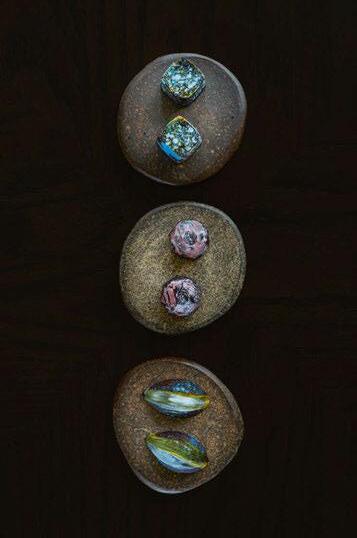
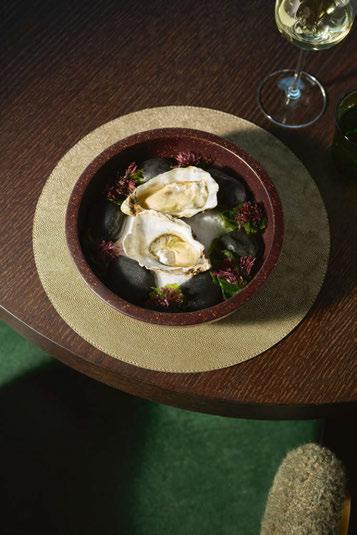

003 CONTENTS ISSUE 37 STARTERS Donna 038 Hotel Bella Grande Copenhagen Nox Beach Club 040 Hoiana Resort & Golf Hoi An De Mark 042 De Durgerdam Amsterdam Maya 044 Leven Manchester 054 044
Maya Edition at Kanai 046 Mexico Jara by Martín Berasategui 054 The Lana Dubai Café Carmellini 062 The Fifth Avenue Hotel New York
kitchens 068 The Emory London ©
076
MAIN COURSES The Riviera
abc
Natalie Chaban
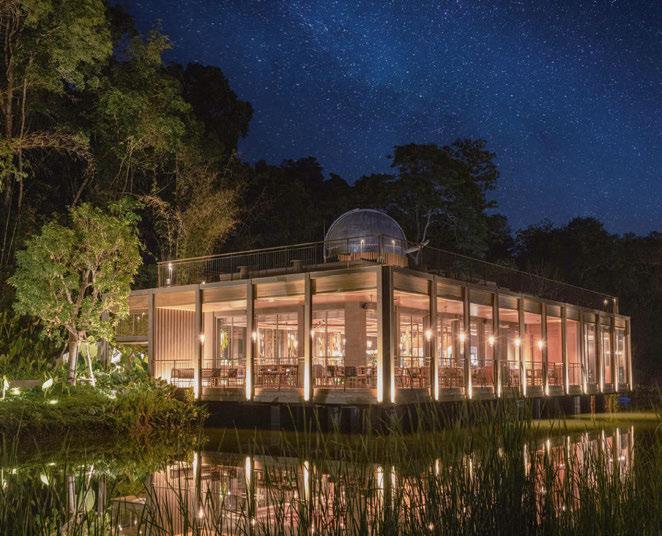

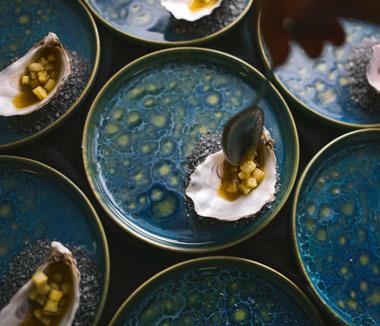
SERVICE
Chef’s Table
022
Portuguese chef Nuno Mendes, whose restaurant portfolio includes the culinary offering at boutique Porto hotel The Largo, shares some of his favourite food memories.
Going Global
024
Renowned British chef Tom Aikens has long extolled the virtues of cooking with seasonal produce: now, global hotel partnerships are presenting the chance to bring his sustainable philosophy to international diners.
Scoring the Hat-Trick
030
At the discreetly luxurious Parisian hideaway La Réserve, Chef Jerôme Banctel has garnered three Michelin stars for a cuisine that elegantly blends the enduring influences of his global travels with those of his Breton roots.
Redefining the Bar
036
Amidst the rapid evolution of the hotel bar, Edition’s Global Director of Bars Gates Otsuji discusses the importance of timeless design, creative agility and exceptional experience.
DINING
Plant Power
078
Vegan cuisine has taken root in the hospitality industry’s kitchens: now, select hotels are placing plant-based philosophies at the heart of their entire operations.
DIRECTORY
Head of the Table
101
Supper’s annual tableware guide equips decisionmakers with key information from market-leading suppliers, assisting in the specification process for new hospitality projects worldwide.
004 CONTENTS ISSUE 37
Entrée 015 Appetisers 019 Signatures 075 Cocktails 089 Drinks 093 Events 096 Petits Fours 098 Washing-Up 114 REGULARS © Chrzi 106 114 089
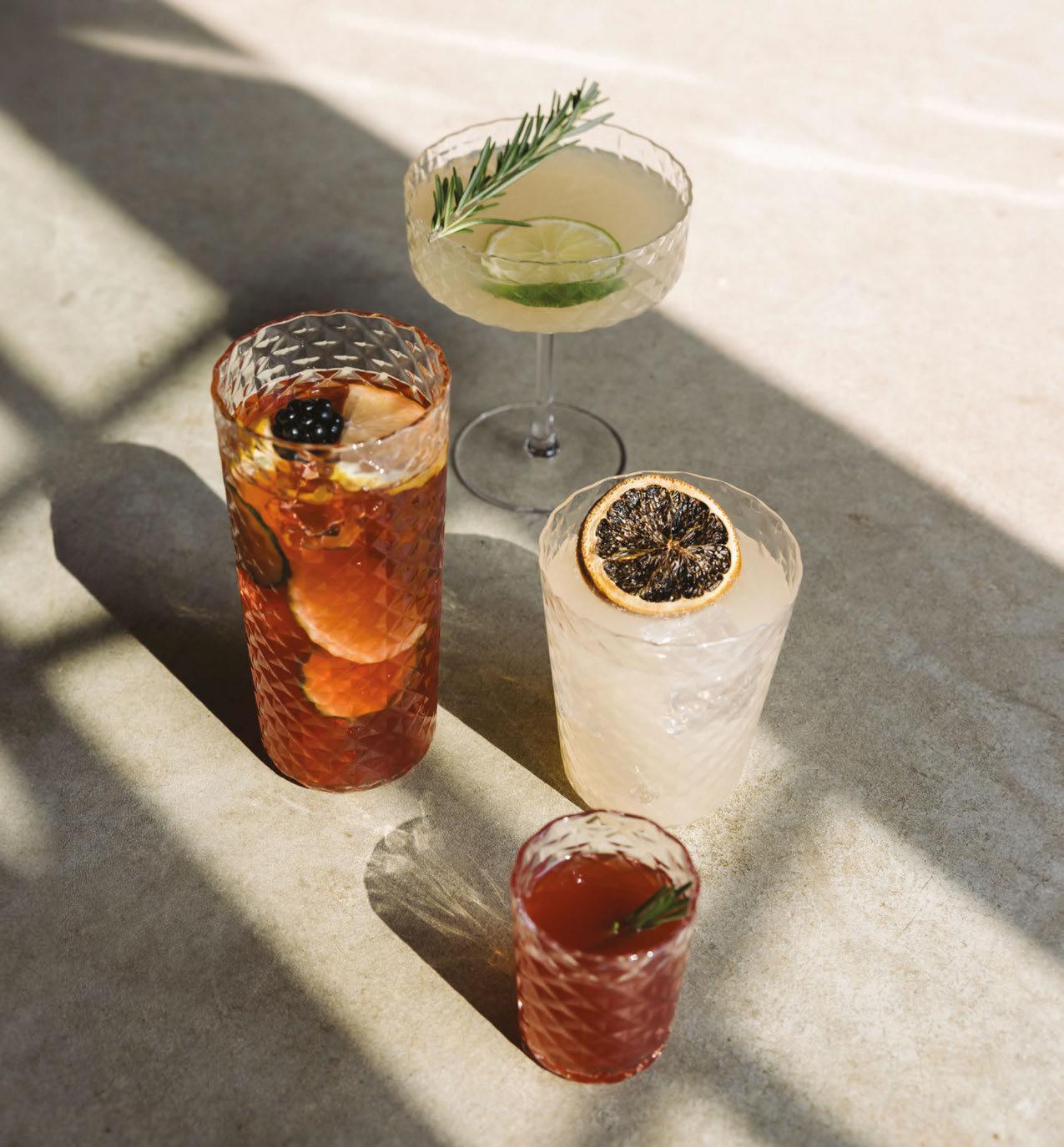
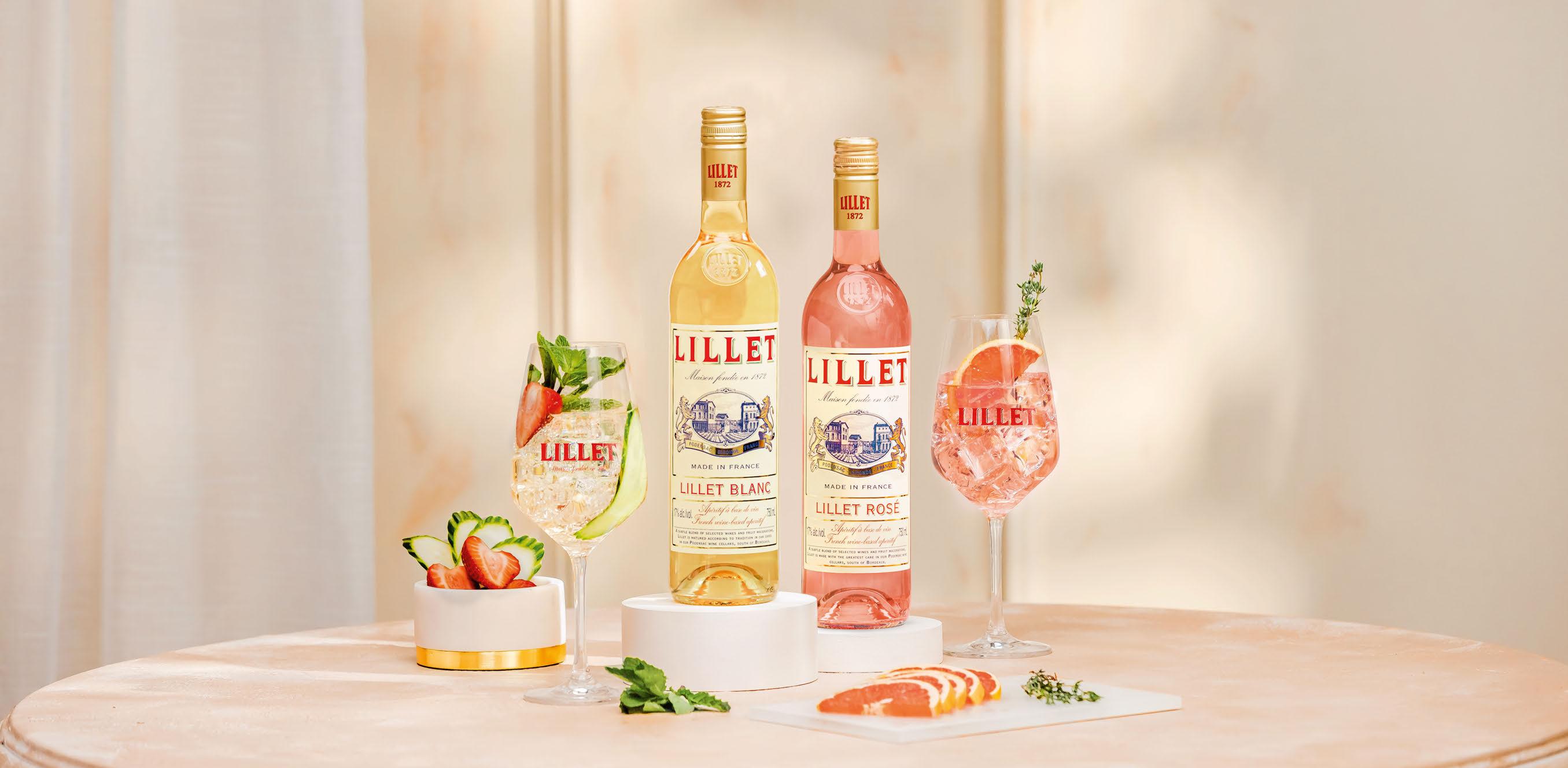

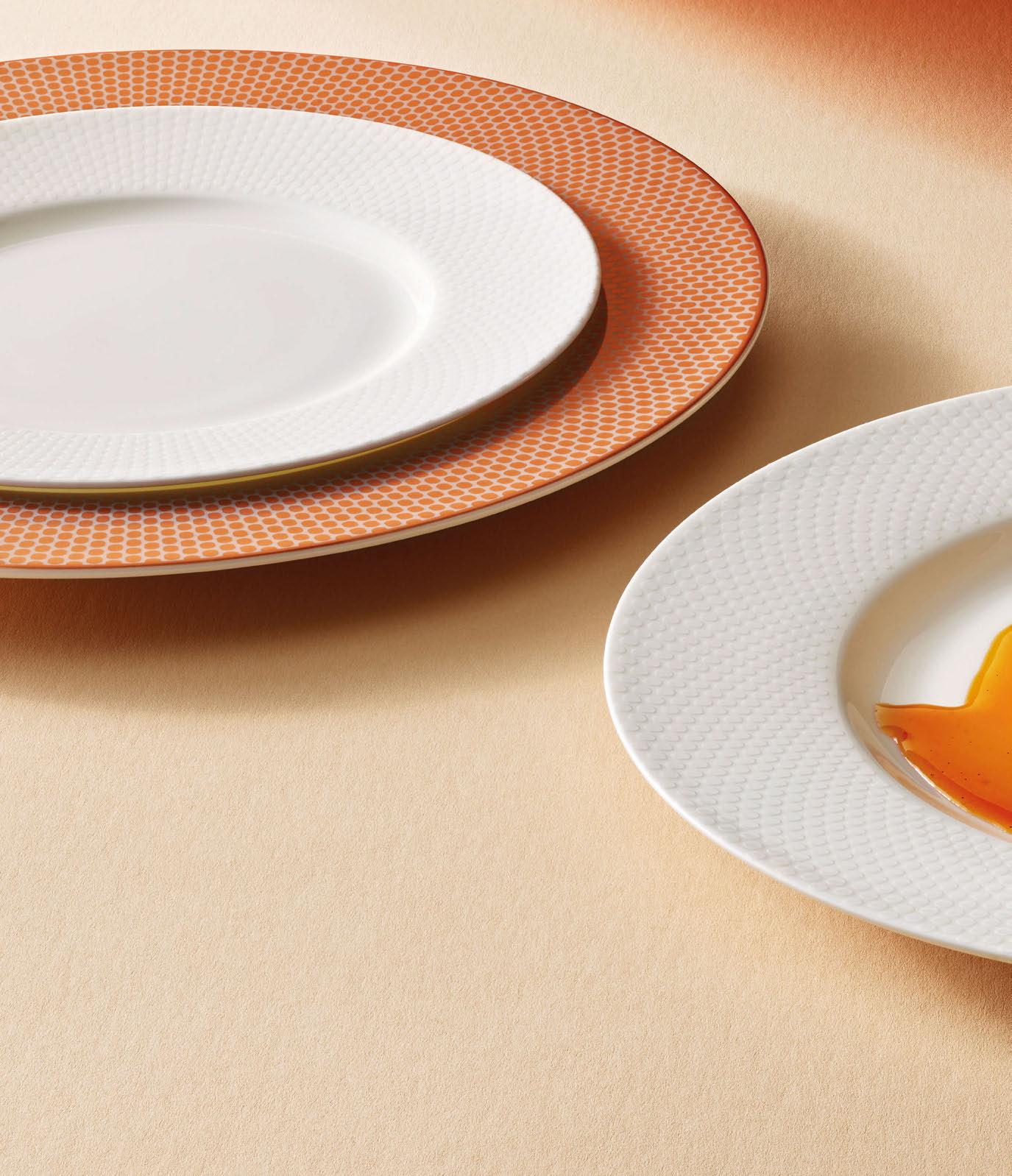
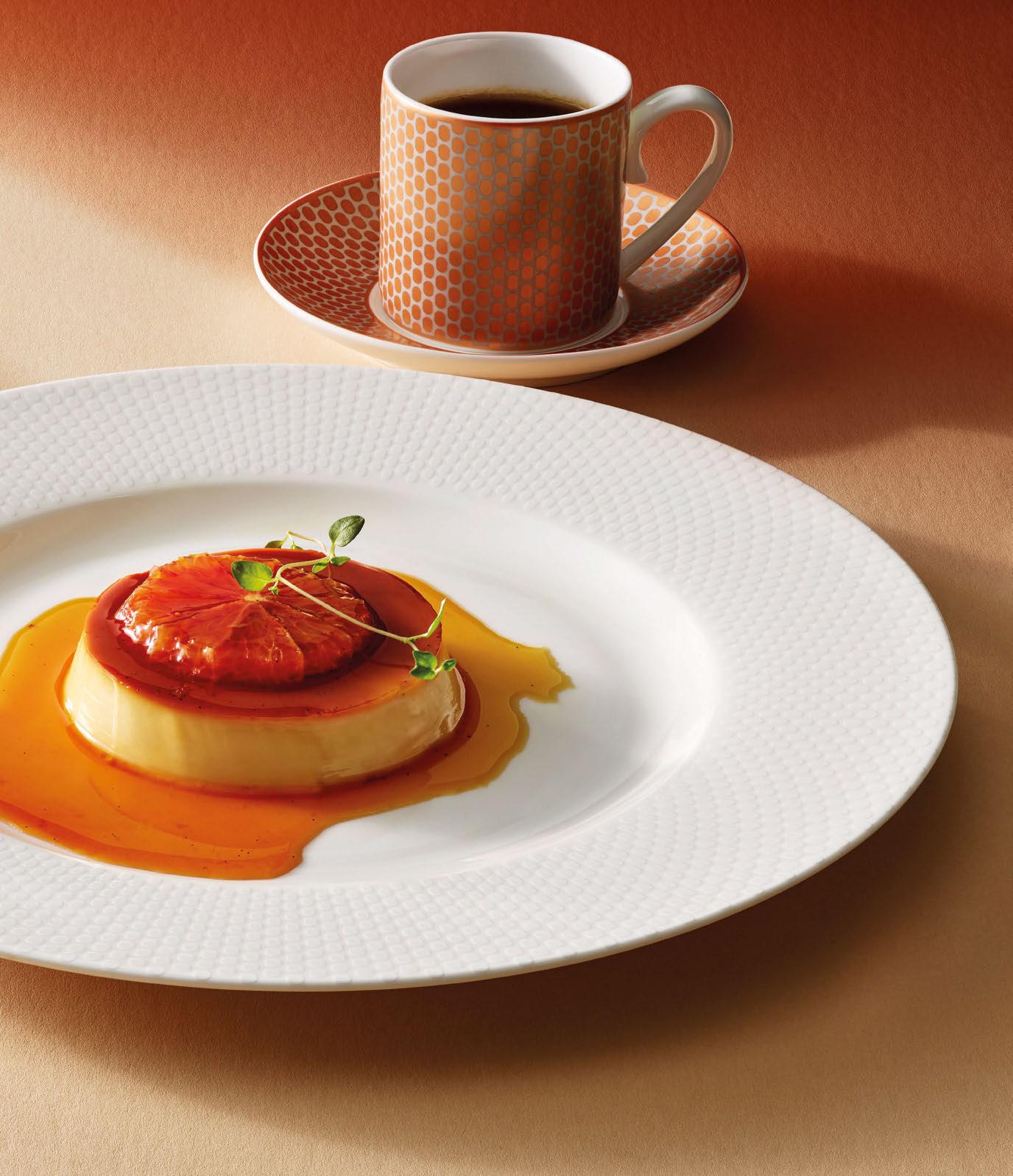


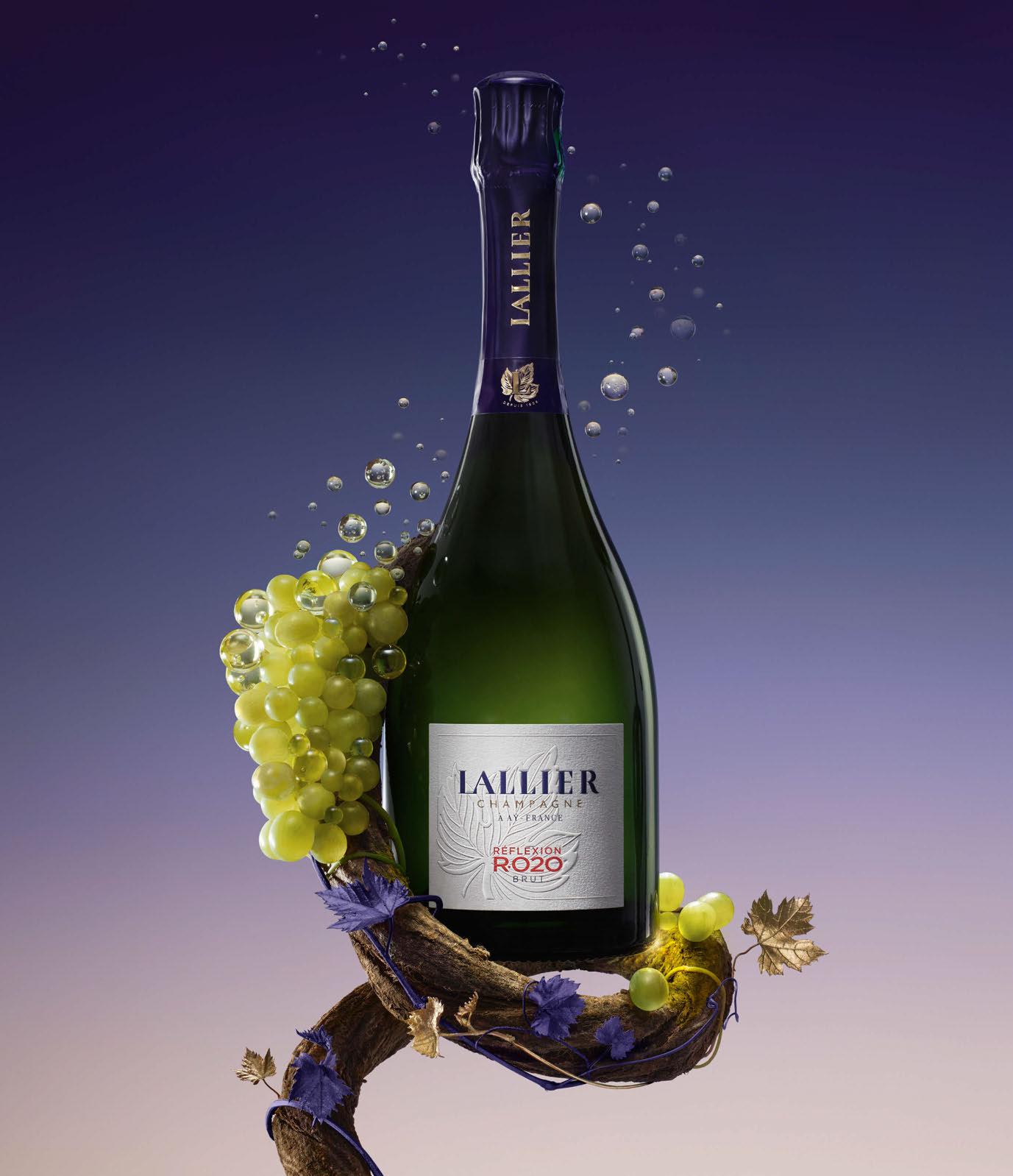
NAT U R E
S P A RKS OF



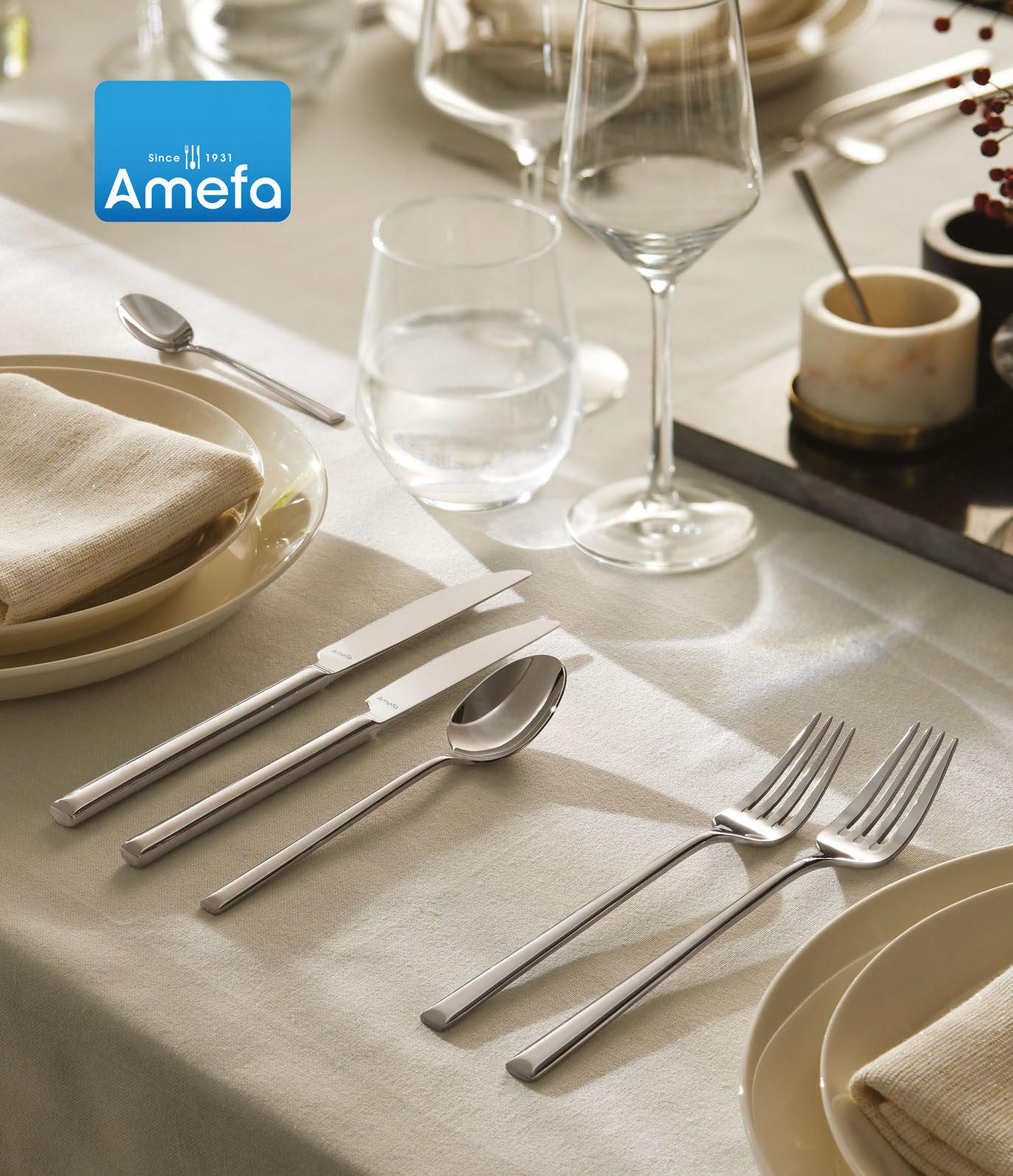


ENTRÉE

Back to Basics
Advances in technology have brought about all manner of revolutionary appliances for the professional kitchen, from automated smart ovens to state-ofthe-art ultrasonic processors for flavour extraction and emulsification. Some are designed to reduce manual labour and save time during a busy evening service, others have brought about new styles to elevate the art of gastronomy.
Yet there’s something to be said for going back to basics, employing the techniques used by our ancestors to prepare and cook food in the simplest of ways. It’s an approach that many of today’s chefs are turning to, with the belief that if fruits and vegetables are grown organically in the right conditions, they can be plucked from the ground and placed directly on the plate, garnished with fresh herbs and spices, without the need for heavily-processed sauces.
Ancient cooking techniques are coming back into operation too, with the likes of earth ovens, stone boiling and baking in ash gaining popularity around the world. Perhaps the most primitive is cooking over fire – a simple yet impactful technique that is being embraced by outdoor rural destinations as well as chefs in city centre venues. The flash of a flickering flame in the open kitchen is quite the spectacle, particularly when accompanied by the crackle of firewood, adding to the overall guest experience. Cooking with fire also brings an entirely different flavour to foodstuffs, a succulent smokiness that just can’t be achieved with electric.
Such practices have other benefits too. With soaring utilities bills, any processes that reduce the need for energy-guzzling appliances can only be a good thing, particularly with the introduction of eco-friendly fuels – some can even be made from food waste. Furthermore, there are opportunities
to incorporate ancestral cooking techniques into the programming, inviting guests to partake in building an earth oven, or gathering around the campfire for storytelling as their meal sizzles on the spit in front of them.
Many of these ideas have been showcased in the pages of Supper. Last issue, we ventured into the wild to experience hotel dining in the great outdoors, sampling a range of properties that are experimenting with foraging, farm-toplate and cooking over fire. And this issue, a number of chefs speak of the inspiration provided by their respective roots.
At Jara, a new restaurant within The Lana in Dubai, Spanish chef Martín Berasategui tells of his open-fire techniques that are typical of Basque cuisine. And at The Riviera Maya Edition at Kanai, Francisco ‘Paco’ Ruano favours simplicity in the preparation of his dishes, while Tomás Bermúdez employs ageold cooking techniques; the marinated octopus for example, is roasted on a mangal, while the sea bass zarandeada is cooked in the traditional Mexican way on the outdoor grill.
While many of us wouldn’t be without the inventions of modern-day life, it’s worth remembering that the key to success doesn’t always lie in innovative technology or futuristic gadgetry; there’s much to be learnt from looking to our roots and going back to basics. I hope you enjoy reading this new issue. Supper is served.
Catherine Martin • Managing Editor
015
ON THE COVER Café Carmellini, The Fifth Avenue Hotel New York
THE BRIGADE
EDITORIAL
Editor-in-Chief
Matt Turner m.turner@mondiale.co.uk
Managing Editor
Catherine Martin c.martin@mondiale.co.uk
Deputy Editor
Shanna McGoldrick s.mcgoldrick@mondiale.co.uk
Assistant Editor Eleanor Howard e.howard@mondiale.co.uk
Editorial Assistant Cara Rogers c.rogers@mondiale.co.uk
COMMERCIAL
Advertising Manager Rachel Chadwick r.chadwick@mondiale.co.uk
Account Manager
Marley Helme m.helme@mondiale.co.uk
EVENTS
Commercial Lead Kirsty Studholme k.studholme@mondiale.co.uk
Marketing & Events
Olivia Mavers o.mavers@mondiale.co.uk
RESEARCH & MARKETING
Content & Research
Ellie Foster e.foster@mondiale.co.uk
Data & Marketing
Lauren Blain l.blain@mondiale.co.uk
@SupperMag
DESIGN
Design Manager
David Bell
Production Jez Reid
CORPORATE
Accounts ar@mondiale.co.uk
Finance Director Amanda Giles
Chairman Damian Walsh
SUBSCRIPTIONS
Visit the online store to subscribe and save across all Sleeper Media magazines.



Subscription records are maintained at Sleeper Media. For address changes, email enquiry@sleeper.media. Supper (ISSN: 3033-4349) is published bi-monthly by Sleeper Media Ltd and is distributed by Spatial Global.
SUSTAINABILITY
Natural • Renewable • Recyclable
Supper is printed by Buxton Press on FSC Mix-certified paper using 100% vegetable-based inks. Magazines mailed from Spatial Global are packaged in FSC-certified wrap that is fully recyclable.
Strawberry Studios, Stockport, SK1 3AZ, UK Tel: +44 (0)161 464 4750 • www.sleeper.media
POWERED BY
PORTFOLIO
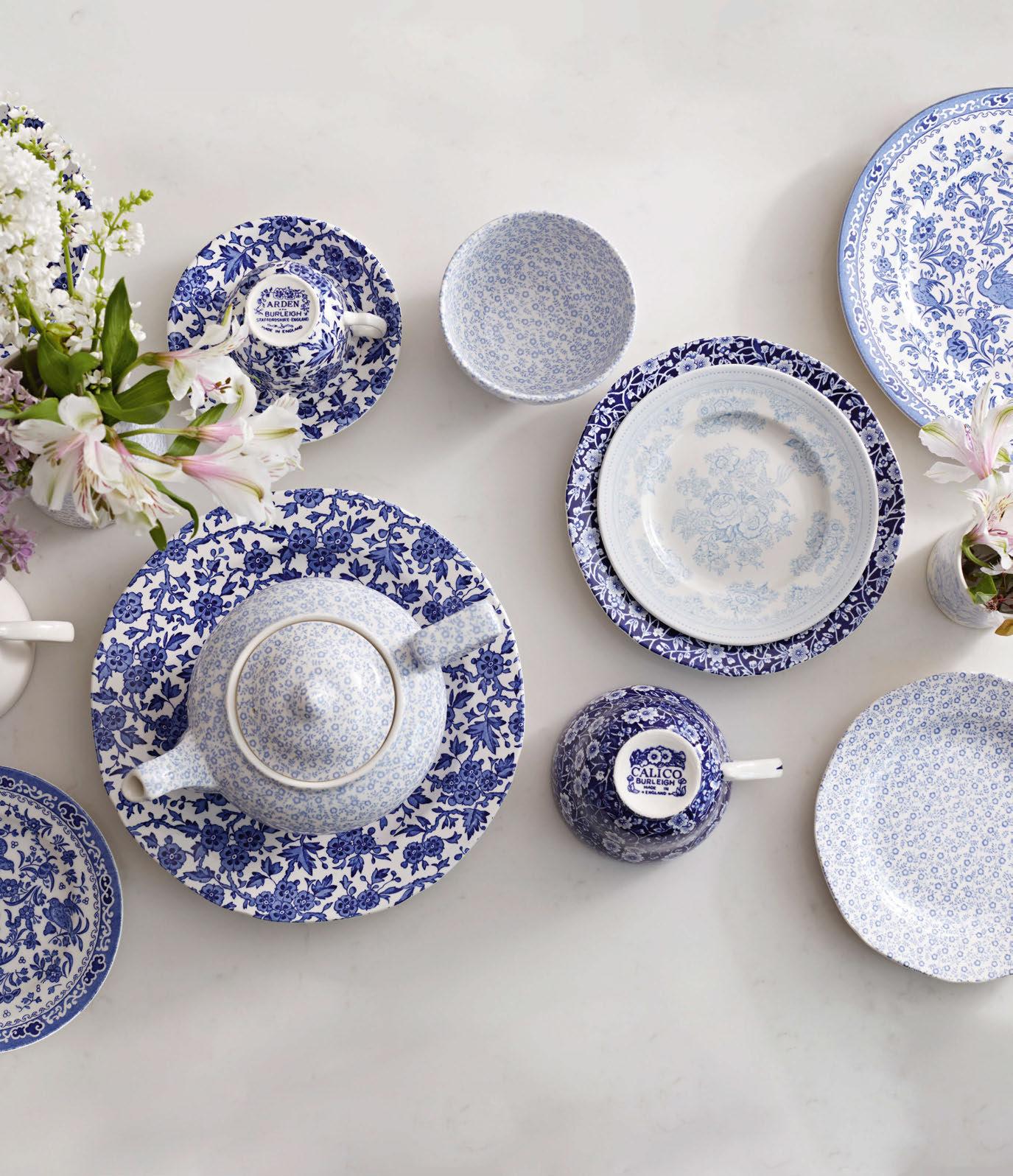
where the best of British ceramic design and craft manufacturing is protected
celebrated. burleigh.co.uk
Burleigh;
and


The importance of employee wellbeing in the hospitality sector has become a hot topic in recent years – and if the frequent reports of UK venues battling with staff retention issues are anything to go by, it’s clear that cultivating a culture of workplace satisfaction is critical for commercial success. Luckily there are plenty of businesses getting it right – and leading the way is Dorchester Collection UK, which was featured in The Sunday Times’ Best Places to Work 2024 list in May.
“This London-based hotel group opens doors for staff with a development programme covering everything from internships to leadership schemes, hands-on experience and opportunities to move around the business,” the publication
than 50, with 13% aged 55-plus. “It is beneficial to all of us to have this dynamic in our workforce,” she underlines. “Those with more experience can share their knowledge and expertise, including soft skills that they honed through the years in this business about people: they embody the timeless attributes of work ethic, commitment, loyalty, and the virtue of practice makes perfect, learning from mistakes.” She adds that the older generation also benefits from working with a younger cohort, observing: “Together they become more agile and collectively, they bring different perspectives on the importance of work-life balance.”
In the group’s F&B division, a responsive approach to flexible working requirements has
The People Policy Payoff
Following its inclusion on The Sunday Times’ Best Places to Work 2024 list, Dorchester Collection UK sheds light on its trailblazing approach to employee satisfaction.
wrote of the company, whose UK portfolio includes The Dorchester and 45 Park Lane in London and Coworth Park in Ascot.
So what’s the secret to the high approval ratings? “We create an environment where people feel safe and respected,” says Milet Lukey, Vice President People & Culture, Dorchester Collection, emphasising a six-pillar wellness strategy that addresses physical, social, financial, professional, emotional/mental and community components. Highlights include providing workers with complimentary nutritious daily meals at hotel sites, a 24-hour employee assistance programme and external partnerships offering services such as free and confidential mental health support. She also points to the importance of reacting to staff feedback, saying: “At all levels of the organisation, listening is key.”
The Sunday Times commended the group for its age diversity, deeming it one of the country’s best workplaces for people aged 55 and over. According to Lukey, 21% of the workforce is older
been particularly successful in helping to retain staff. “We have in many areas of F&B focused on shift patterns and taking a much more flexible approach and being more organised in terms of planning requests for leave such as annual leave, days off and birthdays off,” says Richard Newell, Director of Food & Beverage at The Dorchester. “The four-day working pattern was something we launched in areas of our business last year, which has been incredibly successful and well received by our colleagues.”
Providing a clear pathway for professional growth is also important: the company offers robust training and learning opportunities for all levels via its Dorchester Collection Academy, a bespoke learning and coaching consultancy, and partners with reputable educational bodies to supplement its internal programmes. “Career development should be a focus for all of us; it is fundamental to nurture and grow our teams,” concludes Newell. “It is these people who are the future of the hospitality industry.”
019
APPETISERS

Hilton’s Space Cookie Touches Down in US
The first chocolate chip cookie to be baked aboard the International Space Station (ISS) has returned to base – landing at the National Air and Space Museum in Virginia, US.
The sweet treat is the result of a 2019 interstellar experiment that saw DoubleTree by Hilton become the first hospitality company to participate in research aboard the ISS, as part of an initiative to make long-duration space travel more welcoming and hospitable. The hotel behemoth teamed up with Zero G Kitchen, which creates appliances for microgravity use in longduration space flights, and Nanoracks, a global leader in commercial space exploration, on the ambitious project.
Sending DoubleTree’s signature snack into orbit made perfect sense, according to Shawn McAteer, Brand Leader, DoubleTree by Hilton. “Hospitality and innovation are two strands of Hilton’s DNA, and we are beyond honoured to be the first hospitality company involved in
historic research aboard the International Space Station and to now have the DoubleTree cookie on display in the Smithsonian,” he says.
“We are thrilled to display DoubleTree by Hilton’s chocolate chip cookie as the firstever food baked in space by astronauts,” adds Dr Jennifer K. Levasseur, Museum Curator, Department of Space History, National Air and Space Museum. “Innovations like baking could make even longer duration missions in space much more enjoyable, and sustainable, so DoubleTree’s historic space cookie is a natural choice to represent this development in the Udvar-Hazy Center’s display of space food.”
The cookie is being stored in an air-tight exhibition box at the museum’s F. Udvar-Hazy Center, where it will form part of a new exhibit, ‘At Home in Space’, scheduled for 2026. Hungry visitors, however, can pick one up at DoubleTree by Hilton Hotel Sterling – Dulles Airport, less than 15 minutes from the museum.
London’s Best Brunches
Ever wondered what makes the breakfast pancakes at The Savoy taste so good? Or how to master the technique behind Claridge’s famous vanilla brioche? Enter Brunch in London, a brand-new cookbook from the Australian-based food charity One Plate that spills the secrets on how to recreate some of the UK capital’s beloved brunch dishes at home.
Featuring more than 100 recipes from the city’s most renowned spots for epicurean exploration – including the classic grande dame hotels The Ritz, The Goring and The Dorchester – Brunch in London showcases the rich and flavourful diversity of the British capital’s daytime food scene. Acclaimed chefs Heston Blumenthal, Yotam Ottolenghi, Jamie Oliver and Angela Hartnett have also contributed to the tome.
A follow-up to the highly successful Brunch in Melbourne, all profits from the sales of Brunch in London will help to fund One Plate’s mission to improve sustainable food security for children across the Philippines, Cambodia, Kenya, Rwanda, Tanzania and Uganda. The charity aims to help communities in Africa and Asia break the cycle of hunger via various initiatives such as agricultural education, community gardens, farms and access to clean and nutritious food.

020 APPETISERS
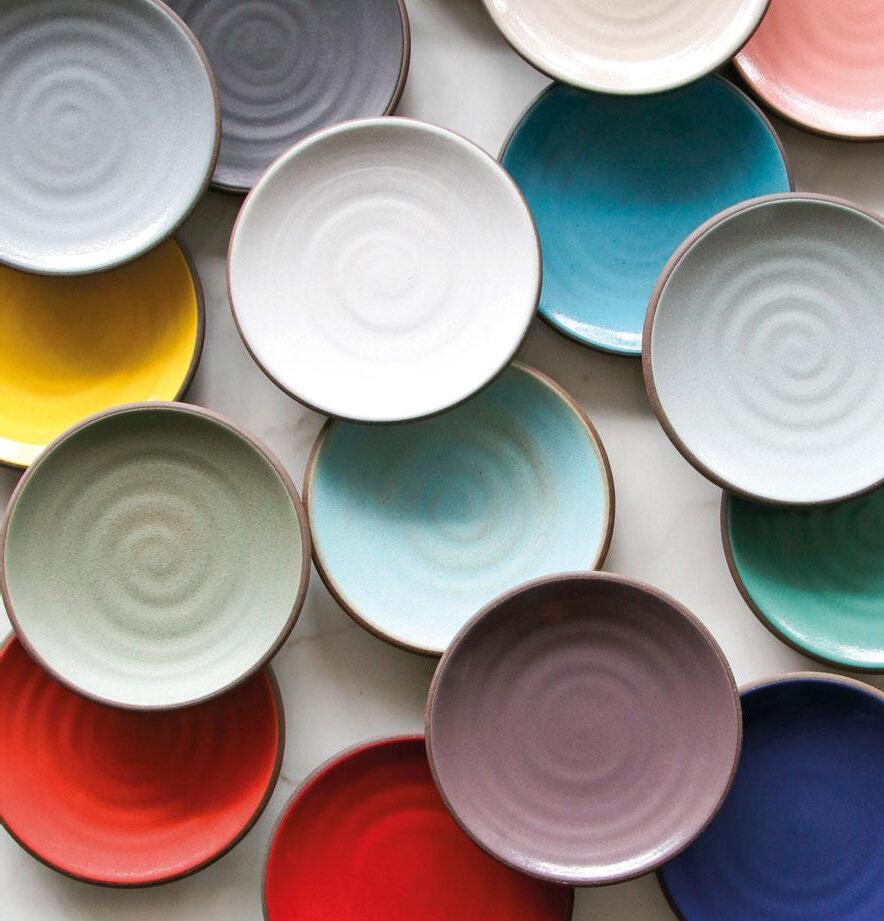
Making the world a better plate. Timeless. Durable. Handmade. Trusted by the world’s best chefs. JONOPANDOLFI.COM/SUPPER
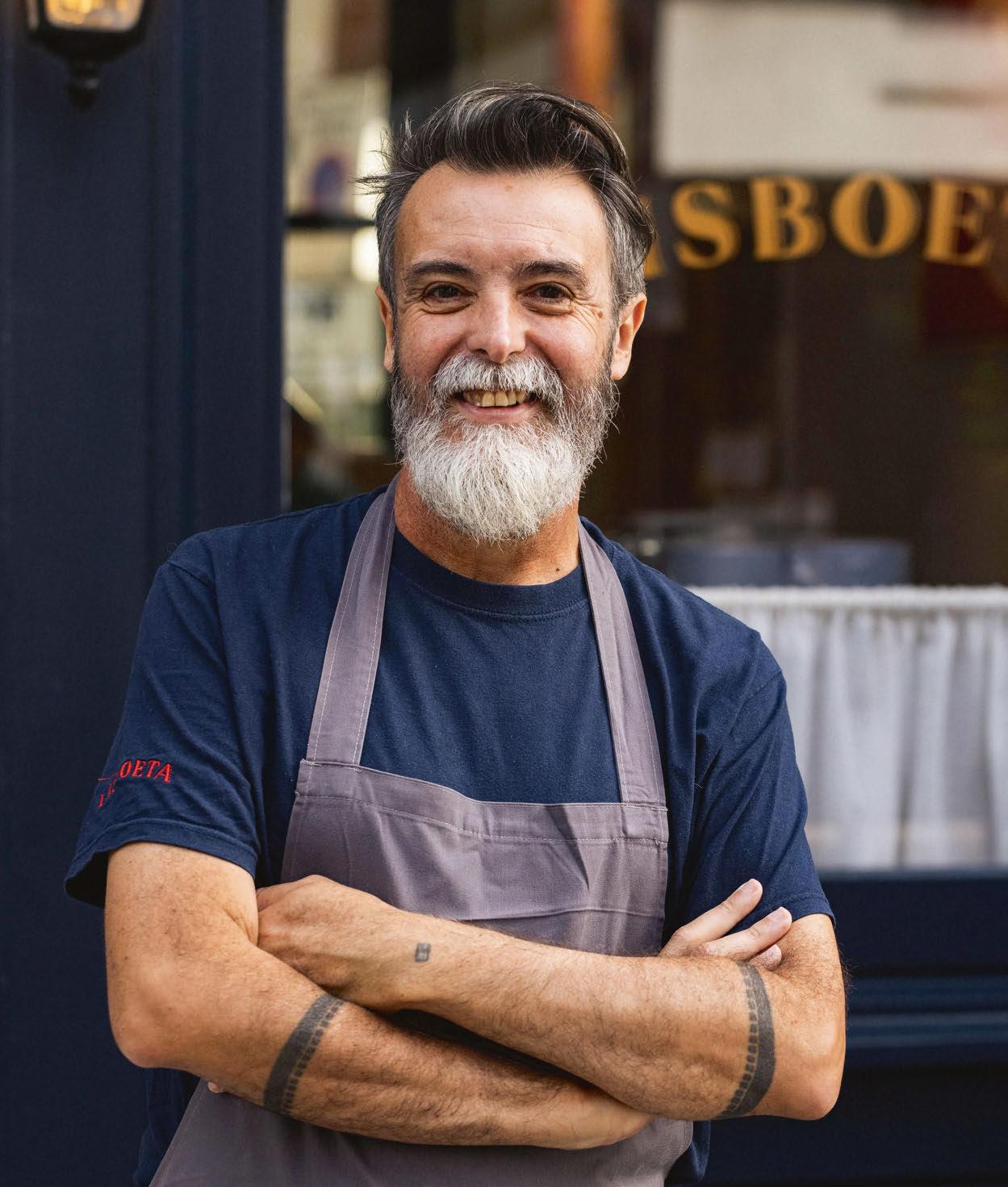
© Joe Harris
CHEF’S TABLE
Nuno Mendes
The Portuguese chef, whose restaurant portfolio includes the culinary offering at boutique Porto hotel The Largo, shares his favourite food memories.
When did you first fall in love with cooking?
I fell in love with cooking when I was lured to my grandmother’s kitchen in Porto by the amazing smells. From the age of four or five I would sit there for hours… watching, smelling, tasting, learning and helping.
What’s your favourite hotel restaurant?
Cozinha das Flores at The Largo, Porto… sorry! It’s fully immersed in the city but it still aims to meet the high expectations of our guests.
Which chefs have inspired you?
So many: Wolfgang Puck, Mark Miller, JeanGeorges Vongerichten, Andoni Luis Aduriz, Ferran Adrià, René Redzepi, Maria de Lourdes Modesto and, of course, my grandmother.
Who is your favourite person to cook for?
I have fun cooking for friends when they visit. I push myself to go further, to do something different – something new and personal. I love it, especially if I’m put on the spot and they arrive with no notice. I love the challenge.
How often do you dine out?
Not very often these days – between work and family commitments I find it hard to make time for proper dining. There are many wonderful places to visit in London and around the world, but I just haven’t been able to visit them. It’s funny that most of the young chefs I work with have been to more places than I have recently! On a positive note, it makes those rare experiences much more special and I am a lot more selective about them.
Which new restaurant are you eager to try out?
Ikoyi in London, Boragó in Vitacura, Chile and Pujol in Mexico City. I’d also like to try Asador Etxebarri in Spain.
Are you an easy going or a demanding restaurant customer?
The easiest, I think. I keep to myself and like to follow suggestions from the team – it’s their house, so I’m always happy to take their advice. If I see that the team members aren’t passionate or don’t care about what they are doing, I won’t return. I don’t complain and I don’t leave reviews, I just don’t go back.
Restaurant dining or room service?
Restaurant dining!
Where do you get the creative inspiration for your dishes?
I’m inspired by a combination of travel memories, tradition and product. Mixed with a bit of technique, both old and new.
What’s your favourite dish?
Hmm… I have so many cravings! But probably something Japanese and Portuguese.
And your favourite drink?
An apple and sorrel juice, served with iced sparkling water.
Which city is food heaven for you?
Tokyo, San Sebastián and Paris. Lisbon is getting there as well!
Tell us about your most memorable meal.
Two fine-dining experiences stand out: Noma (Copenhagen) in 2008 and Mugaritz (San Sebastián) in 2006. Both were incredible in their own way, with two teams pushing hard to define and assert themselves. They were magical and connected at the same time –fully immersive experiences that really took me on a journey. The team, the place, the energy, the stories, the sparkle in the eye of everyone there all made my first visits to each place memorable. I’ve gone back to both since then and the meals have still been very inspired – but the first time couldn’t be beaten.
Sweet or savoury?
Savoury.
Healthy dishes or full-fat indulgence? Healthy!
Which cookbooks can we find on your shelf?
I stopped buying cookbooks when I had children so my shelves are not that full anymore – just some old stuff.
What’s your go-to cooking soundtrack?
Some old Nick Cave, Tom Waits, Old Sonic Youth, early Leonard Cohen, or maybe the Japanese band Mono if I don’t want lyrics.
It’s a Sunday evening at home with the family: what’s on the menu?
Japanese rice, seaweed, and maybe a dish of minced pork with vegetables, fragrant herbs, fried garlic and ginger. Good home cooking.
023
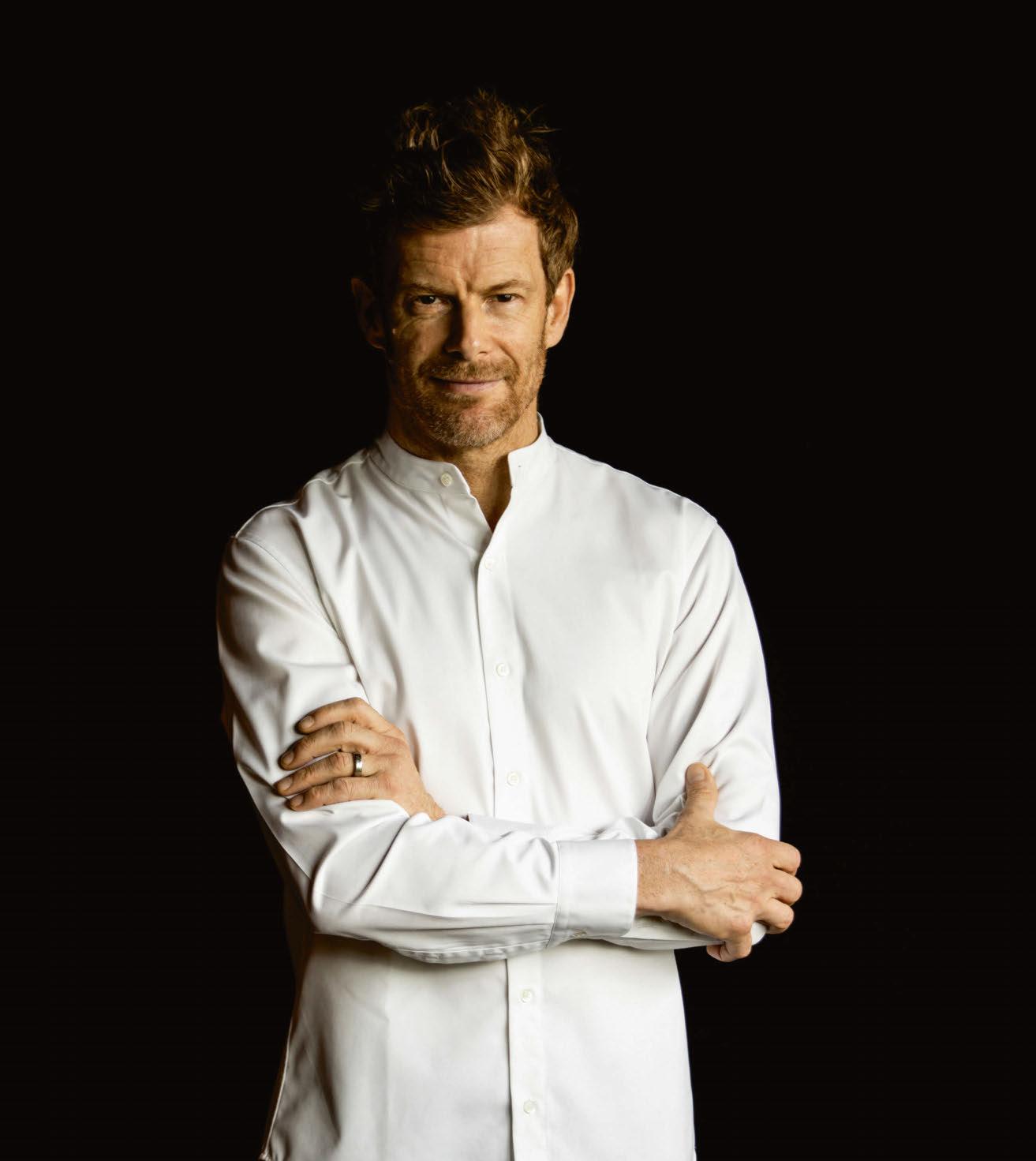
Going Global
Renowned British chef Tom Aikens has long extolled the virtues of cooking with seasonal produce: now, global hotel partnerships are presenting the chance to bring his sustainable philosophy to international diners.
It’s one of the first warm spring days of the year in London, and at Tom Aikens’ restaurant Muse – a charmingly diminutive townhouse in chic Belgravia – the curtains are half-drawn against the afternoon sun.
The dining room is gently stewing in the delicious smelling fizzings and bubblings emanating from the open kitchen, and in the middle of it all is Aikens himself, ordering a blender over the phone.
As one of the UK’s most eminent chefs, Aikens has worked with the industry’s greats, including Pierre Koffmann and Joël Robuchon.
Catapulted to fame at the age of 26, when he became the youngest British chef to receive two Michelin stars during his time at London’s Piedà-Terre, he went on to open a series of venues ranging from fine dining to more casual spots.
Throughout it all he has remained faithful to his guiding principles of seasonal, sustainable ingredients; a philosophy instilled in him by his mother, whose passion for home-grown produce shaped his childhood, much of which was spent gardening and cooking in Norfolk.

“Seasonally driven, tasty and delicious” is how Aikens describes his cuisine today. “I think the whole point of coming to a restaurant is to have something that is in season but that is also intriguing, interesting, exciting; something a bit different,” he says. His creativity involves pushing boundaries, but never at the expense of the guest’s experience. He asserts: “I don’t think a restaurant should ever be challenging in effect of questioning certain flavours.”
At the Michelin-starred Muse, Aikens has crafted a fine-dining menu inspired by nostalgia, drawing on pivotal moments and key people from his personal life and career. This intimate approach is echoed in the design of the restaurant, which, with its eclectic mix of furniture and lighting and fully openplan theatre kitchen, feels like sitting in a sophisticated living room. He also likes to use completely different tableware pieces to serve each course, explaining: “It just keeps the intrigue and excitement going all the way through until the end.” The dishes themselves are accompanied by anecdotes and memories
SERVICE
Words: Shanna McGoldrick • Portrait Photography: © Hiro Kimura

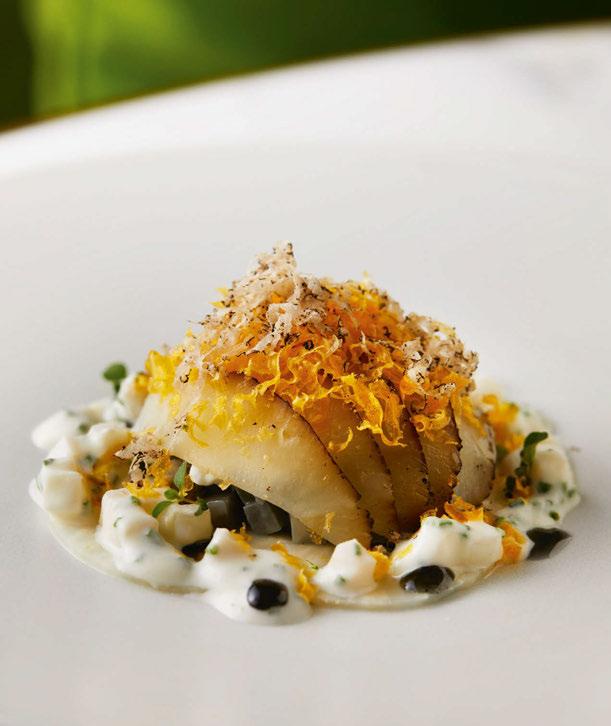

© Courtesy of Edition
that shed light on his expansive experience – a scallop, kombu and turnip combination, for example, comes with a description that recalls the ritual of prepping scallops at La Tante Claire in London. ‘Pierre Koffmann made us prep over 100 scallops outside each day because it was easier, however the cold made us prep much faster than normal so we could get back in the warmth as soon as possible’, the menu reads. In recent years Aikens has also perfected the art of the hotel restaurant, collaborating with corporate outfits such as Langham Hospitality Group and Edition to open multiple international venues that have successfully exported his brand of stripped-back, technical cooking to global diners. His current portfolio includes Tom’s by Tom Aikens at The Langham Jakarta, which was established in 2021, and The Jade Room at The Tokyo Edition Toranomon which opened to much fanfare in 2022. Tom’s is described as a ‘premium casual’ concept that centres on classic European cuisine, blending both British and French influences and offering an à la carte Gueridon service of meat carvings, burrata and various desserts, with a focus on the best cuts of meat and fresh, seasonal seafood. Meanwhile, The Jade Room – and its offshoot outdoor space, Garden Terrace – represent a delicate balancing act between the refined elegance of Japanese culture and Edition’s affinity for subverting the status quo. Its menus combine contemporary Japanese and Westerninfluenced dishes that evolve seasonally, with highlights including squid consommé with yuzu, chicken and confit lemon, as well as mackerel with dashi, sesame, daikon and furikake. At Garden Terrace, the small plates on offer include lobster roll with sudachi spiced mayo, nori and fried cabbage, as well as more international-leaning dishes like housemade ricotta with pickled beets and schezwan cucumber. A seasonal cocktail menu focuses on collaborations with local botanical distilleries, resulting in a series of bottled cocktails unique to the venue.
An avid forager with an unwavering commitment to seasonality, Aikens has long championed using small growers and suppliers in his culinary ventures, leaning on
“The exciting part of being a chef is that you’re always coming into contact with the possibility of trying something new.”
partners based throughout the UK at Muse. “We are very fortunate in this country to have such an amazing group of suppliers and producers that really care about what’s being produced and how it’s being produced,” he says. “I don’t think there’s ever been a better time for chefs to have such great produce.”
In Jakarta and Tokyo, too, provenance drives the menus, which adapt in response to seasonal availability. So how does he protect his philosophy and approach to sustainability when working with global hotel operators? Though corporate frameworks might not allow limitless freedom when it comes to selecting producers, he points out that there are benefits to the processes put in place by hotel groups, adding that he chooses his overseas partners carefully, bearing their in-house environmental ethos in mind. “In Tokyo we work with some amazing suppliers, so that is not really that much of a concern,” he explains. “You won’t be able to have tiny little vegetable growers or individual fish suppliers – it’s just not going to happen. But you do have the guidance and the assurance and the quality aspect that remains, working with a hotel.” Of course, operating in one of the biggest culinary capitals in the world makes things more straightforward. “The quality of the produce is second to none; it’s truly remarkable,” he says of Japan.
Aikens was drawn to working with Edition in part because of the consistency and the quality that he believes runs through all Marriott brands. “The key focus is on delivering really exceptional food experiences in terms of the restaurant, the service and the décor,” he says. “It’s very interesting to work within that forum of people that are really focused on that.” As for teaming up with The Langham, he cites the lure of travel and adventure as one of the main drivers for the partnership. “The exciting part of being a chef is that you’re always coming into contact with the possibility of trying something new,” he says. “Indonesia and Jakarta are very interesting markets – and the hotel itself is beautiful.”
Both his dining rooms in Jakarta and Tokyo are visually arresting design statements: while Tom’s channels the
027 SERVICE
The Jade Room’s dishes balance the refined elegance of Japanese culture with Western-influenced flavours
“I’m always looking at doing possible new hotel partnerships.”
nostalgic elegance of European craftsmanship, featuring Italian mosaic flooring and old-world chandeliers, The Jade Room’s bold jewel green colour scheme, bamboo oak trees and largescale paintings by artist John Jackson make for a luxurious environment. “At the end of the day, it’s not always just about the food, it’s about the whole experience,” acknowledges the chef. He would, he says, be open to spearheading additional venues in Asia, mentioning his love of Vietnam, Cambodia and Thailand in particular, and though he won’t be drawn on the specifics he does have a few hints to drop.
“I’m always looking at doing new possible hotel partnerships, because at the end of the day it’s what I love doing; going into interesting and intriguing countries, cities and destinations and working with like-minded people is always good fun,” he admits. Collaboration also offers an ideal means of breaking into new and unfamiliar markets. “For me, it’s a great way to be able to go into another country overseas, to experience the culture, the different cuisines,” he says.
“Working with different operators is always very interesting, and because of the way that the structure of a hotel is run, everything is very well thought through, it’s very well organised. There are no real mysteries; everything is very clear from the offset.”
Though Aikens has amassed a wealth of accolades throughout his career, he maintains that the allure of the Michelin star never fades. “I’d definitely like to see us try to get to two stars,” he says of Muse. “It’s important to us to progress and to keep being ground-breaking in what we do and benchmarking against what we’re doing year on year and to always try to make significant improvements.” Elsewhere, his vision for the future includes exploring the option of working with his twin brother Rob, who is also a chef.
How does he keep all the plates spinning?
“Chefs are busy people and we’re motivated by seeing how much we can take on and how much we can do,” he offers. Then, with a grin: “I don’t sleep much!”

028 SERVICE
The Jade Room and Garden Terrace opened to much fanfare at The Tokyo Edition Toranomon in 2022
© Nikolas Koenig

BHSTABLETOP_HOMEOFTABLEWARE NEW TREND: QUIET LUXURY A BRAND OF BHS TABLETOP AG. • WWW.SCHOENWALD.COM

Scoring the Hat-Trick
At the discreetly luxurious Parisian hideaway La Réserve, Chef Jerôme Banctel has garnered three Michelin stars for a cuisine that elegantly blends the enduring influences of his global travels with those of his Breton roots.
Words: Nicola Leigh Stewart • Portrait Photography: © Julie Limont
If you asked Jérôme Banctel what he wanted to be when he grew up, he’d probably mention football before food. The eminent French chef, like many of his contemporaries, was raised on home cooking and name-checks his grandmother as an influential figure throughout his childhood, but working behind the pass was never the plan – until he copied a friend’s career move as a teenager, kickstarting an illustrious career in gastronomy. The rest, as they say, is history.
“I didn’t want to be a chef at all,” underlines Banctel, who was awarded a coveted third Michelin star earlier this year for the exclusive Parisian restaurant Le Gabriel, catapulting him to the higher echelons of the French culinary sector.
“I wanted to be a footballer. But I decided to follow in the footsteps of my best friend who was heading into the hotel and catering business.”
Four years of training at a hotel school in his native Brittany followed, before he joined the kitchen brigade of fellow Breton Michel Kéréver at the two-Michelin-starred Le Duc d’Enghien near Paris. “I was very young at the time and I was fascinated by my first experience in the kitchen,” he says. “I admired the excellence, the rigor, the discipline – to give pleasure, to create. I loved it. Monsieur Kéréver immediately got me interested. That’s what fascination is all about!”
Indeed, he went on to follow Kéréver to the (since shuttered) Vreugd en Rust in the Netherlands – an unusual country of choice for a French chef but the first of many overseas adventures – before moving to Paris in 1993 after completing his military service. The kitchens that followed
read like a who’s who of French gastronomy: Banctel spent a few months at the Jules Verne with Alain Reix before heading to what was then Les Ambassadeurs at the Hôtel de Crillon, where Christian Constant was at the helm. In 1998, at just 27 years of age, he joined l’Ambroisie – his first three-Michelin-starred restaurant – as a sous-chef under Bernard Pacaud. His eight years at the venue came to an end when Alain Senderens offered him the job of executive chef at Lucas Carton on Place de la Madeleine, which he had restored to its three-starred glory. His next career defining moment came while he was working as chief consultant for the hip yet casual Mama Shelter brand, when he crossed paths with hotelier Michel Reybier. Banctel was ready for a new challenge: Reybier mentioned that he was in the process of opening a hotel in Paris.
Discreet and luxurious, La Réserve Paris opened its doors in the city’s charmed eighth arrondissement in 2015; the third property in Reybier’s small portfolio of La Réserve hotels. Banctel was handed the reins of both the signature restaurant, Le Gabriel, and the contemporary eatery La Pagode de Cos. Just one year later, the former shot straight into the Michelin guide with two stars.
Banctel credits his mentors for their enduring influence in those early days. “The cuisine has completely changed since the hotel opened,” he says. “When I arrived at Le Gabriel, I’d been working for 20 years behind great chefs, so I was a bit Jérôme, a bit Bernard Pacaud, a bit Alain Senderens. It took me two or three years to free myself from the others and to really do what I wanted to do. Maybe it’s age, but now I know what I want and what I don’t want: I want to cook
SERVICE 031



© Julie Limont
Julie Limont
©
Banctel
cleanly, precisely, technically – with acidity, boldness and taste. Now, it’s 100% me.”
This self-expression has resulted in a cuisine that has evolved to blend his Breton roots with idiosyncrasies picked up during his extensive international travels. “It’s a kind of cuisine that’s based on two aspects,” says Banctel. Produce from his native Brittany lies at the heart of his culinary output – particularly seafood and shellfish, with tuna, mackerel lobster, octopus and abalone all featuring on his menus, either past or present, at some point. Meat is also a stalwart, particularly in the winter, when he loves to experiment with a hunting menu. And of course, everything is complemented by seasonal fruit and vegetables, with standout dishes including artichoke heart with sakura vinegar, and green asparagus with seagrass. “We change products as we go along,” he explains of his responsive approach to cooking with fresh produce. “Some go, some come back. There’s no date. There are four seasons, that’s for sure. So there will be four movements, but there’s no timing. When the product is no longer there, we stop.”
The chef’s travels across Europe – particularly Spain and Turkey – can also be felt in the dishes that make up his menus. One major source of international influence, however, comes from slightly further afield. “It’s 200% Japan,” he says. “There are a lot of touches; miso, koshō, yuzu, vinegar, white soy sauce... But it’s very subtle; it’s not Japanese cuisine. In other words, I get products from Japan and I use them in my own way.” As an example, he points to an intriguing dish that features a suckling pig from Spain, imbued with Japanese flavours and cooked using Vietnamese culinary techniques. “I work a lot with a Vietnamese woman and we’re going to blow the skin off; make it with a Vietnamese-style rice, a little gratin, a tamarind sauce,” he elaborates. “Then we’re going to use
“Maybe it’s age, but now I know what I want and what I don’t want. I want to cook cleanly, precisely, technically –with acidity, boldness and taste. Now, it’s 100% me.”
all the tomato juice from several different tomatoes. I’ll add a little Thai basil at the last moment and a little yuzu and koshō to liven things up. I like it when the tastes are very strong – almost unbearable because it’s so strong. I like cooking with character.”
There is also, arguably, a third aspect that defines Banctel’s cooking (perhaps inspired by these travels to Asia) and that’s his use of acidity. French cuisine is largely built on the foundation of its sauces, which can be notoriously butterheavy, but Banctel takes a lighter, more contemporary approach to his dishes. “There’s always a little acidity, and the sauces have no butter or cream,” he reveals. “We work a lot with emulsions: with juices like carrot, artichoke or celery, for example, and we emulsify them so that they have a consistency as if they had been mixed with butter, but there’s no butter or oil. It’s really very light stuff. It’s a cuisine with a strong sense of identity and singularity, and it’s very much like me. Nowadays, when you see my dishes, you think it’s me.”
The kitchens of Le Gabriel have certainly allowed Banctel to define his personal culinary style, providing the backdrop to nine years of innovation and hard work, during which, he admits, the ultimate goal always remained winning the prestigious and elusive third Michelin star. That period of time, he says, “felt very long” and he is unsure of why the honour was finally bestowed this year. “Michelin doesn’t give an explanation,” he explains. “We don’t know if there is a scale that they use, or why today, or why not.” Covid – or more specifically, France’s long and numerous lockdowns – might have played a role in the breakthrough. Like every other restaurant across the country, when the pandemic hit, Le Gabriel was forced to abruptly close its doors without knowing when it would reopen again. What this gave Banctel was time to reassess his vision and de-clutter. “We had to
033 SERVICE
uses acidity to take a light, contemporary approach to haute cuisine
rethink how we were going to work,” he says. “I really pared things down. Before, I had a kitchen where there was too much stuff. So like the Japanese, I got rid of everything that serves no purpose in order to focus on taste. I worked on the menus and I said that firstly we had to focus on the food, and secondly, we had to focus on the story.”
These stories are told through two new menus at Le Gabriel: Virée, which is rooted in his Breton origins, and Périple, which tells the story of his many travels. “In Virée, I brought everything that comes from Brittany, my memories, my produce, my desires,” he says. “So it’s a bit like my 0 to 17 years, it’s all the years I spent in Brittany. And then there’s the Périple menu. Thanks to Covid, we weren’t allowed to travel anymore, so Périple was a bit like immobile travel; it’s longer, it takes more time, there are more dishes. It’s also a cuisine that’s a little more international in taste, but still French in style.”
With just ten restaurants in Paris holding
three Michelin stars, Banctel has now joined the most exclusive culinary club in the gastronomic capital of the world: there is no higher accolade. So, what professional milestone will he strive for next? “That’s a good question; I’ve got plenty,” he says, “One: keep them! Two: move on, create something new, do something else, a new challenge, a competition perhaps.”
It may also take some time for the significance of his success to sink in. “I’ve got the third star, but I haven’t really assimilated it,” he divulges. “I’ve put them there [he taps at the three embroidered stars on his chef whites] as a reminder, but I’m not in my three-star head yet, so I’m continuing to work as I always have. I’m still striving for excellence, but now I’ve got them, it’s what I always wanted.” It’s clear that he is moved by the achievement. “When you’re at the Michelin ceremony and your name is called out, it’s exceptional,” he recalls. “It’s also a lot of emotion, a lot of letting go… You see all those years of work, and then, voilà! It took a while, but I’ve finally done it.”

034
SERVICE
The opulent Le Gabriel has now joined an exclusive group of Parisian restaurants with three Michelin stars

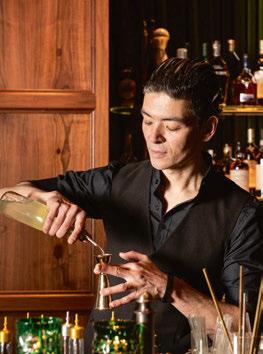
PROFILE
Gates Otsuji
Global Director of Bars
Edition
Gates Otsuji’s prominent hospitality career began almost by accident, with a casual bartending job in New York. The experience sparked a passion for the beverage industry that would see him go on to spend more than eight years working for The Standard Hotels in New York, before founding the bar and beverage consulting agency Controlled Substances. In 2020 he joined lifestyle hotel brand Edition as Global Director of Bars – a role that comes with a remit of 85 venues, including its signature Punch Room concept, across the group’s international property portfolio.
Redefining the Bar
Amidst the rapid evolution of the hotel bar, Edition’s Global Director of Bars Gates Otsuji discusses the importance of timeless design, creative agility and exceptional experience.
With 20 hotels currently operating globally and 12 more in the pipeline, Marriott International’s luxury lifestyle brand Edition shows no signs of slowing down in its quest to shape the contemporary hotel experience. As Global Director of Bars, Gates Otsuji helps to maintain the momentum by spearheading the group’s strategy for building outstanding beverage venues and programmes, while navigating the evolution of a nighttime hospitality sector that is rapidly transforming.
CRAFTING FLAWLESS EXPERIENCES
Echoing Edition’s unwavering commitment to quality and design, Otsuji and his team are laserfocused on delivering exceptional experiences for guests, paying assiduous attention to the specifics. “We strive to refine all the details,” he says. “We take a holistic view of beverage – and that includes the service, as well as a feeling of connection with the people and the place where you’re drinking. The design of that whole experience: the flavour, the texture, the presentation and the warmth with which it is given – that’s an indivisible package for us.” Part of the key to success in this area, he believes, lies in allowing the talented bartenders and employees who work with the brand to experiment with their craft, contributing to the evolving direction of each venue and pushing
creative boundaries. “It’s almost a collaborative effort: there’s no one person in the chain who makes hard and fast decisions for everyone all the time,” he explains.
With Gen Z and Millennial travellers spending more than previous generations on travel that sparks meaningful connection, a sense of place has become central to the hotel bar experience.
“There’s an overarching moment in F&B in general that involves leaning away from manufactured moments, and it’s driving hotels, in particular, to engage with communities on a deeper level than ever before,” notes Otsuji. He points to the rise in properties acknowledging that guests will leave the premises at some point to explore their surroundings, constructing targeted F&B concepts that will complement and assist in this journey of discovery, rather than seeking to maximise the time spent onsite or trying to dominate the local hospitality landscape.
“There’s a feeling that hotels should share the stage and amplify the talent that’s in the vicinity, in terms of the small producers,” he says. Edition makes a point of spotlighting local brands and produce behind all of its bars, but initiatives such as local takeovers and bespoke events can really help to secure the feeling of collaboration between a venue and its environment. Otsuji adds: “You need to embrace the sense of place and then go a step deeper.”
036
Words: Shanna McGoldrick
© Liz Clayman
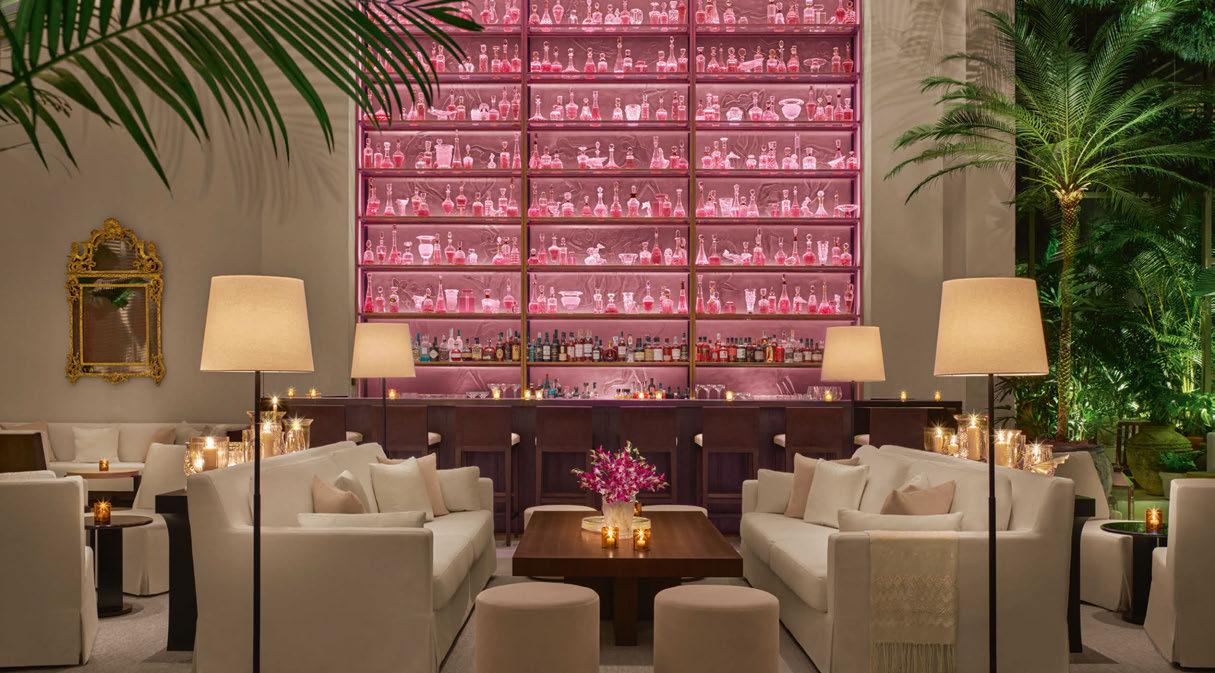
THE STRENGTH OF TIMELESSNESS
For a hotel to successfully take this sustainable approach to inserting itself into the local landscape, its bar offering should be designed with longevity in mind, Otsuji believes. “We talk a lot internally about trying to achieve a certain timelessness,” he says. “It’s not enough for something to be hot right now and it’s almost impossible to design something that doesn’t age. So how do we present concepts and bring them to life in a way that allows them to evolve? And not in a vacuum either: we want them to evolve with the community that they’ve engaged with and with the staff that are on the front lines.”
At Edition, consideration is given to the lifespan of any potential beverage space at the planning stage, with Otsuji and his team working diligently to ensure that a new venue will add to its local community, while working within the context of the brand’s values. Allowing space for tweaks further down the line is also crucial in maximising the venue’s potential to adapt. “Bars are some of the most agile venues we have in a property,” he states.
Overall, he says, patience is key, and with social media ageing gimmicks faster than ever before, a commitment to old-fashioned quality and connection is critical for success. “It comes down to playing the long game now – it’s not enough to have a showstopper moment,” he
explains. “What’s rare is the experience that guests will return to over and over again, and it takes time for them to return over and over again, so it’s important to diversify the offerings in the bar and to emphasise the quality of hospitality.” Financially, it’s a slow burn, but ultimately consistency wins. “The pattern of revenue isn’t as chaotic as it used to be – we’re seeing a longer curve,” he reveals. “It’s conducive for longevity but you have to be playing the game.”
A MOMENT OF REINVENTION
Thanks to globally shifting consumer habits when it comes to nightlife and drinking, the hotel bar finds itself at something of a crossroads, making adaptability critical for success. Statistics point to a fall in alcohol consumption across the board, but certain territories are leading the way in terms of repositioning beverage programmes in the contemporary hospitality landscape. Edition’s recent opening in Jeddah and its scheduled expansion in the Middle East, for example, presented an opportunity for Otsuji to rethink the brand’s approach to the in-house bar space. “In this case it wasn’t just important to study the market, but also to shift the way we look at bar and beverage in general, because so much of the population abstains from alcohol,” he explains of the design process for the hotel’s Lobby Bar, rooftop and lounge venues. Although
no- and low-ABV are rapidly rising trends, limited product distribution in the category posed a logistical issue. “When we started to think about how to bring these programmes to life – particularly in Saudi Arabia but in the Middle East in general – we found that we had to be a lot more resourceful than we expected,” he says. “It led us to be hyper creative.”
In practice, at The Jeddah Edition that has meant exploring botany and fermentation, going beyond the usual mocktail offering to implement the use of underutilised ingredients like water kefir. And the introduction of more culinary techniques has also had an impact on the design of the bar’s physical space – notably, a bigger back of house area to facilitate the change of focus in the beverage programme. “Exploring things like fermentation, brining and ageing takes space,” explains Otsuji. “It’s very obvious that the bar is coming into the kitchen and they’re acting as one.”
So how does a bar remain a bar, when the approach to beverages has so drastically shifted? “In markets with less alcohol consumption, food is more integral,” he says. “The menus have to be a little more interesting – and you try to think about how you integrate these components without turning yourself into a café or a restaurant. The service is one of the biggest differentiators in doing that.”
037
SERVICE

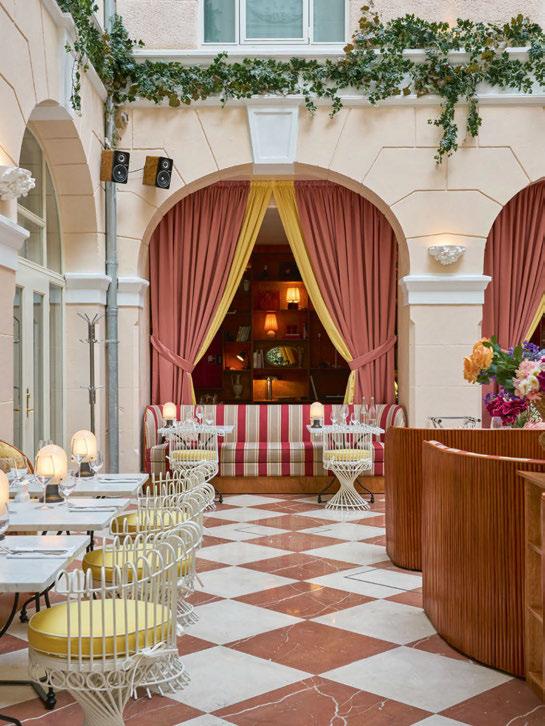
LCOPENHAGEN
Words: Cara Rogers
Photography: © Peter Dalsgaard
IN A BITE
Owner / Operator: Cofoco
Architecture: Wabe Studio
Interior Design: Tonen Agency
Menu Design: Cofoco, All The Way to Paris
Head Chefs: Trung Johnson, Frederik Fransson
F&B Manager: Charlie Frederichsen
www.hotelbellagrande.com
ooking to bring to life a suitably stylish restaurant for Hotel Bella Grande, a new boutique opening in the heart of Copenhagen, Cofoco launched Donna, the largest F&B venue in its 18-strong collection. Filled with vivid colours and striking design details, the 235-cover restaurant is split into a series of individual spaces that flow smoothly into one another, from seductive scarlet nooks to a vast Italian-inspired atrium.
The initial restaurant space is decked out in sultry red and pink shades, with a glossy cerise ceiling, two-toned panelled walls, plush velvet seating and sweeping salmon curtains. The moody interiors are reminiscent of another era, with Art Deco-inspired lighting fixtures on tables and walls, and curved furniture featuring alongside arched mirrors adorned with swirling white patterns.
Moving through the restaurant leads to a light-filled courtyard with a bright, open ambience that contrasts with the intimate interior. Lined by guestroom windows and
topped with a high glass roof, the space is divided by floral and striped banquette seating in a range of colourful hues. Tall arches flank its perimeter and house cosy alcoves with booths, framed by sweeping pink and yellow curtains. Lush green foliage covers the peach-toned walls, and bright bouquets are dotted throughout the space. Charming touches include classicalstyle statues and busts, and a faux-worn iron staircase that gives the setting the aura of a whimsical secret garden.
Guests dine on traditional Italian fare at the venue’s chic marble tables. An indulgent truffle cacio e pepe is plated up tableside from a hollowed-out cheese wheel, while other classic pasta dishes include a seafood linguine and rigatoni alla vodka. There’s also roast chicken stuffed with sage, served with tomatoes, fava beans, artichokes and truffle sauce, as well as a variety of hearty pizzas. To finish, there’s tiramisu, pavlova or panna cotta – whose flower-shaped form is right at home within the restaurant’s picture-perfect interiors.
STARTER 038
Donna Hotel Bella Grande
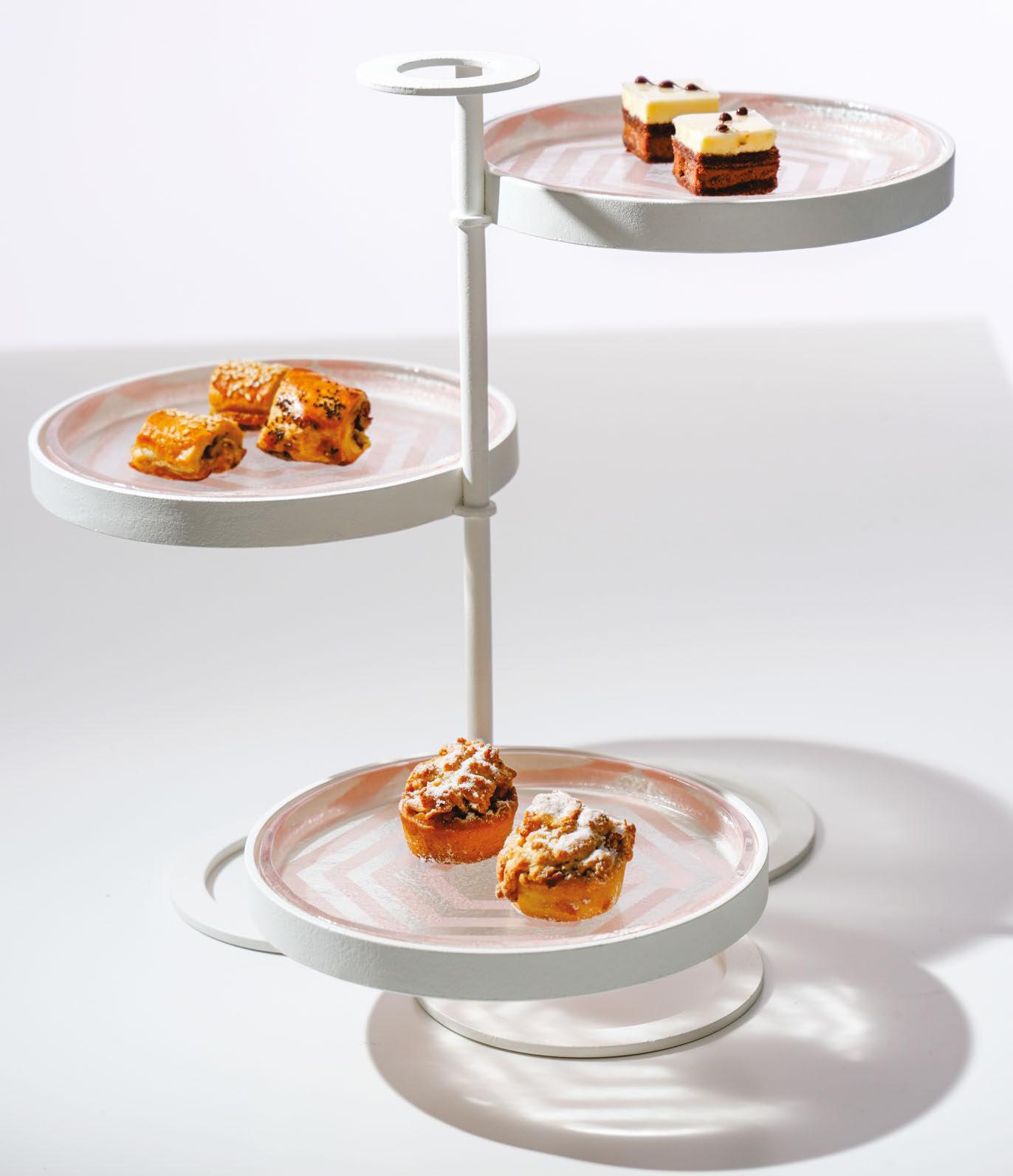

Explore our Unique Tea Stand Assortment Download Catalog www.myglassstudio.com

Nox Beach Club
Hoiana Resort & Golf
HOI AN
Words: Shanna McGoldrick
Photography: Courtesy of Nox Beach Club IN A BITE
Operator: Rosewood Hotel Group
General Manager: Jimmy Lopez
F&B Director: Giacomo Maroccia
Director of Culinary: Omar Ugoletti
Cluster Executive Sous Chef: Hugo Bertolini
Beverage Manager: Anh Tran Le Tuan www.noxhoian.com
Vietnamese foodie paradise Hoi An has added a new string to its bow with the opening of Nox Beach Club, an innovative gastronomic hub specialising in gourmet dishes and live entertainment.
Located amidst the tropical palm trees that line the coast, just a short drive from the UNESCO World Heritage town that served as its inspiration, Nox Beach Club sits within the luxe Hoiana Resort & Golf and boasts six restaurant and bar concepts ranging from a casual seafood joint to upscale poolside bar.
Naturally, the tantalising flavours of the Quang Nam province take centre stage, with the eatery Banh Mi & Noodles offering guests a taste of Hoi An’s fabled street food classics like sumptuous bánh mi and generous portions of delicately fragranced pho, all infused with a lively, beachside vibe. For those seeking a more international dining experience, the restaurant Osteria, with its authentic Italian dishes and pared-back interiors, should do the trick, while the upscale venue Grill focuses
on premium steaks and fresh seafood, cooked over a charcoal fire and paired with fine wines. Fish is also the star of the show at the Seafood Shack, where the catch of the day is transformed using South American and Asian flavours, and a stylish Crudo bar showcases the best of the region’s shellfish.
Classic cocktails and signature concoctions are the speciality of The Courtyard Bar, an intimate terrace that leans on its tropical location for a relaxed and cosy vibe, while a showstopping Beach Club Bar allows guests to grab light bites and refreshing drinks in the elegant surroundings of the lagoon pool.
With a vibrant entertainment programme paving the way for regular pool parties, happy hours and live DJ slots, Nox Beach Club is positioning itself as a refined oasis for funseekers and foodies alike. As Jimmy Lopez, General Manager, New World Hoiana Hotel and New World Hoiana Beach Res ort, surmises: “This is more than just a beach retreat – it’s a lifestyle.”
STARTER 040
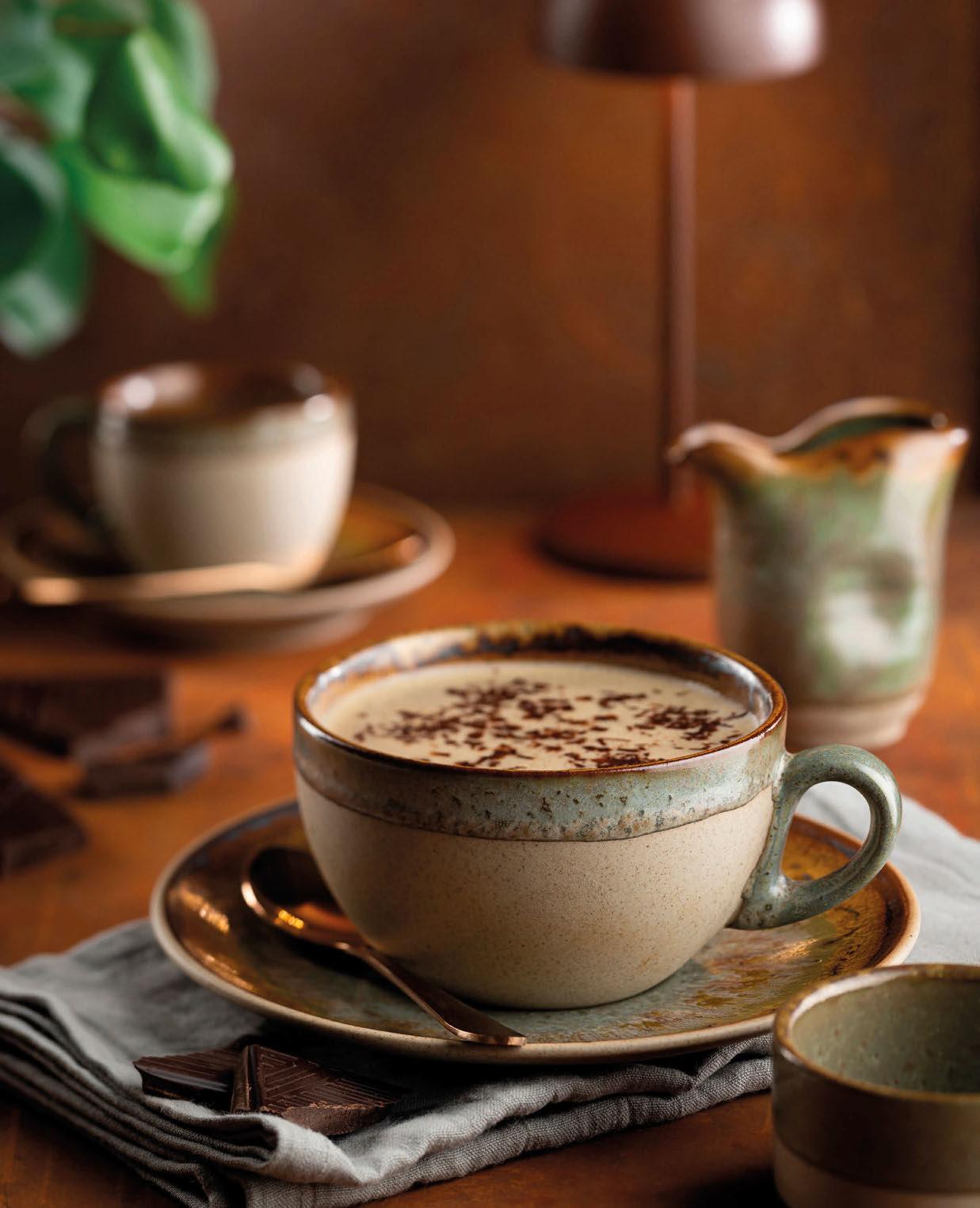


De Mark
De Durgerdam
AMSTERDAM
Words: Eleanor Howard
Photography: © Chantal Arnts
Just a short boat ride from Amsterdam is the fishing village of Durgerdam, where a 17 th-century waterside inn has been transformed into De Durgerdam, a 14-key boutique hotel complete with a relaxed openplan restaurant spread across the ground floor.
IN A BITE
Owner / Operator: Aedes
Interior Design: Buro Belén
F&B Consultants: Thomas Groot, Richard van Oostenbrugge
Head Chef: Koen Marees www.restaurantdemark.com
Conceived by Richard van Oostenbrugge and Thomas Groot – the culinary duo behind Amsterdam’s two-Michelin-starred 212 – De Mark serves modern comfort dishes in an informal setting envisioned by local design firm Buro Belén. Taking cues from the property’s maritime past and lakeside location, the interiors feature natural tones and textures, which are accented by carefully curated artworks, from a still life by 17th-century Dutch painter Pieter Jansz Van Berendrecht to a contemporary fishing net light installation suspended above a dining table. At one end, doors overlooking the lake open out onto a terrace and jetty, furnished with dining tables during the summer months.
Inspired by ‘gezelligheid’ – a Dutch word translating as conviviality – Head Chef Koen
Maree’s coastal cuisine focuses on locallysourced ingredients from the surrounding fields and waters. While the menu evolves with the seasons, plates include the likes of mushroom paté rolled in coffee powder, North Sea crab salad and woodfire-roasted rib chop accompanied by homemade black pudding, parsnips and apple. The standout, however, is the Pomodori tomato tartare, prepared through several hours of roasting and dehydrating and served with fresh garlic sourdough.
Most recently, De Mark has unveiled a subterranean Wine Room, which functions as both a private dining room and a wine cellar for the restaurant upstairs. Emphasising the building’s history as a maritime inn, the space is characterised by original features such as 17th-century candle nooks built into the walls, alongside a reclaimed table seating up to six, a vintage glass rack and flooring combining terracotta Dutch ‘estrikken’ tiles and bespoke red glazed tiles handcrafted by Royal Tichelaar, the oldest ceramic factory in the Netherlands.
STARTER 042

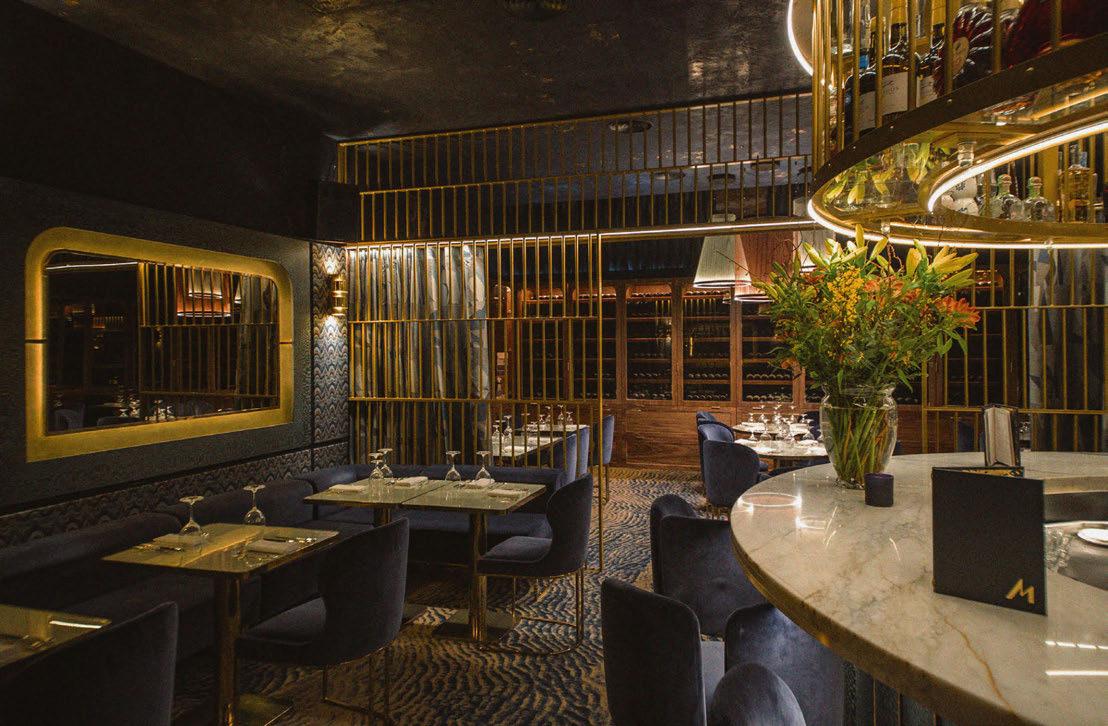
Manchester’s lifestyle hotel Leven has welcomed a dynamic new drinking and dining venue in the form of Maya, a sumptuously decked-out affair that aims to take guests from noon to the small hours.
Words: Shanna McGoldrick
Photography: Courtesy of Maya
IN A BITE
Owner: Scottie Bhattarai
Interior Design: Ziad Alonaizy
Head Chef: Gabe Lea
Head Bartender: Sean McGuirk
Coffee Machine: La Marzocco
www.mayamanchester.com
The brainchild of Scottie Bhattarai – who is also CEO of Isabel Mayfair and previously led restaurant brands in the Soho House stable and Petersham Nurseries to Michelin-starred recognition – Maya stretches across three stories in the 20th-century warehouse building that is home to the eclectic boutique hotel.
The space welcomes diners at ground floor level with a light and airy brasserie, offering a modern European-style menu of classic dishes. Below, the intimately lit main dining room focuses on plush furnishings, with the design anchored by a statement oval fluted destination bar topped with Calacatta Oro. The ingredientled, hyper-seasonal and regularly changing menu comes courtesy of Head Chef and native Mancunian Gabe Lea, who cut his teeth at Michelin-starred establishments including Le
Manoir and The French at The Midland Hotel. One level down is a secluded lounge bar whose interior pays tribute to the industrial history of Leven’s architecture, juxtaposed with discoera-inspired neon installations for a touch of verve. An extensive cocktail and non-alcoholic drinks menu features invigorating flavour combinations such as yuzu and agave, almond and truffle, or chamomile and caviar.
Maya’s overarching concept, dubbed ‘dinner plus’, is designed to offer culinary experiences that roll seamlessly into late-night revelry, with a roster of DJs providing the soundtrack to elegantly hedonistic nights. A partnership with Leven that will see the restaurant boost the 42-key hotel’s in-room dining offering is also in the pipeline.
“The term ‘iconic’ is often overused, but the location of Maya can truly claim the label,” says Bhattarai of his latest project, which opened its doors this spring. “We aim to write a fresh new chapter for the city’s vibrant and wonderful hospitality scene.”
STARTER 044
Maya Leven MANCHESTER

The Riviera Maya Edition at Kanai
MEXICO
Edition makes its debut in Latin America, enlisting top Mexican chefs to showcase the nation’s culinary delights.
Words: Catherine Martin • Photography: Courtesy of Edition (unless otherwise stated)
Thanks to its ancestral techniques, fresh and wholesome ingredients and vibrant flavour combinations, authentic Mexican cuisine is currently enjoying a well-deserved moment in the spotlight; Michelin launched its inaugural Mexico guide just a matter of weeks ago, while the latest listing from The World’s 50 Best sees a number of the nation’s restaurants and bars take their place on the global stage. For Edition, where the F&B programme of each hotel is typically inspired by the destination, the opening of its new property on the Riviera Maya couldn’t have come at a better time, with the line-up featuring not one, but two of Mexico’s top chefs.
Located on the Caribbean coast between Cancún and Playa del Carmen, The Riviera Maya Edition at Kanai marks the brand’s entry into Latin America following recent openings in Rome and Singapore. Nestled amongst the mangroves on a 620-acre nature reserve, the sprawling resort is the result of a partnership between Ian Schrager and Marriott International,
and has been designed by Rockwell Group with architecture by Edmonds International. The overarching concept is inspired by the region’s cenotes – the water-filled sinkholes that formed when an asteroid hit the land some 65 million years ago – and extends from the lobby and public spaces to the spa and lagoon-like swimming pool. And much like the limestone caverns, the resort is surrounded by lush vegetation; greenery cascades from the ceiling while potted plants line staircases and walkways, effectively blurring the boundaries between indoor and out.
With the design of the 182 guestrooms deliberately pared back – championing natural materials and a neutral palette to align with the Edition aesthetic – the restaurants and bars embrace the location, bringing bold colourways, Mexican flourishes and yet more greenery to enhance the sense of place. At the Lobby Bar, Rockwell Group has successfully married Edition’s signature use of accent colours with the studio’s own distinctive dose of drama,

046

MAIN COURSE 047 ©
Miguel Juarez

The resort’s design – led by Ian Schrager and Rockwell Group – brings together bold colourways, Mexican flourishes and plenty of greenery to enhance the sense of place
pairing clusters of seating in vibrant hues with theatrical drapes that hang from floor to ceiling of the soaring triple-height space. Framed by towering timber screens, the pièce de résistance is a custom-made plaster mural referencing overscaled glyphs from Mayan ruins, fronted by a monumental feature wall adorned with authentic ceramics meticulously sourced by owners Grupo Alhel. By night, the artefacts are expertly illuminated to dramatic effect, creating an atmospheric setting to sample the inventive cocktails and agave distillates; the Southern Goddess – a heady mix of Tapatio blanco tequila, fresh corn milk, fresno chile and cumin salt – is not to be missed.
Outside, the Pool Bar continues the use of accent colours, with soft furnishings in orange, red, yellow and pink to match the plant pots, all set beneath a canopy of flowering bougainvillea. Designed for all-day dining, the menu here includes sandwiches and light bites, as well as the Kanai burger topped with jalapeño relish, and the hugely popular Baja fish tacos.
For the main restaurants, Edition has enlisted the talents of Mexican chefs Francisco ‘Paco’ Ruano and Tomás Bermúdez to develop the dining concepts. Both have found success in their own ventures; Ruano is behind the awardwinning Alcalde in Guadalajara, listed at #37 on Latin America’s 50 Best Restaurants 2023, while Bermúdez founded seafood restaurant La Docena in Mexico City, which ranks #48. Friends for over a decade, the venture marks the first time their cuisines have come together at a resort destination, and though their concepts differ, the pair share a similar approach, taking inspiration from the traditions of their parents while highlighting Mexico’s rich bounty.
At fine-dining restaurant Ki’is – named after the Mayan word for zest – Ruano has created a contemporary Mexican menu that combines the flavours of the Pacific coast with produce from the Yucatán Peninsula. Having gained experience at European dining destinations including Mugaritz, El Celler de Can Roca and Noma, the chef opened Alcalde in his home city
048
© Nikolas Koenig
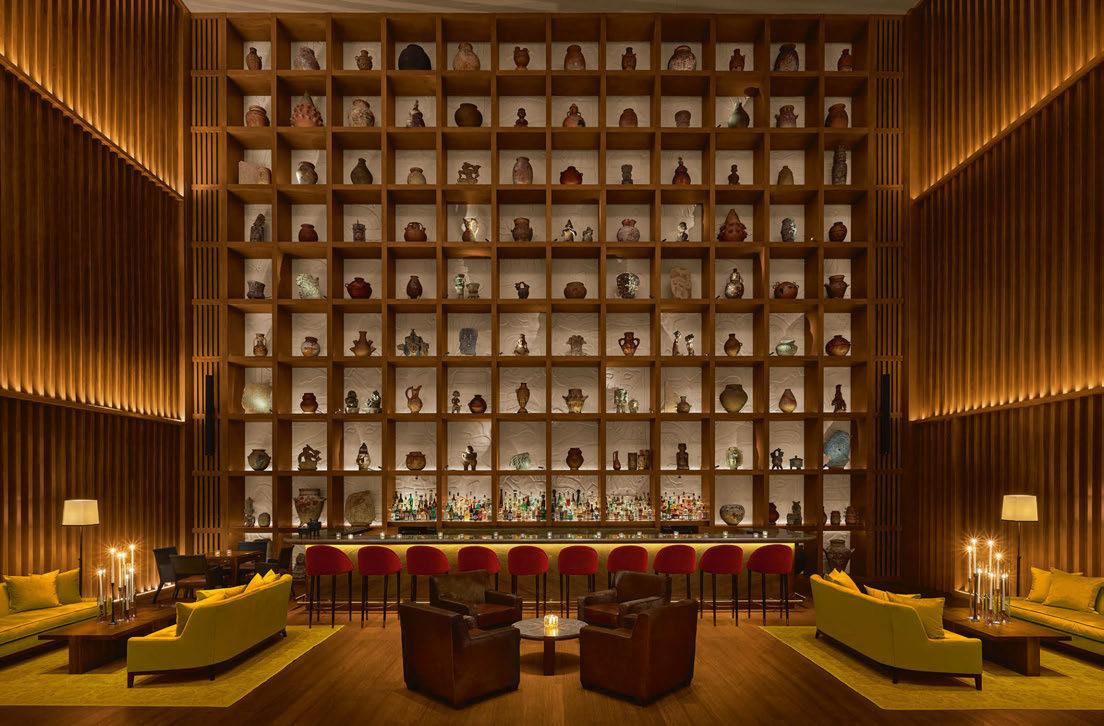
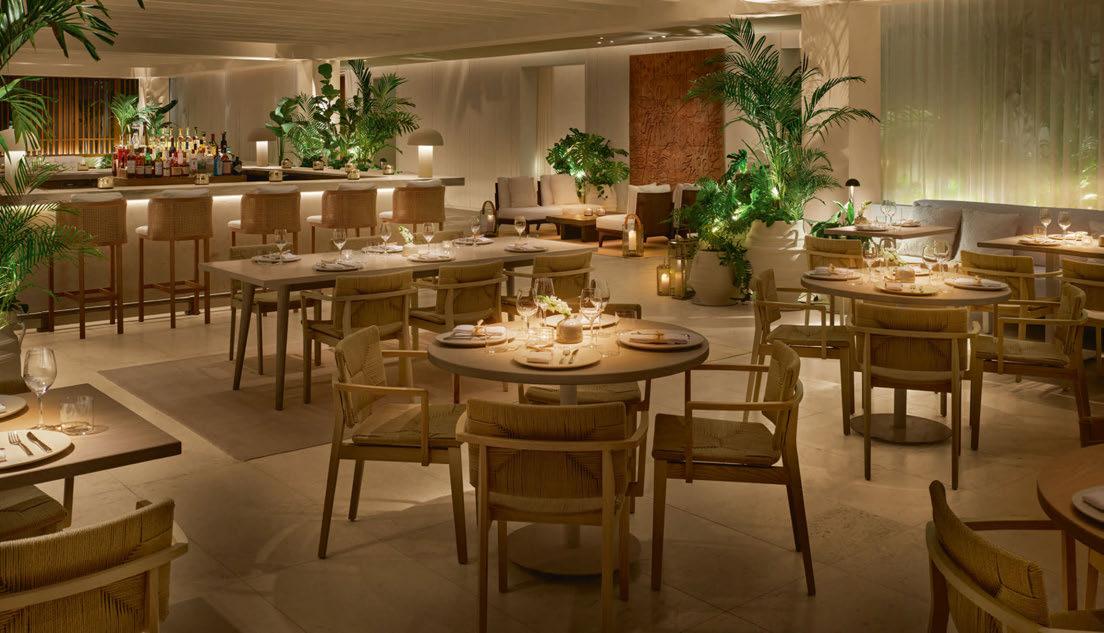
MAIN COURSE 049
© Nikolas Koenig

of Guadalajara, where he developed his own style of Mexican cuisine – one that favours simplicity. Building on this approach, Ruano’s dishes at Ki’is celebrate the naturalness of the ingredients, and, true to the restaurant’s name, come with added zest. Scallops for example are submerged in green aguachile – a tangy blend of lime juice, salt and cucumber – while the Tikin Xic fish is garnished with leafy purslane and bitter orange. On Supper’s visit, the sevencourse tasting menu featured produce from land and sea: the opening course saw a bitesized lobster salbute – an elevated take on the Yucatecan stuffed tortilla – served on a bed of Caribbean sand, soon to be followed by delicate slices of Pacific geoduck clam in the citrusy juice of tomatillo, also known as Mexican husk tomato. A pumpkin salad scooped directly from the shell showcased the freshness of the ingredients, with Ruano reaffirming the sense of place through a side serving of flour tortillas –anything goes in a taco in this part of the world. And bringing some local specialties to the table,
the tender carne asada was topped with toasted chapulines, better known as grasshoppers. Adding to the multi-sensory experience, dishes are garnished with greenery and native flora – both edible and decorative – their appearance serving to connect the cuisine to the surroundings. With the restaurant occupying a glazed pavilion nestled in the mangroves, Rockwell Group has opted for a paredback palette of whitewashed panelling and neutral furnishings, directing attention to the surrounding landscape as well as to the plate. Back in the main building, Chef Ruano has also curated the menu for Kitchen, an all-day dining experience that evokes the feeling of an abandoned hacienda, where vegetation sprouts from every corner, climbing wooden beams and forming a canopy above. The menu takes a more relaxed approach to Mexican cuisine, with family-style sharing plates ranging from street-style classics to hearty comfort food. At breakfast, the menu includes huevo encamisado – a Mayan staple of folded tortilla with egg
MAIN COURSE 050
Chefs Francisco ‘Paco’ Ruano and Tomás Bermúdez take inspiration from the traditions of their parents while highlighting Mexico’s rich bounty
© Miguel Juarez
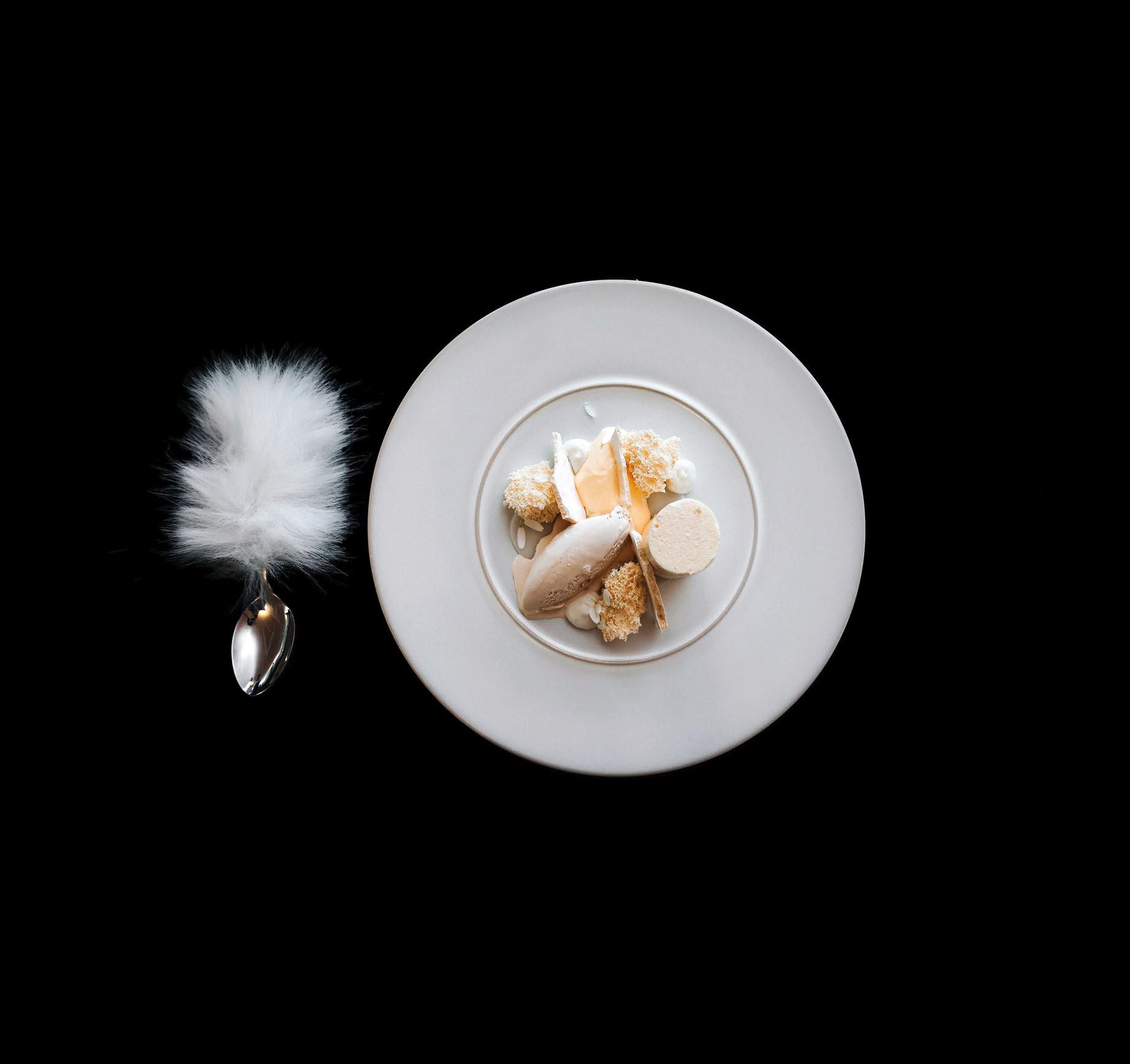

and fresh hoja santa herbs – and the Yucatán favourite, cochinita pibil, a slow-roasted pork dish marinated in bitter orange and achiote. All are served on tableware that harmonises with the interiors, hand-crafted in clay by Jono Pandolfi Designs and accompanied by cutlery by Robert Welch. Incorporating a personal touch, Ruano has also introduced an appetiser of fresh fruit, bread with salsa and guacamole, and a bowl of chilaquiles – a typical Mexican breakfast dish made from tortillas – to precede the main course, a tradition that hails from his own childhood and pleasingly whets the appetite.
Bermúdez meanwhile has developed the concept for So’ol, a laidback beach club accessed via a meandering palm-lined pathway. Overlooking an infinity pool and the shoreline beyond, the open-air venue is reminiscent of the beach clubs that dot the Mediterranean coast, albeit with a distinct Mexican twist. The cuisine takes the same approach, influenced in part by Bermúdez’s time spent under the mentorship of Martín Berasategui in Spain. Following stints
in Europe and Argentina, the chef returned to Mexico to co-found La Docena, a specialist oyster bar and grill. At So’ol – meaning oyster in Mayan – saltwater molluscs are naturally part of the line-up, as are Campeche stone crab, clams from the Sea of Cortés and an impressive shrimp cocktail. And Bermúdez has wisely introduced his favourite dishes from La Docena into the menu too, such as a zingy ceviche and bluefin tuna tostada. Other highlights include octopus that has been marinated in mouthwatering sikil pak and roasted on the mangal, and sea bass zarandeada, cooked in the traditional way on the outdoor grill and served with guacamole, xnipec and tortillas.
Like Ruano, Bermúdez focuses on simplicity through the use of quality ingredients and timehonoured cooking techniques. Having spent a decade building relationships with sustainable producers and suppliers on both the Atlantic and Caribbean coasts, the duo are seeing that authentic Mexican cuisine gets the attention it so deserves.
IN A BITE
Owner: Grupo Alhel
Operator: Marriott International
Architecture: Edmonds International Interior Design: Ian Schrager Company, Rockwell Group
Chefs: Francisco Ruano and Tomás Bermúdez
Dinnerware: Jono Pandolfi Designs
Cutlery: Robert Welch www.editionhotels.com
MAIN COURSE 052
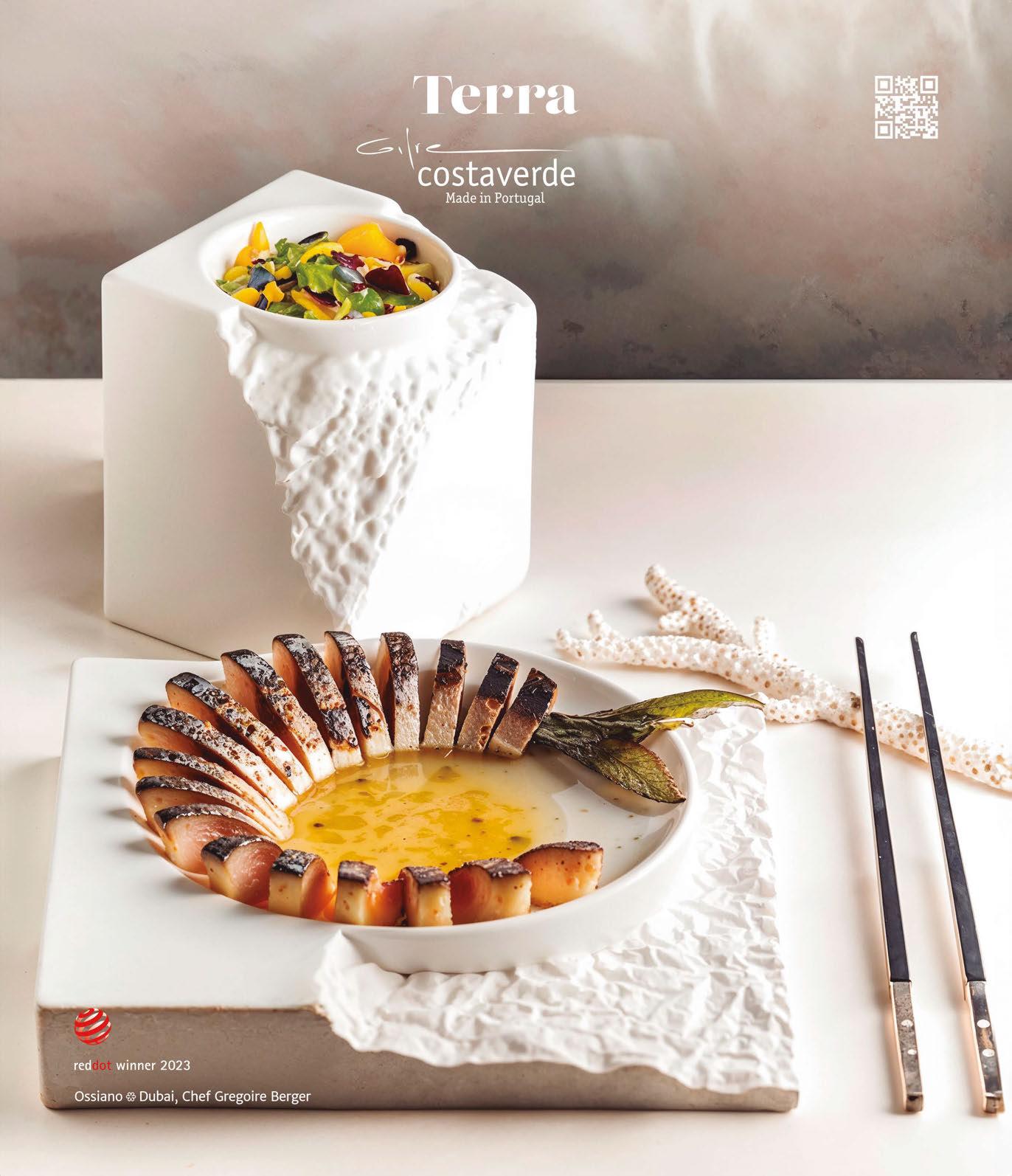
Jara by Martín Berasategui
The Lana
DUBAI
The illustrious chef joins forces with Dorchester Collection to champion the bold flavours of the Basque Country with the launch of an opulent Dubai venue.
Words: Shiraz Randeria • Photography: Courtesy of Dorchester Collection (unless otherwise stated)
Dubai’s culinary scene is enjoying a dalliance with Spanish cuisine, if the 2024 openings of the Andalusianthemed Qabu by Paco Morales at The Link and The Lana’s Basque destination Jara by Martín Berasategui are anything to go by. And in typical fashion, the Middle Eastern territory is approaching the concept in an ambitious manner: between them, the two chefs have an astonishing 15 Michelin stars.
Located on the 18 th floor of The Lana –Dorchester Collection’s first hotel in the region and its first opening in more than a decade –Jara’s position on Marasi Bay affords diners expansive views of the semi-circular marina and, further in the distance, the Burj Khalifa. The vespertine colours reflected by the buildings in this new city district add a dash of drama to the dining experience.
The building, along with its neighbouring Lana Residences, was designed by Foster + Partners, with Australian studio Verhaal initially called upon to work on the interior of the hotel’s signature restaurant. However, following a
Covid-related hiatus, another Australian outfit, Mitchell & Eades, came on board to complete the design, using Verhaal’s original layout for the space. Unhurried elegance is the prevailing theme, with guests gradually uncovering various linked areas in a state of sedate discovery.
“Our brief was to create a Basque dining experience,” says Hayley Mitchell, Mitchell & Eades’ Principal. “Basque restaurants are traditionally quite masculine and monochromatic, but The Lana wanted this space to be more feminine. Basque culture only celebrates female goddesses and our concept was formed around Mari – Queen of Nature –who moved from mountain to mountain on the back of a fire-breathing dragon.” Since openfire cooking is a signature feature of Basque cuisine, the mythology provided a rich starting point for Jara’s design concept.
Stepping out of the hotel’s lift lobby on the 18th floor, guests enter a cave-like front desk area fitted out with handmade terracotta tiles from the ceramic collective Veelvlak and then turn either right for the bar or left for the main

054

MAIN COURSE 055


Chef Martin Berasategui’s showstopping cuisine highlights the best of Basque gastronomy
dining room. Here, Mitchell & Eades divided the spaces into two different colour zones, leaning on reds and greens for maximum impact.
“The bar area is inspired by Mari as this ‘Lady of Fire’, so we had a prominent lighting sculpture based on the burning embers of a log fire,” says Alika Watson, Mitchell & Eades’ MEA Director and the project’s design lead. “It’s such a specific design element because it helps tell the story of the space and it’s beautifully executed.” Deep red tones also run through the rest of the bar, with the light fixtures, upholstery and marble all adhering to the colour scheme. XLBoom barware and Nude glassware maintain the elegant aesthetic, and an Arte-designed woven wall finish behind the banquette seats has a moiré effect that sees it shimmer and play with the light.
“The dining area is where we’ve brought in green and gold tones underneath a textured plaster undulating ceiling,” continues Watson of the main restaurant’s area, where chic candlelit tables play host to refined Robert Welch cutlery and Playground dinnerware. “The furniture is all custom-made and part of the reason for the white marble tabletops was that with the darker plates used, the food really stands out.”
Not that it needs any help. Berasategui’s showstopping cuisine highlights the best of Basque gastronomy, with a seafood and meat-heavy menu that is passionately and meticulously brought to life through techniques such as charcoal grilling and slow cooking. Classics include Txangurro donostiarra, a San Sebastian-style spider crab stew, and the traditional casserole Kokotxas, which comes laden with hake in pil-pil sauce and clams. Hearty Australian
056 MAIN COURSE
© Natalie Chaban
© Natalie Chaban

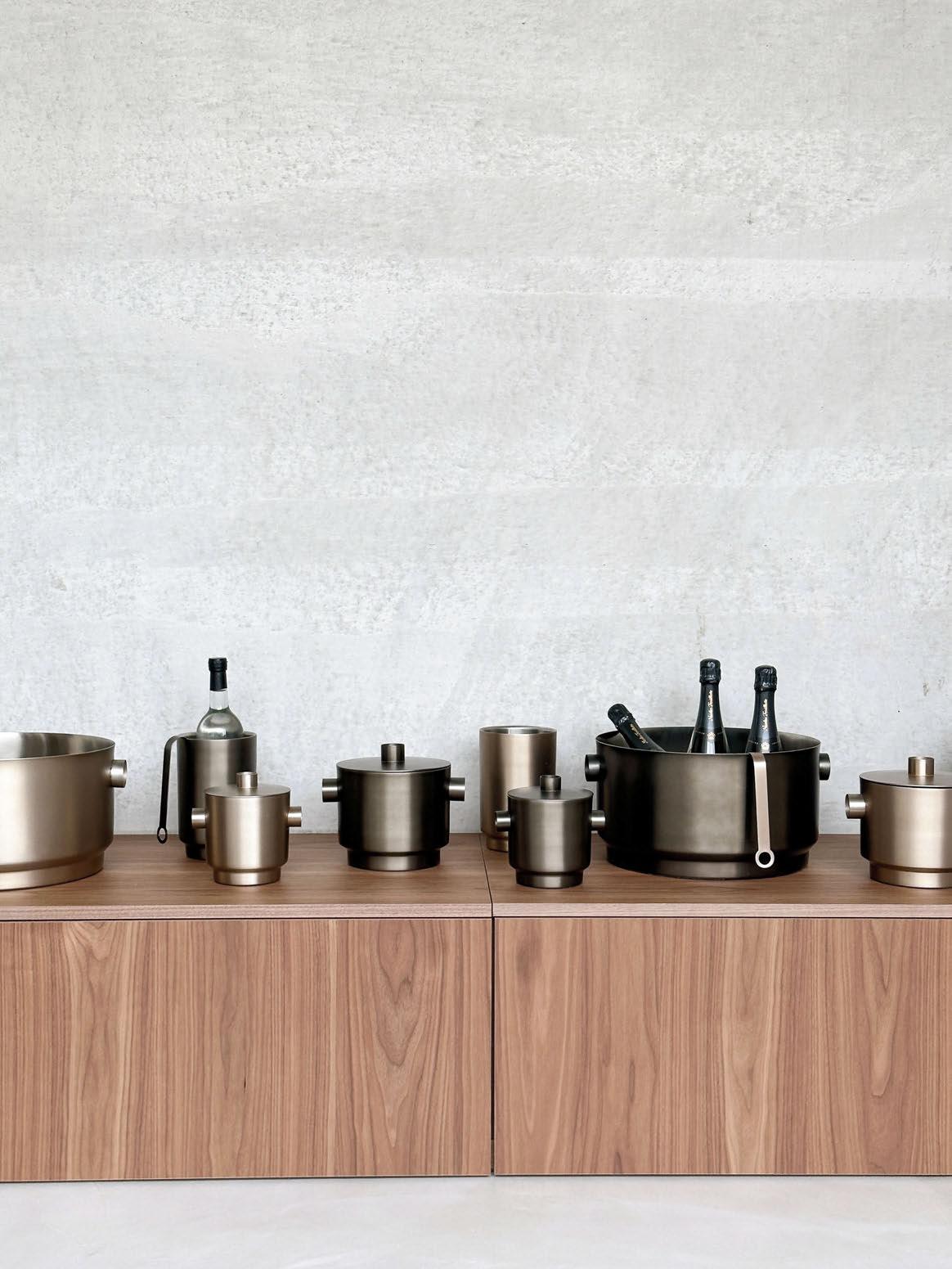

info@xlboom.com +32 3 213 50 20 @xlboom
www.xlboom.com

wagyu and Angus steaks come grilled Basquestyle, while a Spanish baby lamb shoulder is reverentially slow-cooked before being finished in the restaurant’s clay oven. Plump oysters are served with lemon, Tximista sauce or the chef’s special gazpacho, and sides include robust, smoky vegetable dishes such as roasted piquillo peppers and fried agria potatoes.
“Basque cuisine connects with the world’s palate because its simple recipes and ancestral cooking techniques tug at the heartstrings, but also have an astounding ability to excite,” says Berasategui of his decision to bring his native region’s cuisine to diners in the UAE. “I am very proud of the dishes cooked on the open fire, I am a fan of the ‘besugueras’, the triple overturns, the ‘refritos’ and that perfumed shimmering of molluscs and crustaceans.”
His commitment to the cause of championing Basque flavours carries over to the bar menu, which features popular and casual light bites with an indulgent touch, such as his signature croquettes, patatas bravas and stuffed and fried
Spanish tiger mussels. House cocktails are divided into the categories of sea, land and fire, with highlights including the Maritxu – a heady mix of mezcal, sherry, tomato juice, spiced oyster sauce, soya milk, onion, garlic, celery, cucumber, strawberry and cherry tomatoes –as well as the Erroa-Lacha, which combines punchy pisco with sherry, beetroot, carrot, lime juice and ginger ale. The chef was equally as involved in meticulously designing the offerings for both the bar and the main restaurant. “Jara’s drinks and aperitifs are the combination of many years of work and the fine-tuning of numerous small bites and drinks selected and fine-tuned with my cold room teams and bartenders,” he explains. “Nothing can be left to chance, because in my venues I try to make sure that the customers live total experiences and are dazzled by the honeycomb of a bread, the silkiness of a cocktail, or the power and elegance of the first mouthful of aperitif when they sit down at the table or wait at the bar to go on to lunch or dinner.”
058
Plump oysters come served with lemon, Tximista sauce or gazpacho
© Natalie Chaban

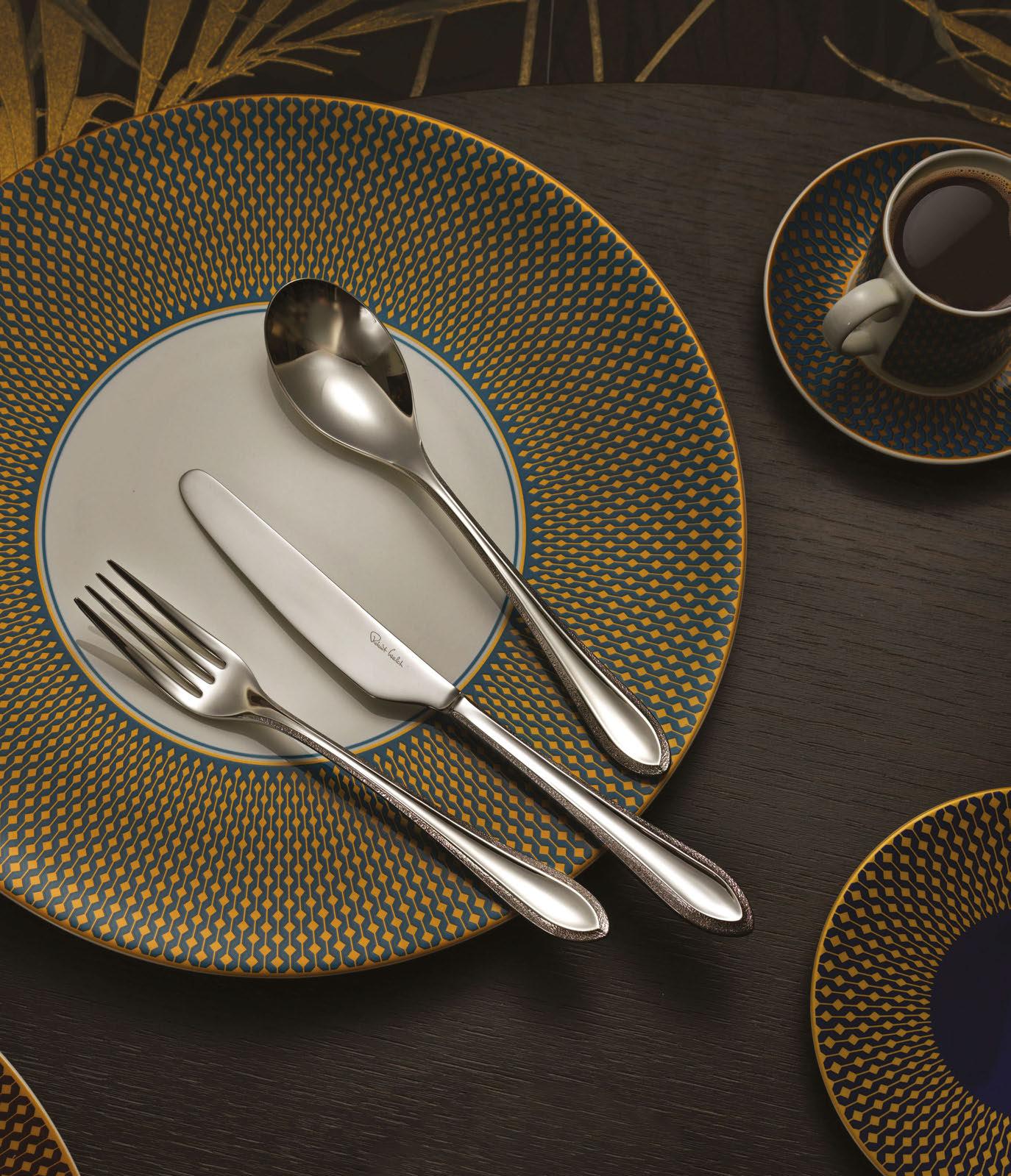
FEATURED : KEMBLE TEXTURE
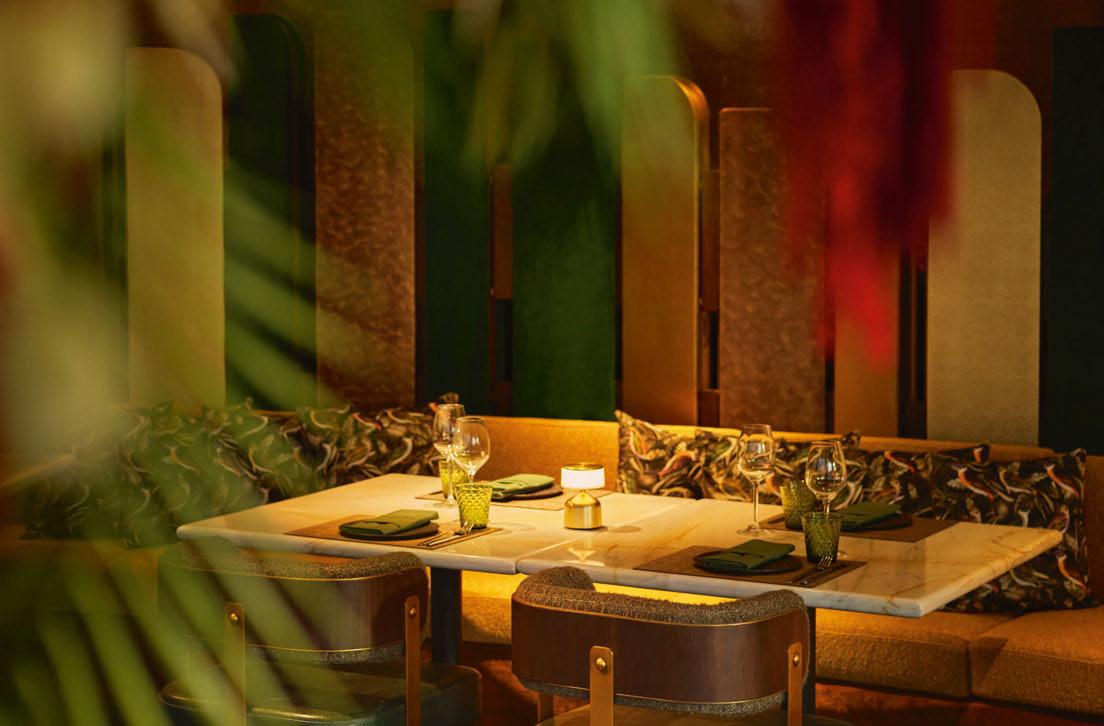
At the far end of the dining room is a vast terrace, which Berasategui refers to as “the best terrace in all of Dubai”, while Txakolina, a small speakeasy bar, acts as the final space in the Jara jigsaw. Serving spirit-infused cigars and wine from the Basque Country, the watering hole is hidden behind what looks like a normal grey service door, but despite its invite-only guest list, Watson explains that it is very much part of the Jara experience. “We designed it as a treasure trove, as the goddess Mari had an affinity for jewellery and so we made this her lair,” she says. “The whole space feels like a jewellery box; it’s very private, with a curved bronze metallic leather ceiling, and then we worked with Kriskadecor to develop layered chain metal wall finishes.”
Despite the many different individual spaces that comprise Jara, the design and culture of the restaurant essentially revolves around the dining room’s central open kitchen: a deliciously smoky smell lingers in the air and there is the frequent, theatrical rising curtain of open flames
shooting up from the grills as the chefs work, purposefully facing the guests. Dubai-based kitchen consultant Fondue was commissioned to adapt the kitchen for the requirements of Basque open-fire cooking, which Berasategui relishes, despite its challenges. “The grill puts you directly in front of the diner, so you must be highly professional,” he notes. “You cannot disappoint as there is nowhere to hide if the dish is mediocre.”
It’s clear how highly he values the interaction and integration between the kitchen and the dining floor – between chef and guest. At Jara, that doesn’t just refer to the proximity of the chefs, but also to the way that fish and meats are openly cooked. “Every space is designed with a purpose in mind, starting the seafood and fish display case, the maturation chambers, and the huge grills that focus the guest’s attention,” he says. “The relationship with the guest is fundamental – that feeling, seeing their expressions, is something that every chef should experience.”
IN A BITE
Owner: Omniyat
Operator: Dorchester Collection
Architecture: Foster + Partners
Interior Design: Mitchell & Eade
Executive Chef: Martín Berasategui
F&B Manager: Nicolas Caupain
Head Bartender: Ida Bagus
Head Sommelier: Alexandre Alverca
Dinnerware: Playground, Studio 1765
Cutlery: Robert Welch
Glassware: Nude
Barware: XLBoom
www.dorchestercollection.com
MAIN COURSE 060

Timelessly elegant, simple and beautiful.
Café Carmellini
The Fifth Avenue Hotel
NEW YORK
Eminent chef Andrew Carmellini stages a glamorous return to fine dining in New York.
For 15 years, the pedigreed US chef and restaurateur Andrew Carmellini – who built his reputation at the New York fine-dining institutions of Le Cirque and Café Boulud, among others – was known for his pared-down, approachable cuisine, focusing on a combination of NewAmerican, French and Italian fare. In 2009, he partnered with Hollywood legend Robert DeNiro to open the neighbourhood taverna Laconda Verde at Tribeca’s celeb magnet The Greenwich Hotel, before going on to launch several New York eateries such as The Dutch and Lafayette Grand Café & Bakery under the umbrella of the NoHo Hospitality Group he co-founded with partners Luke Ostrom and Josh Pickard. A string of high-profile ventures in the decade that followed secured his position as a hospitality heavyweight whose projects scooped up multiple accolades and awards.
Recently, however, Carmellini returned to his fine-dining roots, opening his first eponymous restaurant in New York’s glitzy Fifth Avenue Hotel. “I’ve been missing it,” he says of the return to haute gastronomie, and the inception of his most personal venture yet. Named after his Tuscan family’s coffee business, Café Carmellini pays homage to the chef’s French training and Italian heritage, as well as to the people that have left a lasting impression on him.
What immediately strikes diners about the venue – which is set in a Renaissance revival bank building on the site of a notable Gilded Age socialite’s mansion – is the sheer scale and drama of the space. “The main dining room is quite grand; high ceilings, large arched windows looking to Fifth Avenue and 29th Street,” explains British designer Martin
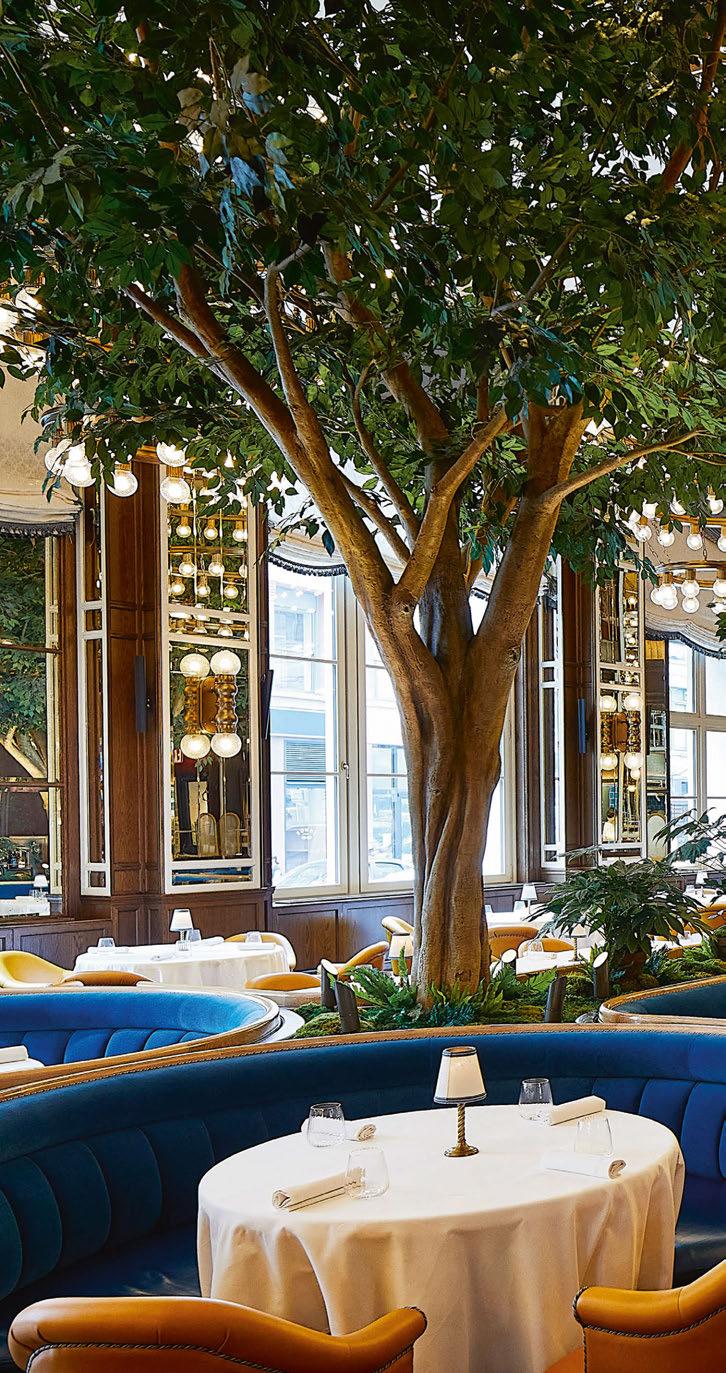
062
Words: Ayesha Khan • Photography: Courtesy of Café Carmellini
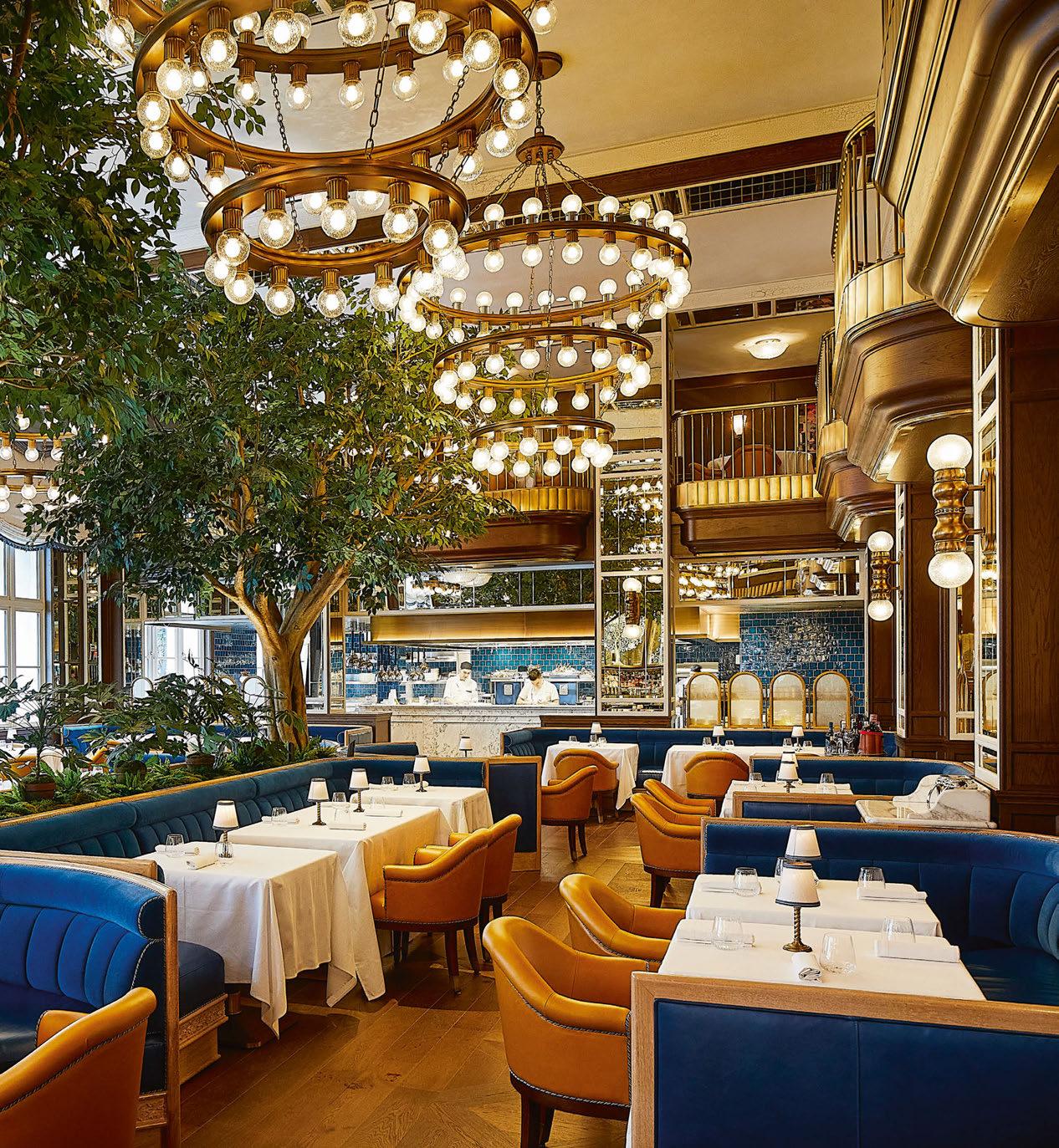
MAIN COURSE 063
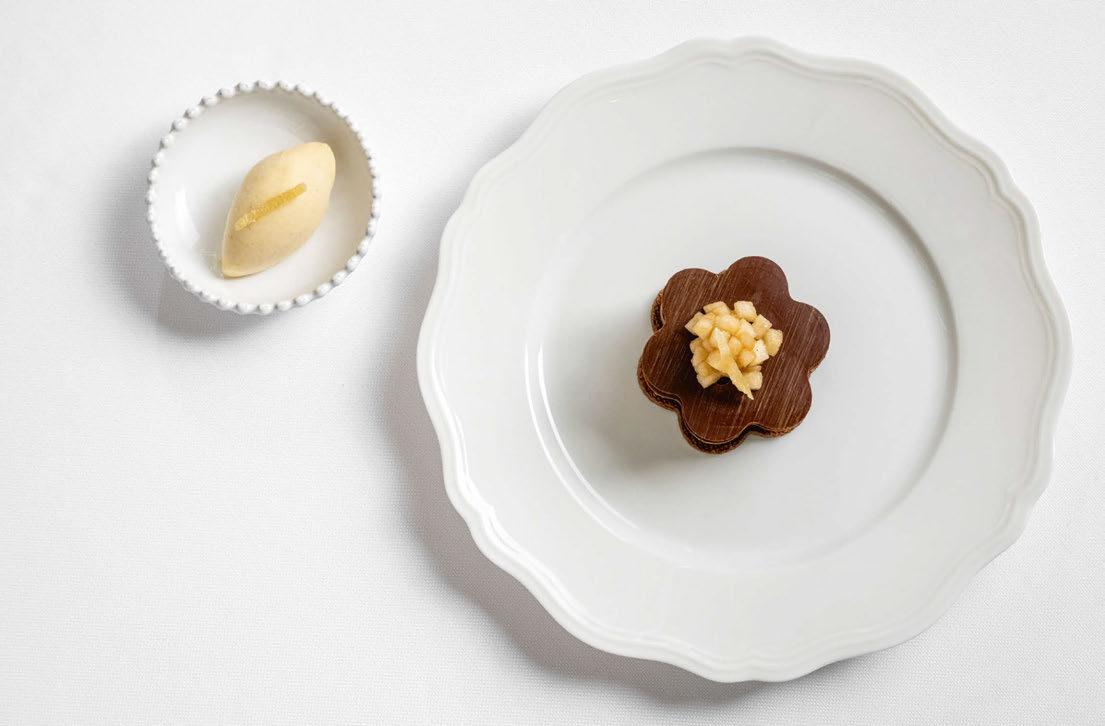
Brudnizki, who was tasked with transforming the restaurant. “The room needed to strike a balance between the history of the Gilded Age building and the relaxed formality that Chef Carmellini wanted to achieve.” According to Brudnizki, the room’s proportions called for “larger design moves”, so intimate brass balconies overlook the bustling dining room below, while the central landscape elements maintain classic symmetries.
Carmellini chose to lean into the Gilded Age references to honour his Italian immigrant grandfather, channelling his awe in arriving at turn-of-the-century New York as a young boy. The pièce de résistance here is the huge, illuminated eglomise peacock and Tree of Life artwork – created in partnership with Clifford Glass Studio in the UK – that decorates the bar, providing a dramatic backdrop for the bartenders dressed in slick white suits. This feature is bookended by a state-of-the-art exposed kitchen, which manages to incite intrigue as a focal point without intruding onto
the grandeur of the room. A vibrant blue and gold colour palette offsets the striking, verdant indoor landscaping.
Once settled into sleek leather and velvet banquettes, Instagram photos snapped, guests’ attention turns to the culinary offering. Although Café Carmellini’s menu evolves from season to season, there are several signature dishes to choose from, such as Chicken Gran Sasso for two, or Duck-duck-duck Ravioli, featuring minced duck, a glaze of duck sugo and a foie gras foam. Perhaps one of the most poignant and flavourful of Carmellini’s signature creations is the Scallops Cardoz, comprising sea scallops in a coconut curry sauce with basmati tossed in a ‘turka’ of curry leaf, cumin and mustard seed. He has dedicated it to his friend, the late chef Floyd Cardoz, whom he refers to as “the best Indian chef in the US”. The personal note is set to continue as the menu evolves, with Carmellini planning more tributes to chef friends such as Gray Kunz and Jean Louis Palladian in the future.
064
Café Carmellini’s menu evolves from season to season, with signature dishes including Chicken Gran Sasso (bottom right)

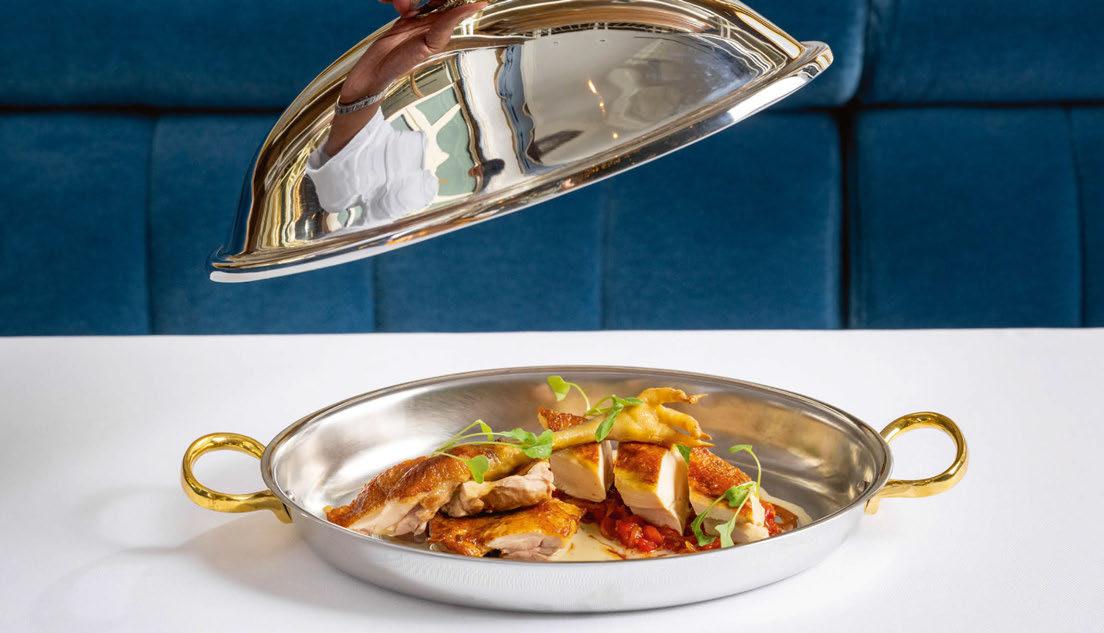
MAIN COURSE 065
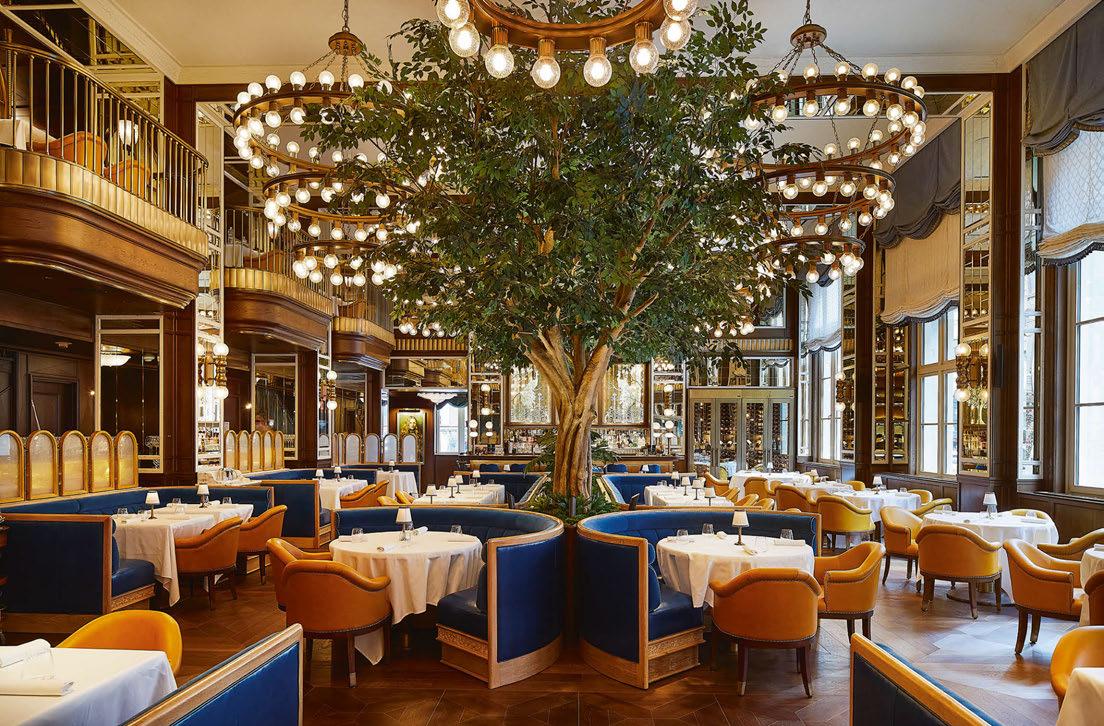
An equally important – and personal – addition is Carmellini’s 1,800-bottle wine collection. Bottles range from US$70 to US$10,000 and hail from France, Italy, Germany, Austria, Spain and Greece. Overseeing the curation is longtime collaborator and Wine Spectator honoree Josh Nadel and a team of six other sommeliers, all of whom pay particular attention to provenance when working with makers the world over. Asked about his experience with both standalone and hotel restaurants, Carmellini notes: “Every location is different and there isn’t a standard recipe for success. For me, part of that recipe is not opening a hotel restaurant but opening a great restaurant that is adjacent to a hotel. Usually, I’m attracted to properties where the primary space has street level entrance, so it doesn’t feel like a hotel restaurant.” He does admit that the requirement to serve multiple sittings when working with hotel operators can be demanding. “One of the biggest challenges is balancing all those meal periods,” he says. “It also depends whether you are in a city or
a resort: in a city, it doesn’t really matter how good the pancakes are (most guests may not even join you for breakfast), but you are going to get the guest to come in at 9pm in the same space, so it is important to plan that meal period out and think from that perspective.” At The Fifth Avenue Hotel, he is also behind the food offering at The Portrait Bar, where a menu of parlour snacks includes classic indulgences such as devilled eggs and foie gras tartine. Logistical challenges aside, Carmellini is clearly enamoured with the results of his new project. “Café Carmellini is the sum total of everything I am passionate about,” he states. “Nestled in this magnificent and historic landmark, it is my love letter to New York City. I want it to become a destination for New Yorkers and visitors to the city to feel transported, celebrated and warmly welcomed. And we are just getting started. I’ve been thinking about every aspect for years, so I’m quite happy with it. We just changed the menu for spring, so it’s exciting to see that take shape.”
IN A BITE
Operator: Alex Ohebshalom (hotel), NoHo Hospitality (F&B)
Architecture: McKim, Mead & White
Interior Design: MBDS
F&B Consultant: NoHo Hospitality Group
Owner-Chef: Andrew Carmellini
Chef de Cuisine: Kyle Goldstein
Head Bartender: Darryl Chan
Head Sommelier: Josh Nadel www.cafecarmellini.com
MAIN COURSE 066






A NEW COLLECTION WITH A HEART IN ITS HANDS
Synonymous with the art of plating, but also with the act of creation, each piece has been carefully designed and hand crafted with passion and care. Discover Art.Made and poetically rethink the enjoyment of being at the table, in presentation and in tasting.


hotelware.vistaalegre.com
abc kitchens
The Emory
LONDON
In the sumptuous environs of The Emory, acclaimed French chef Jean-Georges Vongerichten puts an elegant spin on market-fresh produce and zingy flavours.
Words: Shanna McGoldrick • Photography: Courtesy of Maybourne (unless otherwise stated)
Back in 2013, the humble pea found itself at the centre of a culinary controversy when the globally renowned French chef and restaurateur Jean-Georges Vongerichten made it the hero ingredient of the guacamole at his abc cocina restaurant in New York. More than a decade (and who knows how many tortilla chips) later, the dish has become one of the culinary magnate’s signature recipes, and it’s safe to say that the sweet green pulse has proven its credentials as a dip-worthy ingredient.
It’s no surprise, then, to see it on the menu at abc kitchens, Vongerichten’s new London opening, which brings the flavours of his New York abc trio – abc kitchen, abcV and abc cocina – to the British capital for the first time.
The venture, which sits within the ground floor of luxury operator Maybourne’s lavish new opening and London’s first all-suite hotel, The Emory, showcases highlights from all three stateside restaurants with a smash-hits all-day dining menu that amalgamates their culinary philosophies (farmto-table, plant-based and Latin-inspired, respectively).
The overall approach is driven by the abc brand’s trademark commitment to accentuating fresh, organic and ethically sourced local produce across its offering. Notable partnerships at the London outpost include The Wild Room, a British supplier famous for providing foraged produce such as elderflower and sea kale, as well as Dorset-based Portland Shellfish, which is known for its crab, lobster, scallops and clams plucked directly from the English Channel. Vongerichten leaned on his Executive Head Chef
Ben Boeynaems’ established relationships to kickstart the process of sourcing ingredients for the new restaurant, as well as carrying out extensive in-person research prior to opening. “Luckily, Ben knows a large network of suppliers, so we were able to meet local purveyors, try their ingredients to help decide which dishes emulated the same taste and feel as those in New York,” he explains. “We visited local farmers markets to further develop our connections and understanding of purveyors’ farming practices. It is an ongoing relationship that we hope to continue to grow and develop to work with the best, seasonal, local and organic ingredients, no matter the season. It is so important to me as a person, as a chef and as a restaurateur in New York and around the world.”
Michelin-starred Vongerichten’s food is famously light and confidently unfussy, with the chef eschewing the use of rich meat stocks and creams in favour of vegetable juices, broths and herbal vinaigrettes. At abc kitchens, this approach translates to a menu zinging with lively flavour and texture combinations that blend the sweet, the fiery, the citrus and the floral together with harmonious precision. The headline spring pea guacamole is snappy and refreshing, its garden sweetness peppered with sunflower seeds and green chili for a hearty kick, while the diver sea scallop tartare sees market-fresh shellfish diced with crunchy kohlrabi, nutty sesame and shiso for a bitter edge. Vegetables and greens take centre stage; the heirloom beet carpaccio with avocado purée manages to encapsulate summery, earthy sweetness,
068

MAIN COURSE 069 © Kensington Leverne
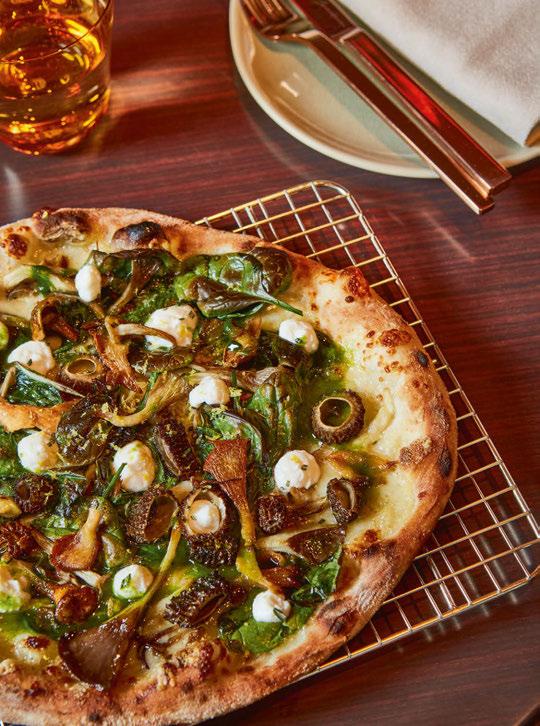
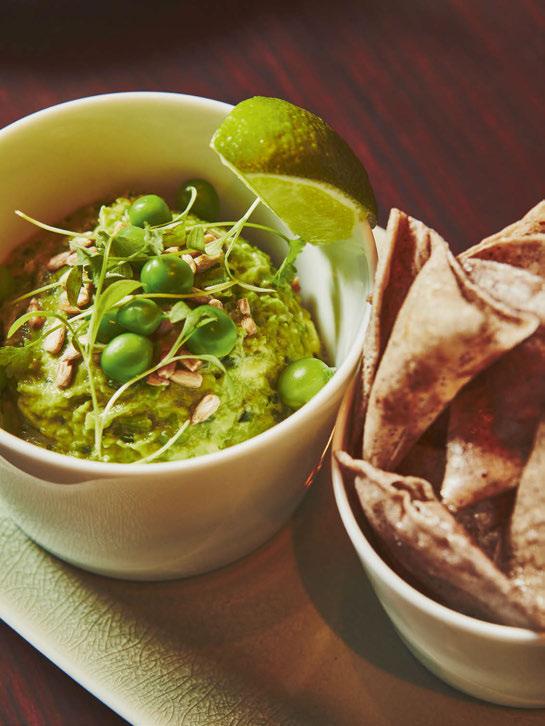
and the whole roasted cauliflower served with turmeric tahini, red zhug, pistachio and date molasses ensures that there is plenty to keep plant-based diners satisfied. Of the bountiful selection of meat and seafood dishes on offer, highlights include succulent grilled octopus with a moreish smoked paprika crème fraiche and a bold guajillo vinaigrette, as well as crispy Dover sole tacos featuring a tangy cabbage and apple slaw. While dishes such as ricotta ravioli and white asparagus with Amalfi lemon reference elegant Mediterranean fare, others, like the spicy arroz con pollo and the hearty dosa with coconut yoghurt and avocado, nod to more international influences.
Keeping things easy and relaxed was fundamentally important for Vongerichten. “I love the dosa with egg and sambal for breakfast, the Dover sole crispy tacos on the all-day menu and the white asparagus with sunchoke ‘hollandaise’, fresh herbs and Amalfi lemon,” he says. “The beauty of abc kitchens is that you can have a little bit of everything.”
The emphasis on natural ingredients carries over to the drinks menu, which features housemade turmeric and ginger tonics, as well as a series of refreshing cocktails celebrating the kind of bountiful farmers market produce Vongerichten is known for championing. A spring pea and herb martini blends spring peainfused sapling vodka with cocchi extra dry vermouth, mint dill and lemon, while a fruity mango mezcalita combines Mijenta Blanco tequila with Tres Tribus mezcal, champagne mango and lime for a concoction that is both juicy and sour.
The food might be effortlessly elegant in its simplicity, but when it comes to the space itself, abc kitchens is an unabashedly glamorous affair. Parisian design studio Rémi Tessier’s arresting interior concept includes statement industrial details such as exposed steel pillars that play to the progressive architectural spirit and pared-down aesthetic of the building – an audacious structural proclamation created by the late Richard Rogers and Ivan Harbour. Yet
MAIN COURSE 070
The menu at abc kitchens showcases highlights from all three of Vongerichten’s abc restaurants in the US

NYEWOOD, ROGATE, PETERSFIELD, HAMPSHIRE, GU31 5HZ Tel: 01730 821811 Email: office@johnjenkins.co.uk NEW YORK SHOWROOM, 41 MADISON AVENUE, 9TH FLOOR, NEW YORK NY 10010 Tel: 1-800-818-8484 www.johnjenkins.co.uk A perfect cocktail...the perfect glass Glassware for Professionals Casablanca

the room also indulges in the specific brand of seductive charm that has become a Maybourne hallmark. “As this was one of Richard Rogers’ last projects, we really wanted to do something different; honour his legacy and the relationship we have with Maybourne by bringing to life this idea we had been percolating on for many years,” says Vongerichten.
Though the restaurant is contemporary in its outlook, the sharp edges of modernity have been softened with its furnishings, including a colossal Orobico Rosso marble block and a 12-metre curved couch that cocoons diners while drawing the eye to the open kitchen at the end of the room. A colour palette of warm wood tones paired with copper, blush pink and pale grey hues creates a chic background for The Secret Garden Paintings, an invigoratingly colourful Damien Hirst series that lines the walls. While the full-height windows that look onto leafy Knightsbridge offer plenty of natural light, once the evenings draw in, abc kitchens transforms into an intimate jewel
of a restaurant, its John Jenkins glassware twinkling in the glow of the wine cave – an enormous amber glass structure housing the venue’s curated collection of cuvées that also serves as an oversized lantern. The ambience manages to strike the balance between intimacy and conviviality: even the private dining room, which seats up to 10, offers views of the pass and dining room thanks to its open-plan design.
Fittingly, Vongerichten uses the word “organic” to describe his relationship with Maybourne; the partnership dates back some seven years, to the opening of Jean-Georges at The Connaught, and the decision to launch the new venture came about quite naturally. “We have been discussing the idea of abc kitchens for quite some time now,” he divulges. “Thanks to our longstanding relationship with Maybourne and immediately striking up a fast friendship with Rémi Tessier, we felt as if it was the perfect time and place to introduce the concept to London and to the world. It was a case of right time, right place.”
IN A BITE
Operator: Maybourne
Architecture: Richard Rogers and Ivan Harbour
Interior Design: Rémi Tessier
Executive Head Chef: Ben Boeynaems
General Manager: Mike Walker
Glassware: John Jenkins
Coffee Machine: La Marzocco
www.the-emory.co.uk
MAIN COURSE 072
© Kensington
Leverne
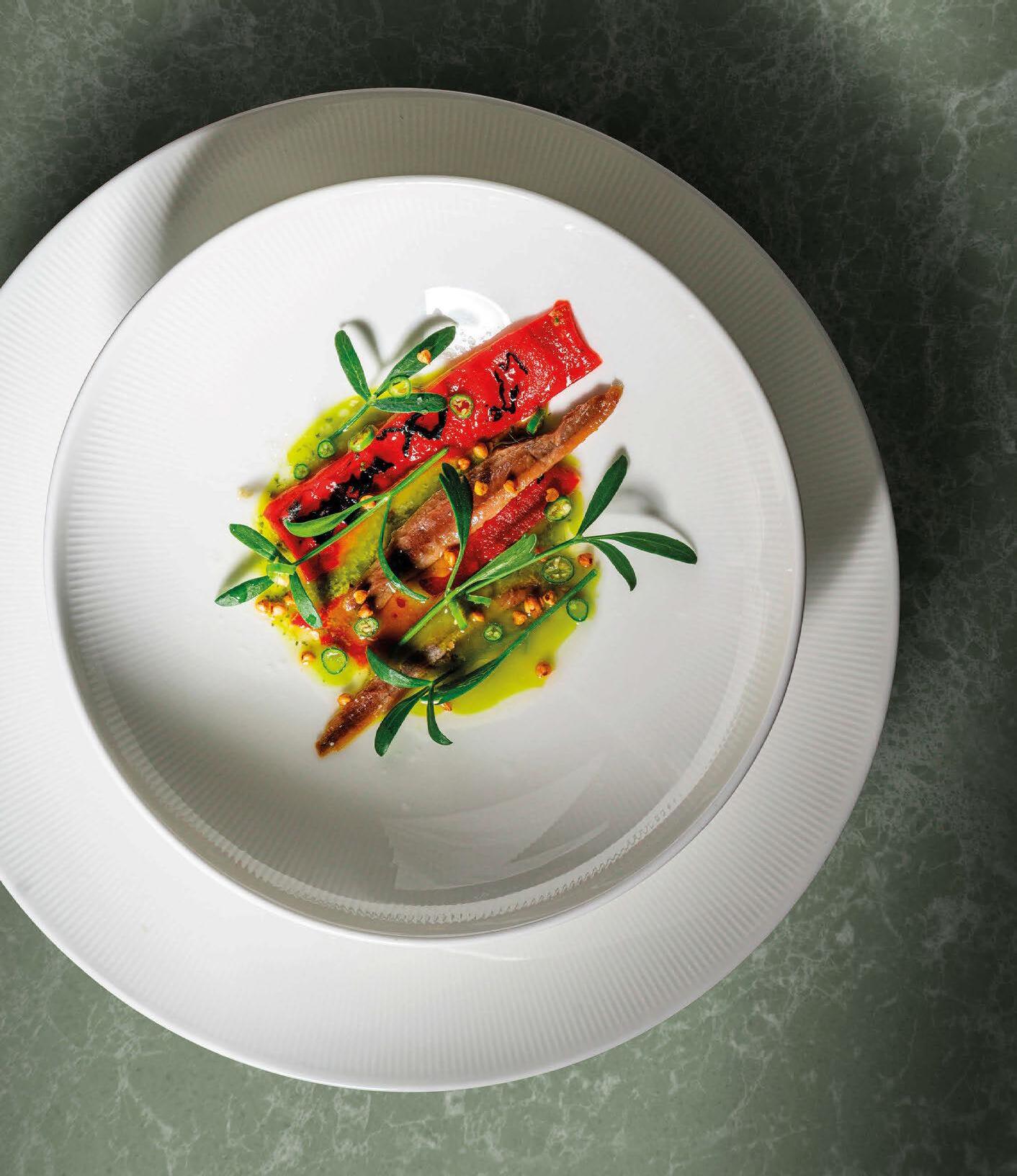
Lina.
Timeless elegance

Rice Pudding
Maslina Resort
HVAR
Retro desserts that recall childhood have been enjoying a resurgence in the restaurant world for some time now, but at the luxury coastal Croatian property Maslina Resort, culinary nostalgia has been given a grown-up makeover. Using homegrown produce and simple techniques, the humble rice pudding has been upgraded to a sophisticated and elegant dish that pairs surprising flavour profiles for an evocative tasting experience.
“The idea was to reinterpret something many of us used to eat in childhood and craft it into something modern,” says the resort’s Pastry Chef Ema Križ, whose iteration of the traditional dish

is found on the menu. “We hope to bring out some forgotten memories with every bite.”
Maslina’s rice pudding combines fennel grown at the hotel with lemons procured from a neighbouring property for a bite of acidity, softened by the sweetness of locally-grown raspberries. The rice is cooked slowly in fennel milk before being decorated with lemon gel, fresh fennel, raspberries and crispy fennel for a complex layer of textures and flavours. “It offers sweetness, acidity, crunchiness and creaminess, all at the same time,” says Križ. “It represents something traditional, but with our modern take. It’s all about creating memories.”
SIGNATURE
SIGNATURE
© Nikola Radovani
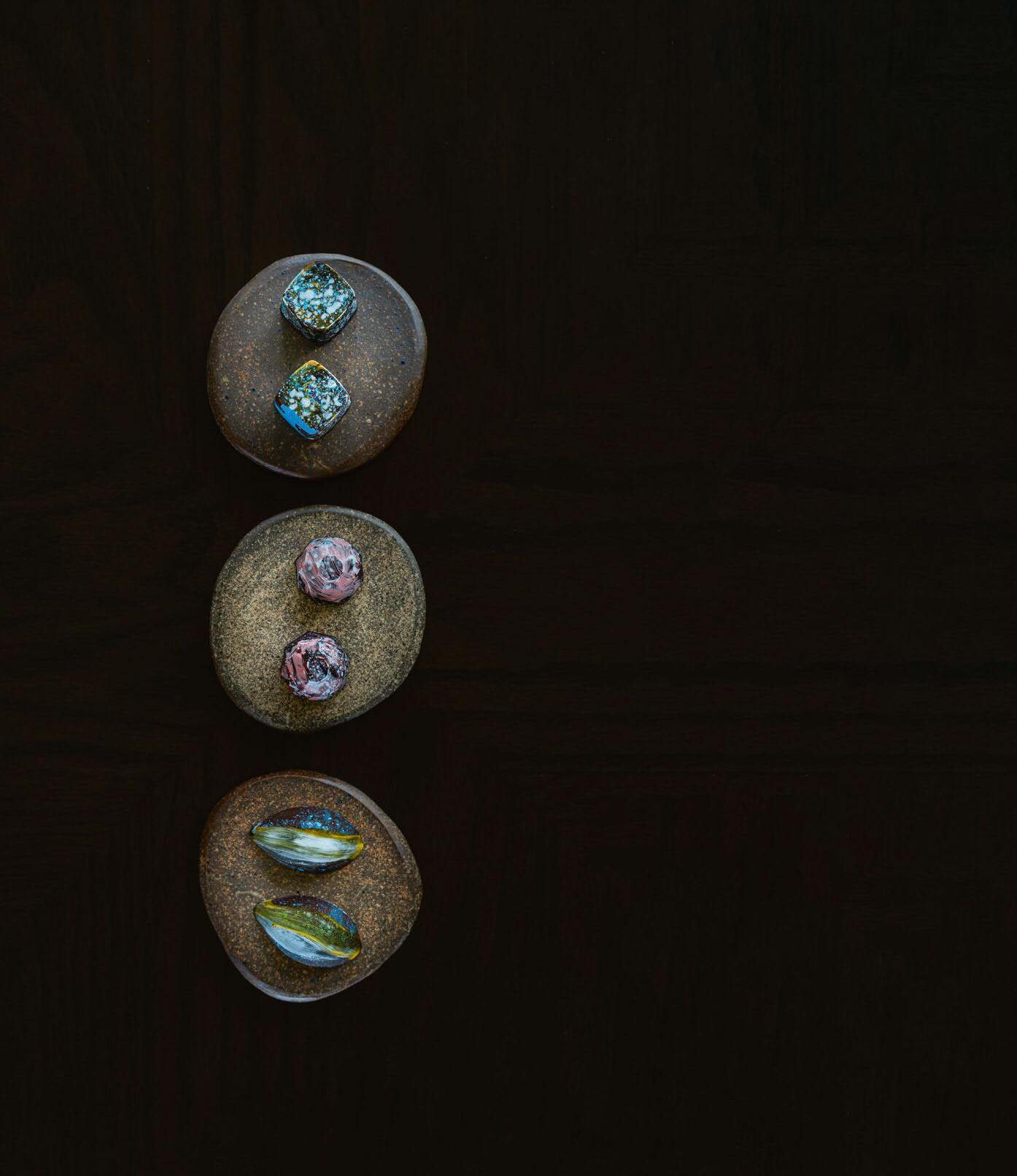
Chocolate Pralines Pru Trisara Resort
PHUKET
Blue cheese and chocolate might not be the most obvious culinary pairing, but at Phuket’s Michelin-starred restaurant Pru, the combination has garnered rave reviews as part of a memorable petit four dish that evolves with the seasons to spotlight rare Thai ingredients. A trio of post-dinner chocolates, which is typically served with tea or coffee to conclude the gastronomic experience at the fine-dining ‘community-to-fork’ venue, sees milk, dark and white chocolate pralines (all made in-house) stuffed with adventurous and unexpected fillings such as fermented strawberry and basil flower, black fruit chutney and blue cheese fudge.
“We wanted to showcase the best chocolate from Phuket,” says Executive Chef and CoOwner Jimmy Ophorst of the dessert, which features chocolate that comes from a farm not far from the luxury beachfront resort’s location, nestled in the lush foliage of a cove overlooking the Andaman Sea. “We see the unique and unusual fillings as our personal Pru touch, to match the memorable dining experience that comes before it.”
Though the chocolate itself is produced locally, the dish – which highlights the contrasting flavour profiles of buttery white, rich milk and bold dark chocolate – changes throughout the year to highlight seasonal produce from across Thailand. Recent fillings have included mak mao mountain berries and sweet persimmons, but it’s the sweet-savoury pairing that really captures the imagination. “The blue cheese is my personal favourite,” admits Ophorst.
SIGNATURE
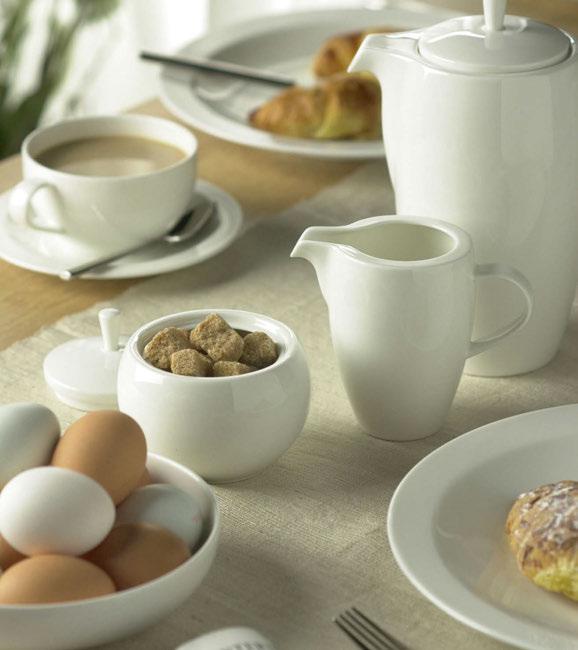



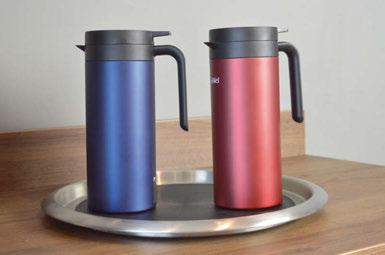
Where form and function combine perfectly and quality is paramount. At Elia, innovation is second nature.
Elia. Serving Professionals.
Elia International Ltd Unit 3, Elia Close High Wycombe HP12 4FX United Kingdom Tel +44 (0)20 8998 2100 sales@elia.co.uk www.elia.co.uk
Plant Power
Vegan cuisine has taken root in the hospitality industry’s kitchens: now, select hotels are placing plant-based philosophies at the heart of their entire operations.
Words: Kayleigh Rattle
It’s now several years since plant-based dining’s meteoric rise in popularity, and veganism is firmly embedded in the international food scene. Growing numbers of people worldwide are eschewing (or reducing their intake of) meat and other animal products: a 2023 report by Meticulous Research suggested that 2.6 million Europeans – approximately 3.2% of the population – are now vegan, while the comparison site Finder recently put the number of UK-based vegans at 2.5 million, or roughly 4.7% of the adult population. According to Statista, the global vegan food market is expected to reach a value of over US$27.8 billion this year.
Naturally, the hospitality sector has responded in kind, with some 48.4% of restaurants across the US now thought to offer vegan options, according to figures from the trade body Plant Based Foods Association.
The hotel industry has shown remarkable agility in adapting culinary offerings to tap
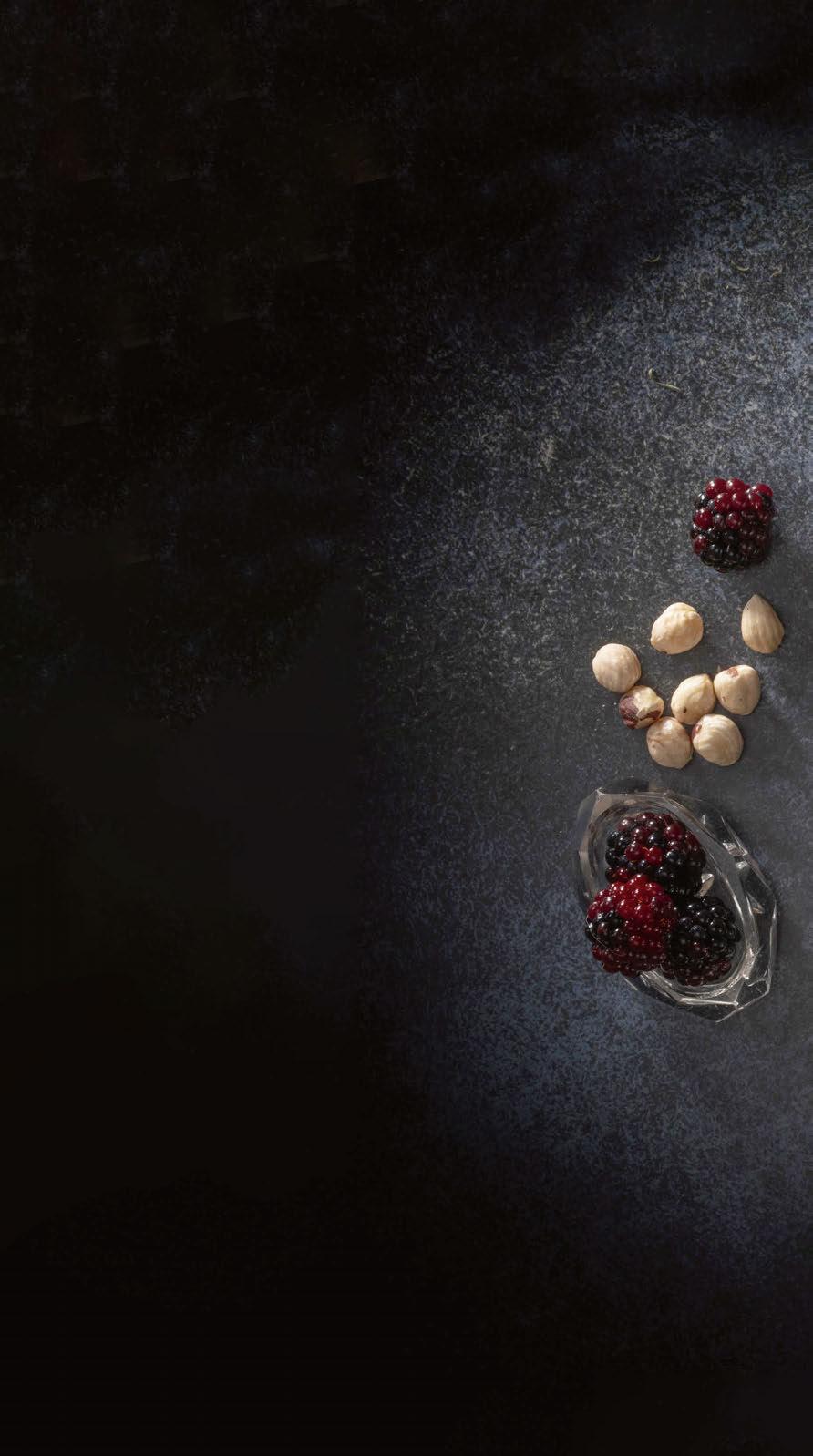
into the trend, with most major operators now featuring a selection of plant-based dishes on their menus. In 2019, Hilton took things a step further when it launched an entirely vegan suite at its Hilton London Bankside property, teaming up with the multi-sensory design experts Bompas & Parr to create a fully vegan guest experience. Highlights of the space include a plant-based keycard, Piñatex leather headboard and 100% renewable and sustainable Moso Bamboo flooring, while the paper and ink making up the in-suite stationery have been vetted for traces of animal products and even the hotel’s housekeeping trolleys refreshed to eliminate any cleaning products that have been tested on animals.
The move foreshadowed what was to become a burgeoning hospitality trend, particularly in the boutique segment: the rise of the vegan hotel. But not all of these properties are exclusively plant-based – some, like The Stanford Inn & Resort in Mendocino, California,
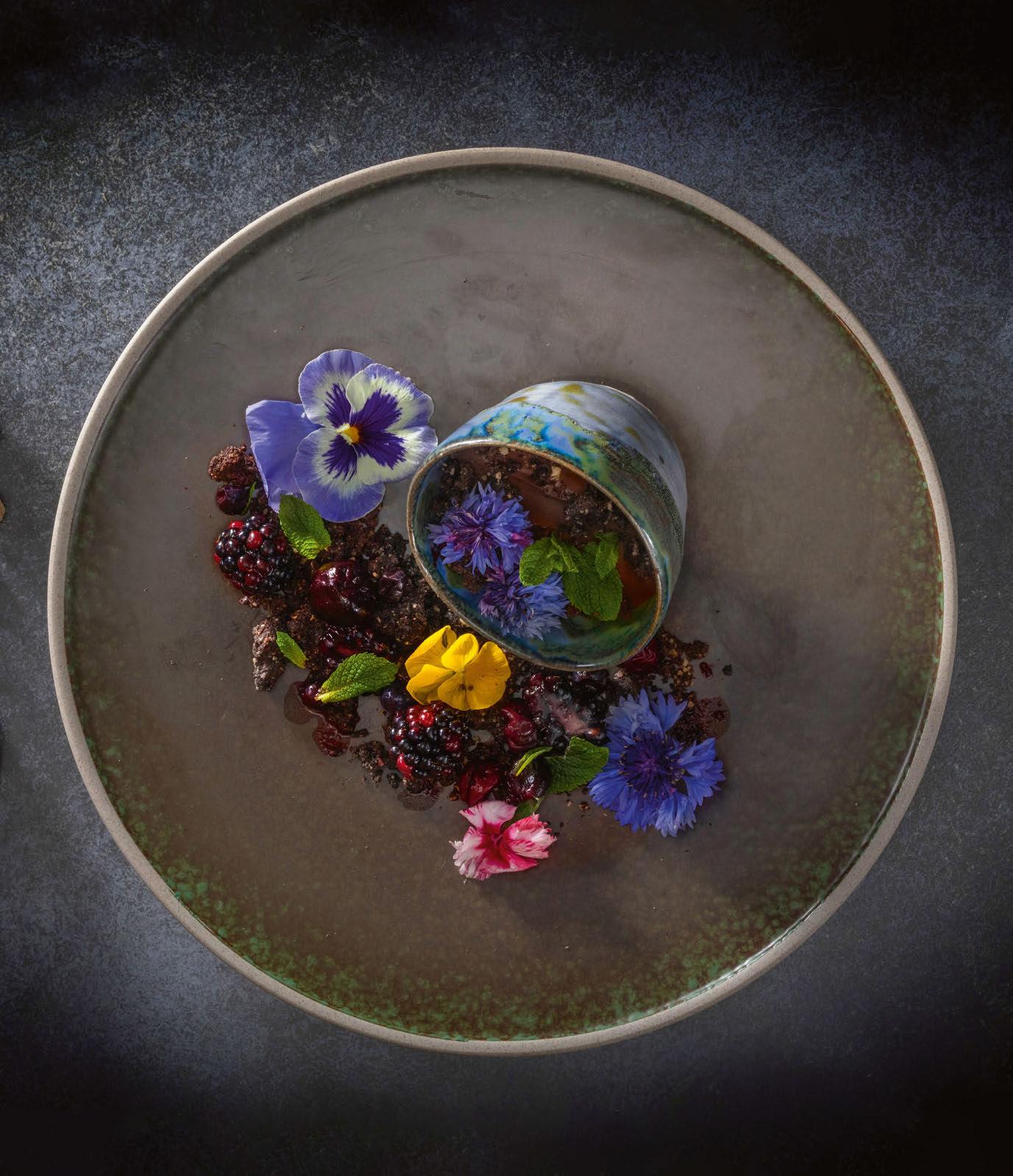
DINING
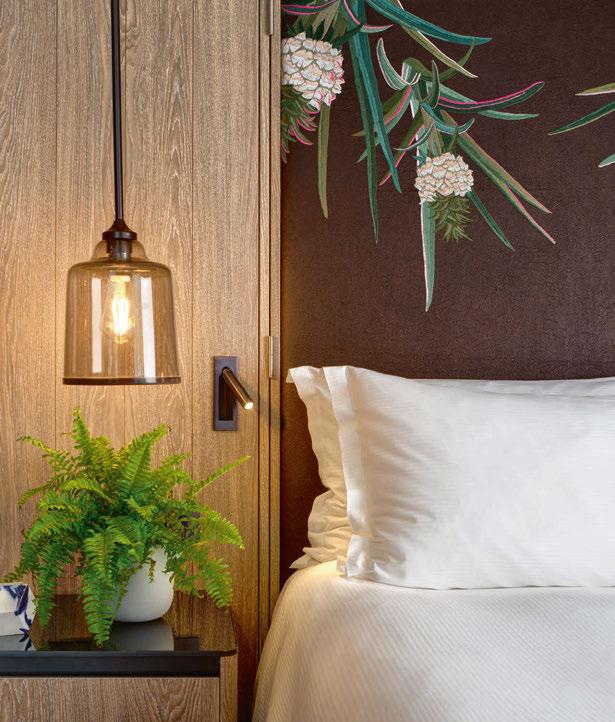


 © Mark Weeks
© Daniel Turbert
Photography/The Stanford Inn
© Mark Weeks
© Daniel Turbert
Photography/The Stanford Inn
still cater to meat eaters. The property features an onsite USDA-certified organic farm that supplies produce for many of the dishes served at the in-house Ravens Restaurant, whose menus lean heavily on wholefoods and locally sourced ingredients, spanning everything from enchiladas to a kalua mushroom and coconut rice dish and a sea palm Pad Thai. “We were very much at the forefront of the farm-to-table movement in the 1980s – although back then it wasn’t a movement, it’s just how we wanted to live,” says co-owner Jeff Stanford. “From an ethical standpoint, we eschew all animal products for humane reasons, and of course, because it’s better for the planet.”
Stanford points out that pivoting to an exclusively vegan menu might not be appropriate for all client bases. “The demand for delicious, plant-based cuisine continues to grow, but at the end of the day, it’s critical to understand your own customer base and what they are looking for,” he says. “Have conversations with your guests; offer plant-based alternatives and see how well those offerings do. Do you have enough of a potential customer base to sustain a fully plant-based menu? If not, you can still incorporate a wide variety of plantbased options while also catering for omnivores. If you want to pivot entirely to a plant-based menu, consider bringing in a chef and a team that have experience in plant-based cuisine, or hiring a consultant.”
Formal culinary training in plant-based dining proved to be the key to success for Louise Macbeth, co-owner of the historic Beck Hall, a former yeoman’s cottage located in the bucolic Yorkshire Dales in the UK. Having launched the award-winning hotel with her husband Andrew
“Ultimately, our goal is to satisfy vegans, as well as to prove to non-vegans that eating meat-free can also be utterly satisfying.”
GEORGIA KONTIZA, KOUKOUMI VEGAN HOTEL
Macbeth in 2014, the couple made the property fully plant-based in 2023 and it has since won PETA’s Best Luxury Hotel Award. Earlier this year, Macbeth graduated from the prestigious school Le Cordon Bleu London with a diploma in plant-based culinary arts, in order to inspire and develop vegan menus at the hotel, ranging from breakfast options to lunch, Sunday roasts and à la carte dishes.
“Since opening Beck Hall 10 years ago, we’ve always strived to create authentic experiences that are true to our values,” Macbeth explains. “During this time, as a family we began to realise the ethical implications of our animal consumption, as well as the huge environmental and health implications of the world’s massive appetite for meat and dairy. This was the start of a journey to us becoming a vegan family.”
Experimenting with different ingredients at home led to the creation of several plant-based dishes that non-vegan friends also loved, convincing them to take the plunge. She recalls: “We soon realised we had to make Beck Hall England’s first fully plant-based hotel. It was a risk, but one we’re so glad we took – we’re busier than ever.” The decision was the reflection not solely of an ambitious business goal, but also of the couple’s personal commitment to their mission to “create a compassionate and sustainable dining experience for our customers and show that plant-based cuisine accommodates many dietary preferences and can be utterly delicious.”
They’re not alone in this quest. Georgia Kontiza, founder and General Manager of the five-star island bolthole Koukoumi Vegan Hotel in Ano Mera, Mykonos, knew that she wanted to make her parents’ hotel entirely plant-based
when she took it over. “Being vegan for the last few years, I could not imagine myself serving meat in Koukoumi’s restaurant,” she explains. “When I set up, I searched for a vegan chef with the same principles and passion as me – one that thinks outside the box, experiments with the ingredients Earth provides us and creates strong emotions and extraordinary flavours. Ultimately, our goal is to satisfy vegans, as well as to prove to non-vegans that eating meat-free can also be utterly satisfying.”
A plant-based breakfast, lunch and dinner is served at Koukoumi, and there’s also the option to enjoy a fine-dining and a ninecourse degustation menu. At the helm of the hotel’s restaurant is chef Aggeliki Charami, who combines local ingredients with Japanese cooking methods to create food that ‘stimulates the senses and awakens the memories’. Innovative dishes include Hidden Garden, an artichoke and potato risotto served with aubergine soil, truffle and nettle powder, and a leek souvlaki glazed with buckwheat and lentils. For breakfast, scrambled tofu is served alongside avocado, confit tomatoes and sourdough. For guests keen to learn more about plant-based cuisine, the hotel also offers cookery classes to inform and inspire.
But it’s not just the food that’s plant-based: Kontiza has taken a holistic approach to the concept that reaches throughout the property. “You won’t find animal products in our kitchen or equipment,” she says. “Everything is crueltyfree; therefore no leather, wool, feathers, meat, fish, dairy, wax, honey or caviar. From the custom-made mattresses to the spa products that are certified organic and the sunbeds made from recycled plastic, everything here has been
081
DINING

thoroughly and consciously searched for, with a lot of love, care and commitment.”
In Italy’s South Tyrol, the vegan hotel La Vimea also champions a sustainable lifestyle, led by a healthy plant-based cuisine. “We are sustainable idealists focusing on a healthy vegan cuisine, deep relaxation, blissfulness and a small ecological footprint within a healing ambience,” explain its founders in a statement. Likewise, at Mod Santorini, owners Anargyros and Christina state: “Having a vegan hotel is about all aspects, the animals, the food, the environment, to be conscious of every decision we make. We just knew there would be likeminded humans who share the same passions as we do, and for us owning a hotel is more than just a hospitality service, it is a joy we get to share with our community every day”.
As well as needing to source chefs with the right level of expertise and creativity to present plant-based cuisine in new and innovative ways to guests, are hoteliers and restaurateurs encountering any further obstacles financially
or operationally in their pivot to plant-based business? “Finding chefs with knowledge, experience and passion for plant-based cuisine can be challenging,” says Macbeth. “It’s also a challenging time for hospitality with increasing overheads, so we were concerned that the move to plant-based would result in a drop in business that would be unsustainable. However, having strong business foundations – a fantastic streamside location in one of England’s most popular villages, a brilliant team and an already popular restaurant – gave us the confidence to transition. We’ve been completely overwhelmed with the response, with future bookings up 45%.” She concludes: “Some of our team members were hesitant about the change, but they have embraced it and have been surprised and delighted by the positive response. We love seeing so many of our non-vegan regulars trying out our menus and loving them and we’re lucky to have an established kitchen team that’s open to innovation and continually improving and evolving our offering.”
082
DINING
Californian property The Stanford Inn & Resort caters to both vegans and meat-eaters via its organic farm
© Courtesy of The Stanford Inn
Bespoke products for front-of-house
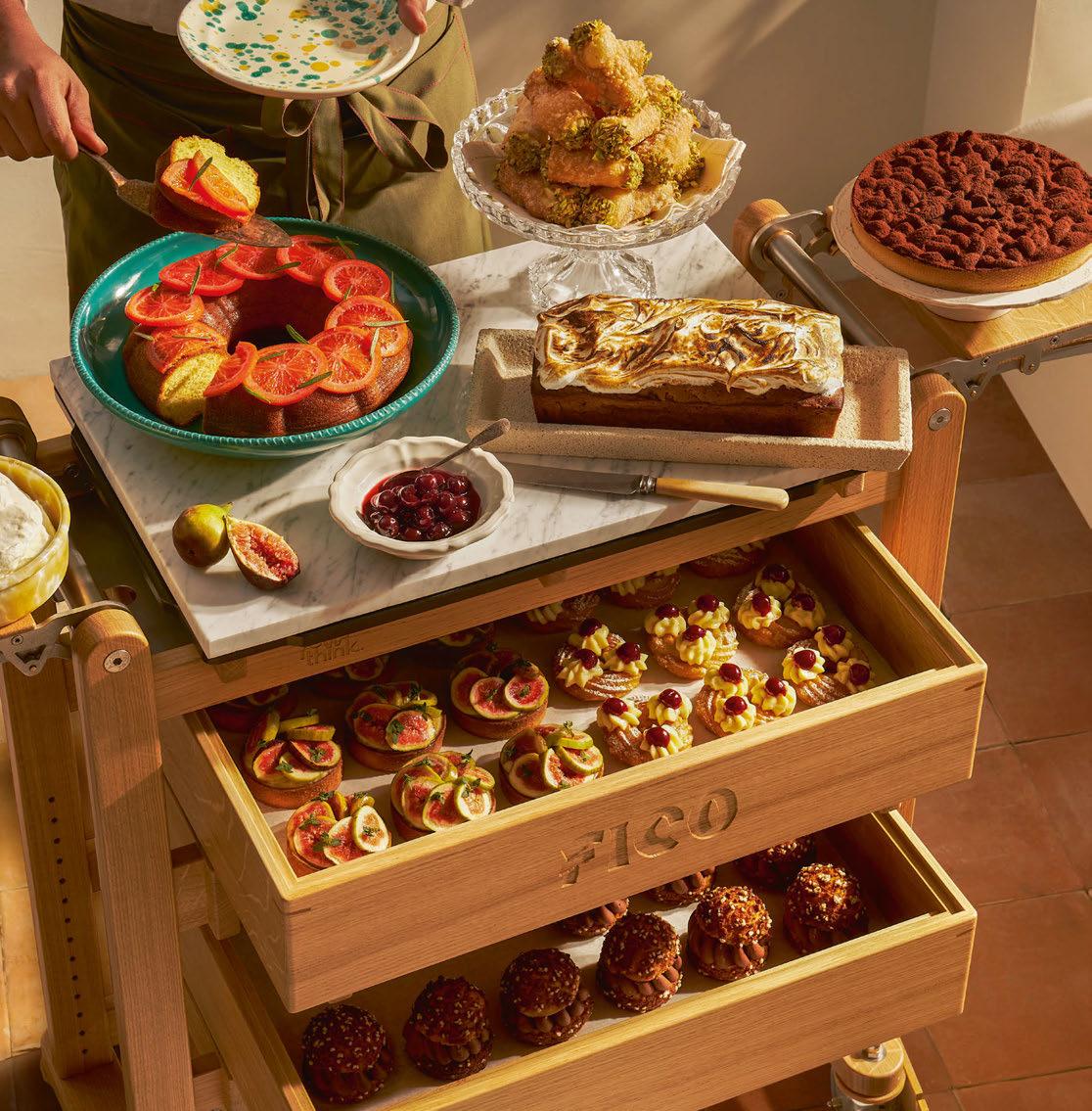
www.rewthink.co.uk
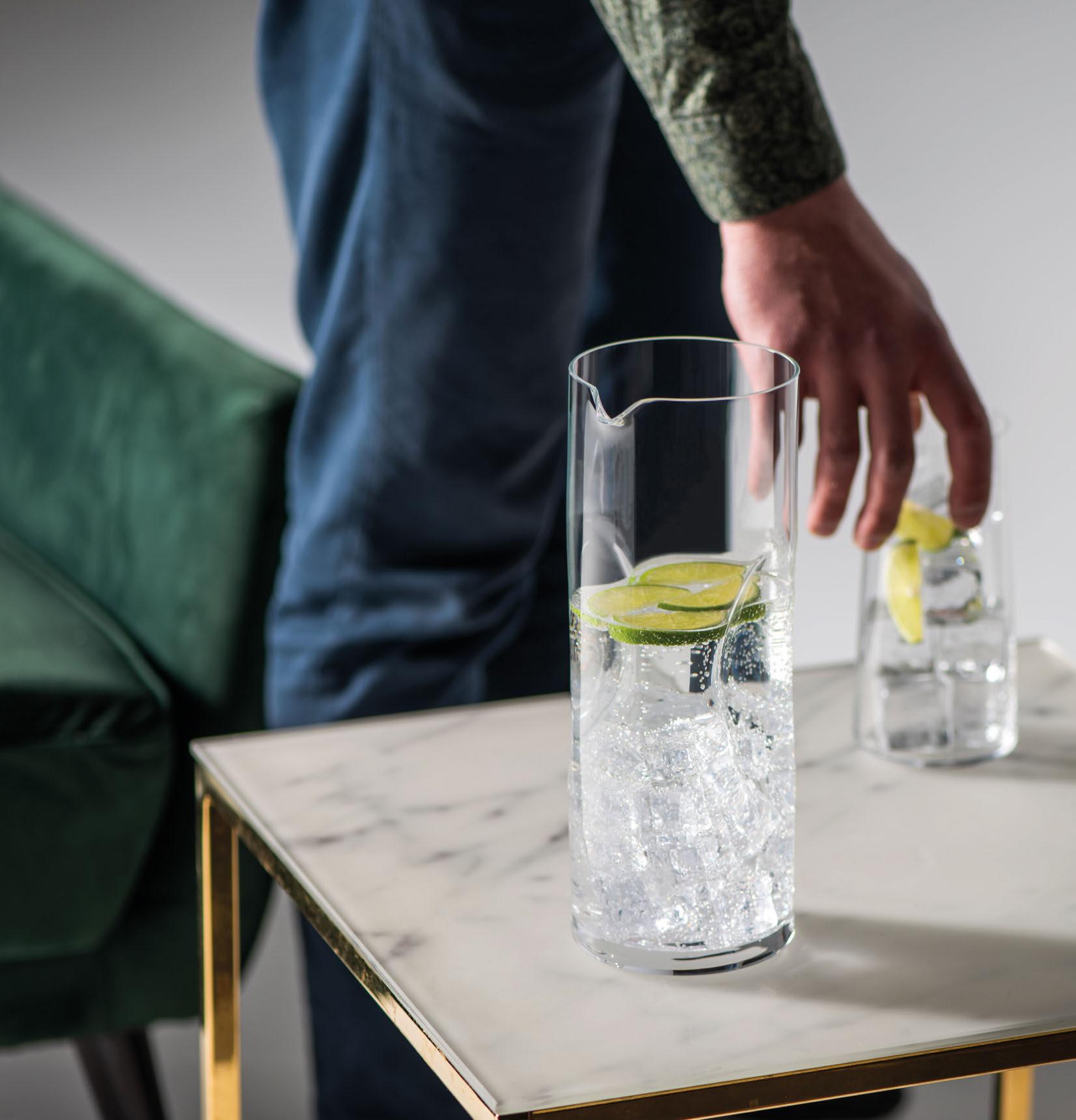
APÉRITIFS
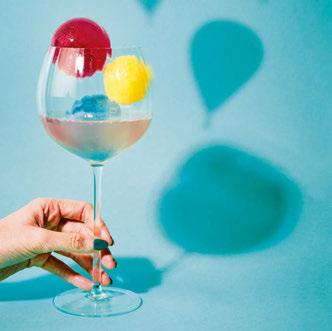
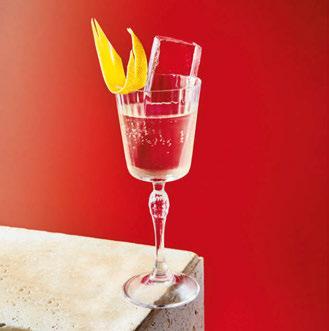

MGallery’s Month of the Cocktail
“Mixology is an ideal way to summon the essence of a place through sight, smell and taste,” explains Catherine Cherabieh, Vice President of Global Marketing at MGallery.
“It’s a universe that demands real expertise; over the years, we have built an expert team of local mixologists.”
This team of specialists – taking up residency behind the bar at MGallery properties around the world – are often at the forefront of the imbibing experience, developing cocktails that combine native ingredients with storytelling.
Tapping into their local expertise, Head Mixologist Matthias Giroud, founder of drinks brand L’Alchimiste, has created a collection of cocktails and mocktails that celebrate MGallery’s global destinations through flavour and presentation. There’s The Cappadocian Lantern, featuring colourful ice spheres in the spirit of the hot-air

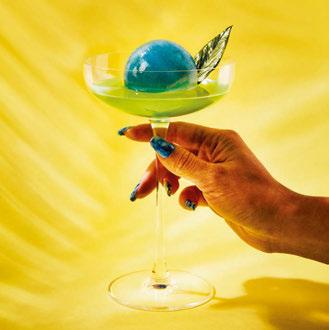
balloons that float over the Turkish region; The Italian Limonaia, a citrusy concoction garnished with an ice cube that leans like the Tower of Pisa; and The Sunfire, adorned with a golden embellishment in honour of the layered spires of The Grand Palace in Bangkok. The Symphony nods to the architecture of Sydney’s famous Opera House, while The Brazilian Rainforest is topped with leafy greens.
Complemented by food pairings and a series of workshops, the drinks were served at MGallery hotels during World Cocktail Month in May, with the aim being to encourage multi-sensory discovery. “MGallery and I wanted to create a flavourful journey inspired by the raw ingredients of each country,” concludes Giroud. “Each of our signature cocktails and mocktails take guests on a multi-sensory experience.”
The Cappadocian Lantern
The Italian Limonaia
The Sunfire
The Brazilian Rainforest
085
The Symphony

Chef’s Chardonnay
Michael Caines has long championed the produce of Southwest England through his culinary creations at Lympstone Manor, so where better to source ingredients for the accompanying drinks programme than the hotel’s own grounds? In celebration of its seventh anniversary, the Devonshire country house has launched its first white wine, made from the fruits of its vast estate. Planted in 2018, the vineyard is a passion of Chef Patron Caines, with the new release marking a key milestone in his journey to produce high quality English wine.
Named Edwards after longstanding Director of Operations and Vineyard Manager Steve Edwards, the Lympstone Manor Estate Chardonnay is developed in partnership with Devon’s Lyme Bay Winery. The barrel-aged tipple is made from chardonnay grapes that have been fermented in French oak, resulting in subtle notes of almond and toasted oak with a hint of spice.
“The chardonnay is a truly exceptional wine, inspired by the confidence that we gained when we made our first classic cuvée,” comments Caines. “I knew then that a still chardonnay wine of outstanding quality was possible, but it took until the 2022 harvest for us to achieve that ambition. The wine itself is a testament to the outstanding year where we had an exceptional crop.”
CGA by NIQ Winning Drinks Sales in Ireland’s Hotels and
Restaurants: Five Insights
A new report from CGA by NIQ reveals how drinks suppliers can secure sales and share in Ireland’s hotels and restaurants. The channels account for a combined 18.9% of the nation’s Long Alcoholic Drinks (LAD) sales by volume, and, despite a recent decline in rate of sale, remain a key market. Here are five insights to help brands stay ahead:
RESTAURANTS GAIN SPIRITS SHARE
While their share of LAD sales has fallen, restaurants have fared better with spirits over the past 12 months, with volume sold rising by 1.4%. Across the market, spirits have gained visibility through cocktail listings, while LAD brands have traditionally relied on bar tap and fridge facings, so new path-to-purchase strategies may be required.
ROS BETTER IN IRELAND’S CITIES
Regional breakdowns show that LAD brands perform better in city centre venues than rural areas. In Dublin, for example, rate of sale has increased by 2.4% over the last year, but has dropped by 11.9% in rural Munster. This highlights a need to tailor strategies by region.
LAGER THE MOST POPULAR LAD IN HOTELS
Within the LAD category, CGA’s research indicates that lager remains the most popular choice; 23% of consumers choose it on visits to hotels and 21% with casual meals. Lager sales typically rise in line with the temperatures, so summer is a good time to introduce new brands.
STOUT AND LOW/NO GAIN SHARE
Although lager remains the top choice, stout has shown the greatest growth in the LAD category, increasing its share by 1.2% in hotels and 1.7% in restaurants. Low and no alcohol brands have been another category winner, gaining 0.6% in restaurants, outpacing growth in bars.
RECOMMENDATIONS ARE KEY TO PURCHASE
Understanding a guest’s path to purchase is vital if suppliers are to influence decision making. While bar purchases are still most popular in hotels, 39% prefer to order at the table from a server, so working with venues to secure menu listings and support from waiting staff can substantially improve brand visibility. With 26% of people selecting drinks based on recommendations, positive word of mouth is crucial too.
To explore further insight from CGA by NIQ, visit www.cgastrategy.com
086 APÉRITIFS



PLEASE DRINK RESPONSIBLY PREMIUM TEQUILA BLANCO EARNED. A REPUTATION SANTOSPIRITS.COM Tequila – 40% Alc. by Vol. (80 Proof) imported by Los Santos, LLC. Las Vegas, Nevada. Santo Fino and the cross logo design are registered trademarks of Los Santos, LLC. ©️2024 All rights reserved.
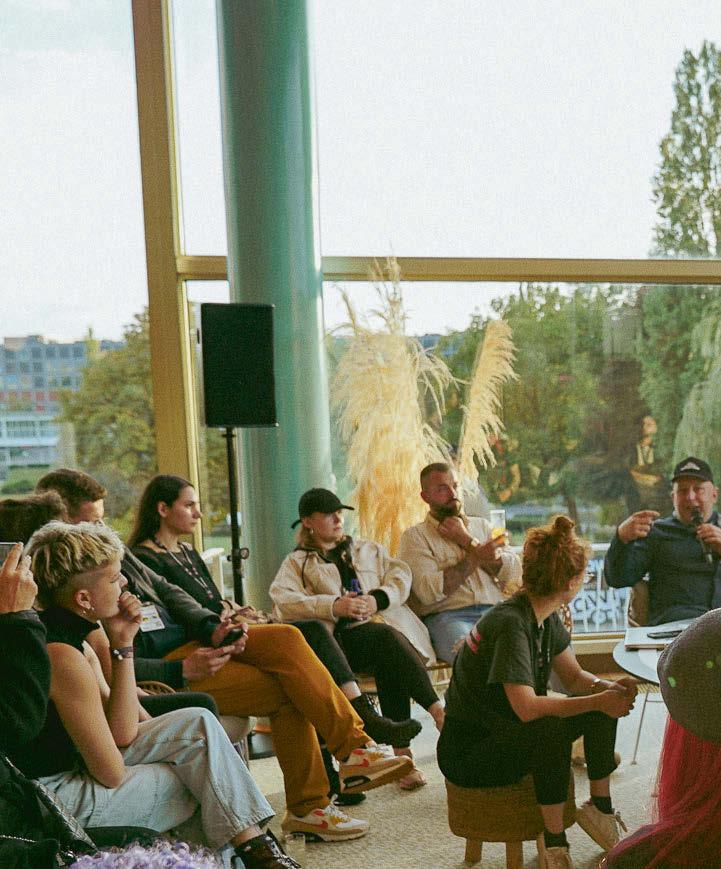




No Rush
Mirror Bar
Radisson Blu Carlton Hotel
BRATISLAVA
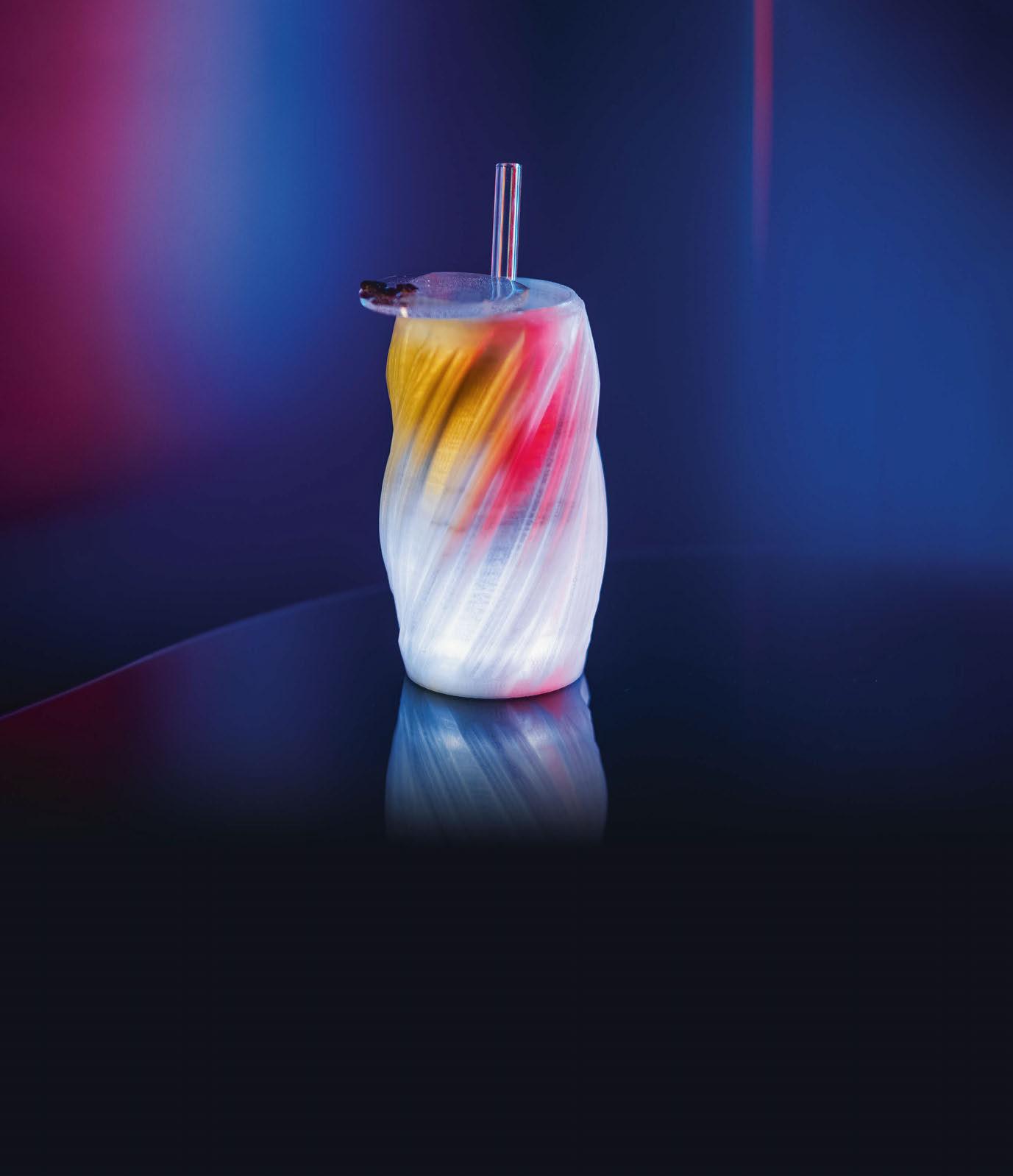
Patience is a virtue at Mirror Bar, Radisson Blu Carlton Hotel’s immersive watering hole in the heart of Bratislava’s Old Town. The establishment, whose reputation for avantgarde mixology earned it the 90th spot on The World’s 50 Best Bars in 2023, offers a sensoryrich cocktail programme that fuses elements of both art and nature.
One of the stars of the menu is No Rush, a theatrical and beguiling-looking concoction that guests are often stunned to find out is non-alcoholic. “The inspiration for this drink was to help our guests slow down and enjoy the moment,” says Bar Ambassador Stanislav Harcinik of the cocktail.
The central element of the libation is cold brew coffee and kombucha, which are combined
and cooked with oranges and spices and left to ferment for at least two weeks. The mixture is then layered with Nochino, a non-alcoholic Slovak pomegranate-based aperitif, as well as a blend of spices, herbs and fruits, including cranberry, aronia, star anise, cloves, grapefruit, roses, quinine and Sichuan pepper. An organic acid solution and a dash of dry tonic provide the finishing touches, with the ingredients poured directly into the glass, over ice. The result is a smooth, layered drinking experience.
“I love how complex this cocktail is,” says Harcinik. “It has an unexpected flavour profile that is carried by the fruitiness of specialty coffee Kombucha together with bittersweet combinations from the tonic and the Nochino. The guests are always surprised.”
COCKTAIL COCKTAIL
© Chrzi
Buttered
Scotch Uga Residence
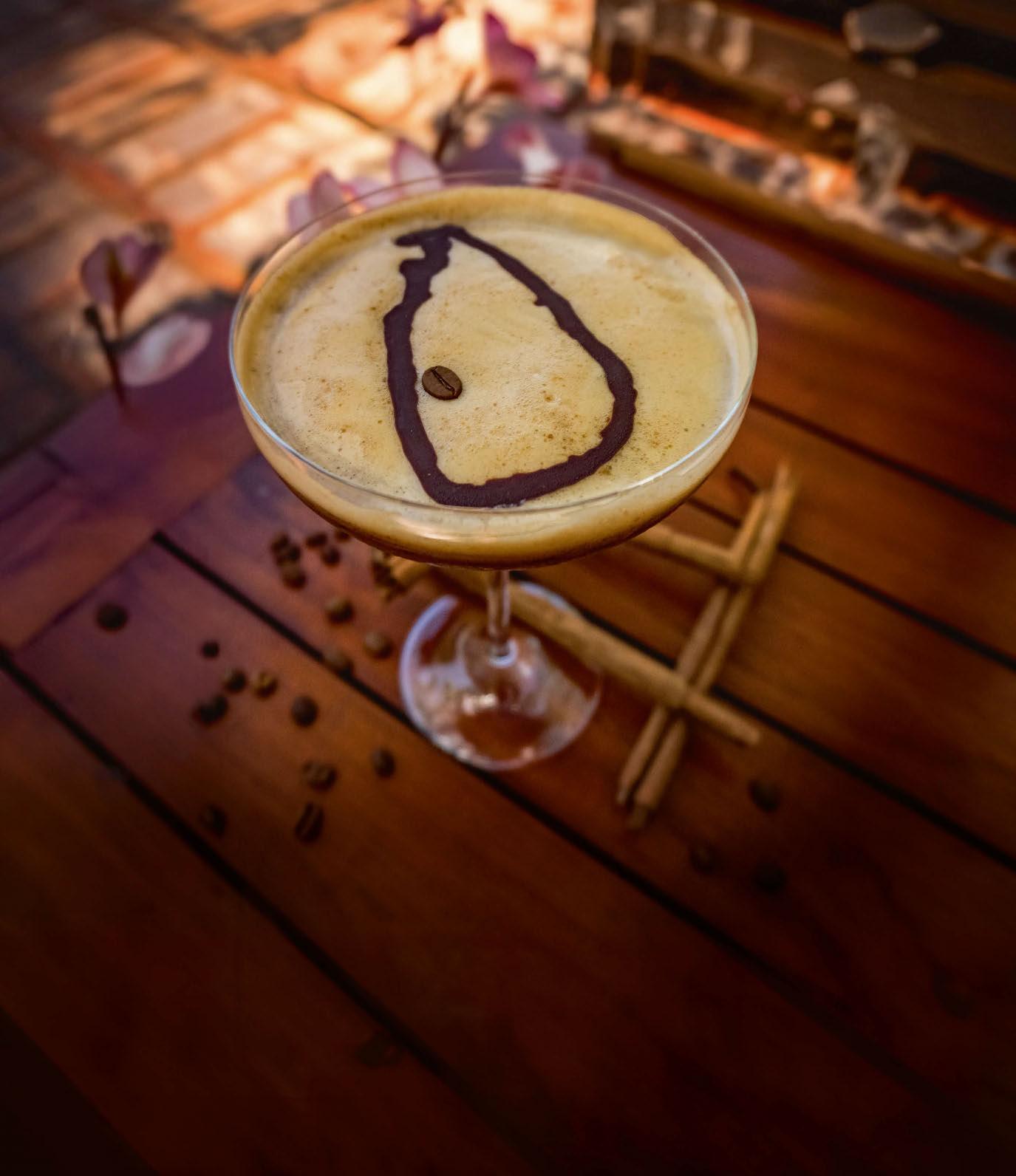
Sri Lanka might be famous for its tea fields, but a 180-year-old mansion house in a leafy corner of Colombo is paying homage to the island nation’s traditional coffee rituals, instead. At boutique hotel Uga Residence, Head Mixologist Shan Jayasena has crafted an elegantly sentimental whisky cocktail that acts as both cultural reference and memorable digestif.
Buttered Scotch blends Ceylon coffee with whisky, Kiri Kopi liqueur and three dashes of homemade smoky Sri Lankan cinnamon bitters, with heady and flavourful results. “This nostalgic nod to the island’s coffee heritage serves as a testament to the enduring influence of tradition on modern-day creations,” says Jayasena. “My
aim is to forge a connection between the rich heritage of the old island and the vibrancy of the present day.”
To make the drink, Jayasena combines all the ingredients with ice and shakes until cold. The liquid is double strained into a champagne coupe and garnished with a symbolic coffee bean that sits within an outline of the island. Jayasena’s favourite aspect of the drink is the inclusion of Kiri Kopi, a beloved local liqueur known as butter fat-washed scotch whisky that is made using similar techniques to making butterscotch. He says: “The fusion of these elements adds a touch of familiarity and also elevates the drink with a delightful complexity that truly sets it apart.”
COCKTAIL
COLOMBO


City
Elevate Your Space with Urban-Inspired Elegance Orrefors NYC Showroom, 41 Madison Ave, 9th floor (800)-351-9842 | info@orrefors.us | www.orrefors.us You can easily order your Orrefors Crystal through Singer Equipment Co. www.singerequipment.com/lmt
Designed by Martti Rytkönen
“The Best Rum, Period”
— LA Spirits Awards

“Ten To One’s Caribbean white rum is among my all-time-favorites for cocktails.”


“Ideal for both mixing or enjoying on the rocks... full of buttery molasses, cedar and vanilla”
The brainchild of proud Trinidadian, Marc Farrell, Ten To One is a contemporary and elevated spirit, designed to challenge expectations, and reinvigorate the way people taste, experience, and talk about rum.







tentoonerum.com | @tentoonerum 94
DRINKS

Altamura Distilleries
Altamura Distilleries Vodka
Located in Southern Italy, the city of Altamura is the birthplace of Pane di Altamura, the only bread in the world to achieve PDO status. Altamura
Distilleries uses the exact same wheat used in the baking of this bread, sourced from a single family that has been farming this unique wheat for over a century, in the distilling of its spirits. The hard durum wheat of Altamura, which dates back over 2,000 years, imparts an umami taste and smooth mouthfeel described as ‘morbida’ in Italian. The Italian distillery’s premium vodka express the terroir of the region and captures the essence of the special wheat in every sip. www.altamuradistilleries.com
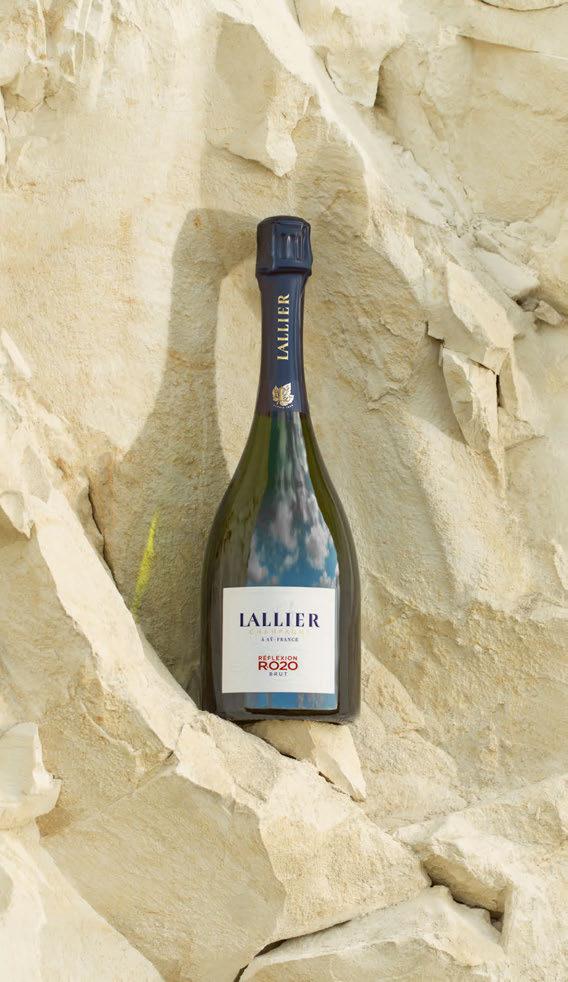
Champagne Lallier R.020
Traditionally, non-vintage champagne strives for the same consistent product year after year, yet Champagne Lallier’s Réflexion expressions employ a contemporary winemaking approach: staying true to the individual character of the year’s harvest, while always maintaining the house’s signature style. The latest iteration is R.020, a brut non-vintage cuvée made mainly from grapes harvested in 2020 – a year with near-perfect growing conditions thanks to dry and sunny weather, making for an intense, elegant and persistent wine with white flower flavours and strong notes of fresh citrus. R.020 is aged for a minimum of 30 months, which is double the requirement for a brut champagne. In the Réflexion collection, and for the first time, chardonnay overtakes pinot noir, at 51% in the blend. The ‘dosage’ in this iteration is low at 7g per litre in line with Lallier’s philosophy. The launch of R.020 also marks the start of a new chapter for the Réflexion series, revealing a brand-new identity and design: an intricate vine leaf, embossed across the label, symbolises the house’s deep connection to terroir and commitment to nature. “In R.020 Brut cuvée, we aim to show a representation of the year 2020, which was a fruitful one in Champagne, and of course the perfect balance between the four atmospheres of Lallier’s style: freshness, purity, intensity and depth,” says Dominique Demarville Lallier Cellar Master and General Manager. “I am honoured and proud to be able to contribute to the Réflexion cuvées that Lallier releases (almost) every year and look forward to this special blend being enjoyed across the globe.” www.champagne-lallier.com
094

Ten To One Rum
White Rum, Dark Rum and Five Origin Select
Caribbean rum brand Ten To One has launched Five Origin Select, a new blend of rums aged up to 15 years, highlighted by the inclusion of 11-15 year old Guyanese rum distilled on the famed Port Mourant double wooden pot still – the only one of its kind still in operation. Brought together alongside signature rums from Trinidad, Barbados, Dominican Republic and Jamaica, and bottled at 92 proof, Five Origin Select has mild acidity, a medium body and a long, clean finish. Featuring notes of crème brûlée, hazelnut, baking spice, orange zest and stewed stone fruits, this expression unfolds to reveal cacao, vanilla, peppercorn, toffee, hazelnut, ginger and crisp apple. Five Origin Select is the latest addition to Ten To One’s award-winning rum portfolio, standing alongside white and dark rums, each of which are suitable to be enjoyed on their own or within a cocktail. Founded by Marc Farrell in 2019, Ten To One is a brand designed to challenge expectations and reinvigorate the way people taste, experience and talk about the spirit. www.tentoonerum.com
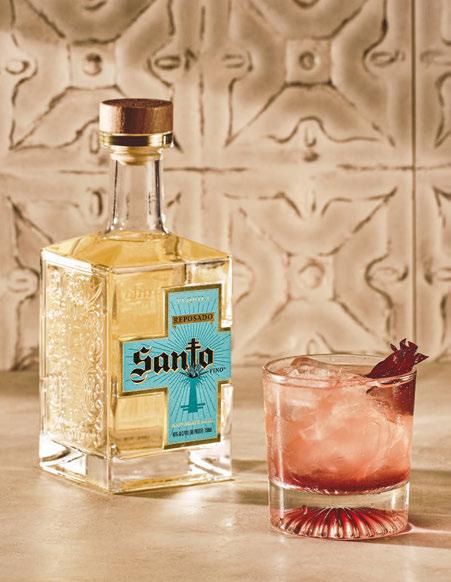
Santo Spirits Santo Tequila Reposado
Born in 2019 from a decades-long friendship between legendary rockstar Sammy Hagar and internationally renowned chef Guy Fieri, Santo Spirits is an awardwinning tequila company with a portfolio comprising a Blanco, Reposado, Añejo and 110-proof Blanco Tequila, along with Mezquila – the world’s first tequila and mezcal blend. Paramount to their vision, all Santo Spirits products are additive-free and carefully crafted using traditional methods that allow the agave to shine through. In Spanish, reposado means “rested”, and true to its name, Santo Reposado is an ultra-premium tequila that rests in the barrel for around four to five months, allowing enough time to deliver the slightest hint of oak. Santo Reposado offers aromas and flavours of banana, pineapple, green papaya, lime, peanut, sesame, and Thai basil, with a satiny, lively, medium body, and medium-long finish, with notes of mild peppers, coconut, lime, salt, white pepper and honeycomb. www.santospirits.com
DRINKS 095
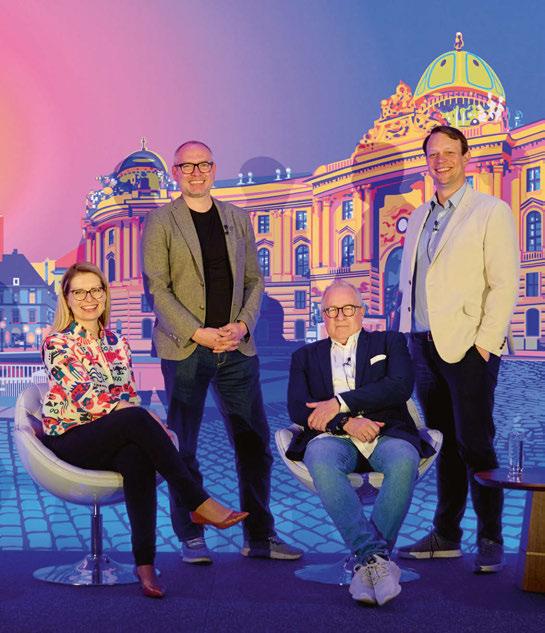
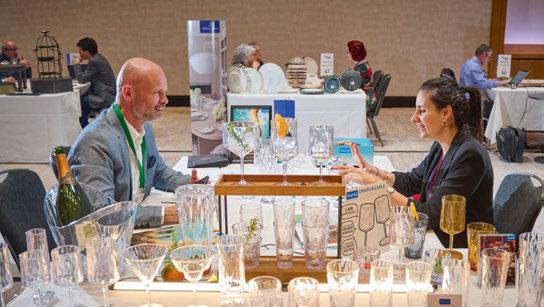

To The Table 22-24 April 2024
VIENNA
Decision-makers and suppliers reunite in the Austrian capital to talk all things F&B.
Words: Matt Turner
Photography: © Richard Pereira
Their largest event to-date, To The Table’s latest Europe edition held at Hilton Vienna Park, was a huge success. Over a three-day programme, 60 senior decision-makers from across the spectrum of hospitality food and drink – F&B executives and consultants, culinary directors, procurement professionals and designers – participated in a series of face-to-face meetings with 50 suppliers, offering a wide range of F&B solutions spanning tableware, glassware, drinks, bar equipment, coffee machines, buffet stations, minibars, tech solutions and more.
The event kicked off in true Viennese style with a networking reception at the Hilton’s Selleny’s Bar, with the resident mixologists keeping the drinks flowing – courtesy of a Lillet-sponsored aperitif cart and bespoke cocktail menu by Pernod Ricard and Mikki. A roast beef carving station and a variety of sweet and savoury strudels provided added sustenance.
Snap Events founders Debbie Wilson and Justin Wall opened the event, introducing a local luminary of the hospitality F&B world, Christine Meinl, fifth generation custodian and Managing Director of iconic Vienna coffee house brand Julius Meinl, who welcomed attendees to her home city, encouraging attendees to take the opportunity to sample its unique and famous café culture.
The following morning saw Supper contributor
and regular To The Table talks host Heleri Rande open the seminar programme with a deep dive into ‘Forecasting the Future of Hospitality in Europe’, with Nicolas Marzioni, Vice President F&B EMEA for Marriott International, and David Martin, Global Head of Restaurants & Bars for Corinthia Hotels.
Key topics included embracing local and seasonal produce, addressing staffing shortages, enhancing breakfast and in-room dining experiences, and drinks trends such as low- and no-alcohol options. Both participants highlighted the need to cater to evolving guest preferences, leverage technology and adapt to market nuances while maintaining authenticity and quality of execution. The key message was that hotels need to remain agile, innovative and customer-centric in their F&B offerings.
Interspersed between the conference sessions were a procession of meetings with the industry’s leading suppliers, allowing them to discuss their latest products, solutions and innovations whilst discovering project demands and requirements from the attending F&B decision makers. These pre-requested meetings were run with characteristic efficiency by Snap Events’ operations team, the Hilton’s Grand Park ballroom providing a spacious and airy backdrop to vendors’ artfully curated tabletop displays.
The second seminar session focused on effective
096

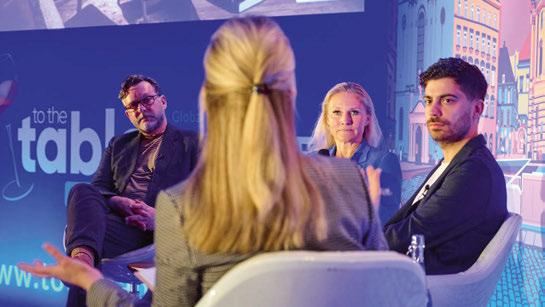
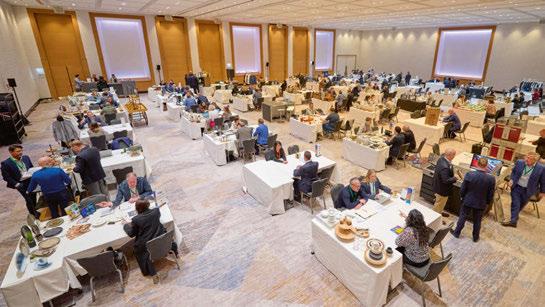

strategies for sustainability. Speakers brought individual perspectives from different angles: hotel operations (Neil Grosset of IHG), interior design (David Chenery of Object Space Place), and product supply (Jesper Efferbach, founder of Jeff & Co.) Their wide-ranging discussion covered circular economy practices, navigating the plethora of green certifications, and the challenges in implementing ESG strategies.
Grosset emphasised the importance of creating pockets of excellence within organisations to drive culture change such as IHG’s cross-discipline ‘Green Gang’, which highlights best sustainable practices within the group and enables their team to share these with other owners, regions and brands. Efferbech and Chenery discussed the role of design in reducing material waste and embodied carbon. Examples included an innovative brewery, using food waste from hotels and restaurants to make their beer, and the potential to re-use materials in restaurant fit-outs.
The panel agreed on the need for collaboration and trust between different stakeholders –including owners, operators, consultants and suppliers – to overcome bureaucratic barriers and implement sustainable solutions.
While the first day of the conference had focused on ways to deliver exceptional F&B experiences for guests, the evening cocktail reception and dinner showed these principles in practice. Delegates were treated to a sumptuous evening’s entertainment, replete with string quartet, in the opulent environs of the Hotel Imperial, a Luxury Collection property, which is also one of Vienna’s best loved grandes dames.
Day two kicked off with a conversation between representatives from hotel groups Shangri-La and Ennismore and design firm Blacksheep, exploring ‘Customer Engagement and the Power of Branding’. Recurring topics included the need to forge partnerships with local businesses, to integrate storytelling elements into marketing efforts, and the creation of immersive guest experiences that resonate with both locals and guests.
The panel explored experiential rewards through loyalty programmes, the role of technology in enhancing guest experiences and the potentially nefarious impact of social media influencers in marketing efforts. Andrew Antoniades of Ennismore gave insights into ‘Disloyalty’, the game-changing programme with which it is hoping to disrupt the
conventional hotel loyalty scheme. “We offer instant access for an upfront fee,” he stated, whilst Paul Mann of Blacksheep bemoaned traditional loyalty programmes, “which you never seem to be able to use when you want to”.
Katerina Dixon of Shangri-La Group pointed to the value of collaborations, such as fourhands dinners and chef residencies, as well as partnerships with local bakeries and markets to immerse guests in the local community.
The final discussion saw Takuya Aoyama, Vice President of Development EMEA for Hyatt; Andrzej Szymczyk, Development Director for Poland and Eastern Europe at IHG, and Jelena Kasina of Mogotel Hotel Group focus on development trends in Eastern Europe.
Once the meetings and talks programme had concluded, guests decamped to the Salonplafond, a sustainable and organic restaurant within the MAK – Vienna’s Museum of the Applied Arts, for a closing dinner reception, which capped off the event with a night to remember but also food for thought.
The next To The Table event will take place in Abu Dhabi from 7-9 October 2024. www.tothetableeurope.com • www.tothetablemea.com
EVENTS 097
PETITS FOURS
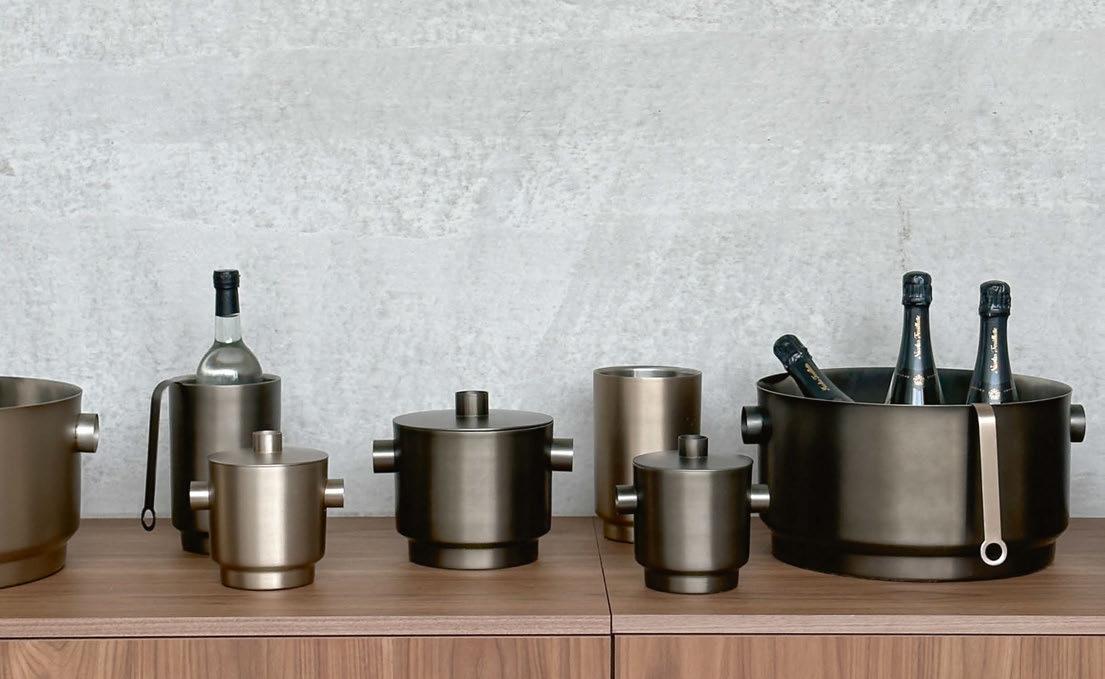
Founded by Geert-Jan Van Cauwelaert and Ann De Cock in 1997, Belgian design brand XLBoom has built an impressive reputation within the hospitality sector for its innovative approach to contemporary design. The Antwerp-based company consistently delivers elegant pieces designed to elevate a variety of living spaces in both indoor and outdoor settings, maintaining a commitment to quality and expert craftsmanship through a process that ensures that each item is handmade from start to finish, with all pieces designed in the brand’s head office and brought to life in one of its international atelier spaces. XLBoom’s mission is to produce objects that, in addition to fulfilling a functional need, evoke intense emotions and create a pleasant, luxurious atmosphere in every setting.
This ambitious corporate philosophy is encapsulated by the Rondo collection, which embodies the brand’s dedication to excellence. Envisioned by the design studio Sascha Sartory – which believes that a good product is ‘emotional, functional and timeless’ – each handmade piece reflects great attention to
detail and creative expression. The range spans multiple different pieces, including an elegant stainless-steel wine chiller designed to keep drinks at the perfect temperature down to the very last drop. The collection also comprises a statement tray that can be used to display wine and ice buckets or used as decorative pieces, with the option to stack two different sizes for an even more majestic effect, and a generously proportioned ice bucket that comes in three different colours and two sizes, to allow it to integrate seamlessly with a range of interior design projects. A stylish pair of ice tongs completes the series.
Available in three different finishes – copper, black and pure stainless steel – Rondo offers exceptional versatility for a variety of hospitality settings and environments. Thanks to its clean lines and minimalist aesthetic, the series adds a touch of sophistication to a range of situations. XLBoom’s extensive collections are available to view by appointment at its European showroom near Antwerp. www.xlboom.com
098
XLBoom Rondo

Craster Flow 1.1 Cooling Tray
Introducing one of Craster’s latest innovations: the Flow 1.1 Cooling Tray. This elegant and advanced cold cell cooling tray showcases chilled gastronomic creations to their best potential, making use of improved cooling performance compared to previous models. The new cold cell technology maintains a food-safe slate presentation area at temperatures below 8°C (46°F) for up to four hours. Focused on operational efficiency, the updated Flow PCM pack enhances cooling duration through a PCM aluminium encased cell within an EPP insert, topped with a natural slate. The tray is available in whitewashed, black lacquered, natural oak or walnut finishes, making it a suitably stylish solution for a wide variety of hospitality settings, and the product is compatible with 1.1 and 1.2 Flow Tray sizes.
British brand Craster offers an extensive portfolio of solutionled systems created to meet the specific requirements of a range of hospitality environments. The company prides itself on its consistently seamless customer experience, as well as the longstanding partnerships it maintains with many of the world’s top hospitality brands. Its flexible and stylish solutions reflect the dynamic needs of an ever-evolving industry, and have seen it become a supplier to a number of five-star hotels, with Four Seasons, Marriott, Hyatt and Hilton Worldwide among the major groups it has worked with in the past. www.craster.com

Rewthink Bespoke Front-of-House Products
With an expertise that comes from creating front-of-house products for the world’s best chefs and restaurateurs for over a decade, British brand Rewthink’s designs are as functional as they are stylish. The company’s classic service tray is one of its most recognisable pieces: featuring hallmark ‘inside-out’ handles and a low frame profile that maximises all the available space, its stackable design makes it both a practical and fashionable choice. The board’s fully rounded edges and easy-to-grip handles mean that it is remarkably durable and comfortable – more than meeting the essential requirements of any busy restaurant or commercial kitchen. Rewthink trays are available in a range of designs, sizes, materials and finishes.
Since 2012, Rewthink has focused exclusively on products for the hospitality industry, and today the brand designs complex front-of-house items in a range of materials. Though it specialises in bespoke and customisable boards, trays and trolleys, the company has also crafted presentation boxes, tea stands, handbag stools and a variety of other individual hospitality solutions. All products are designed and made in-house, with many crafted from European oak sourced from managed forests. Other materials that feature in its designs include American black walnut, stone from Cumbria in the UK’s Lake Distict, brass, steel, copper, glass, leather, silicone and acrylic. www.rewthink.co.uk
099


HEAD OF THE TABLE
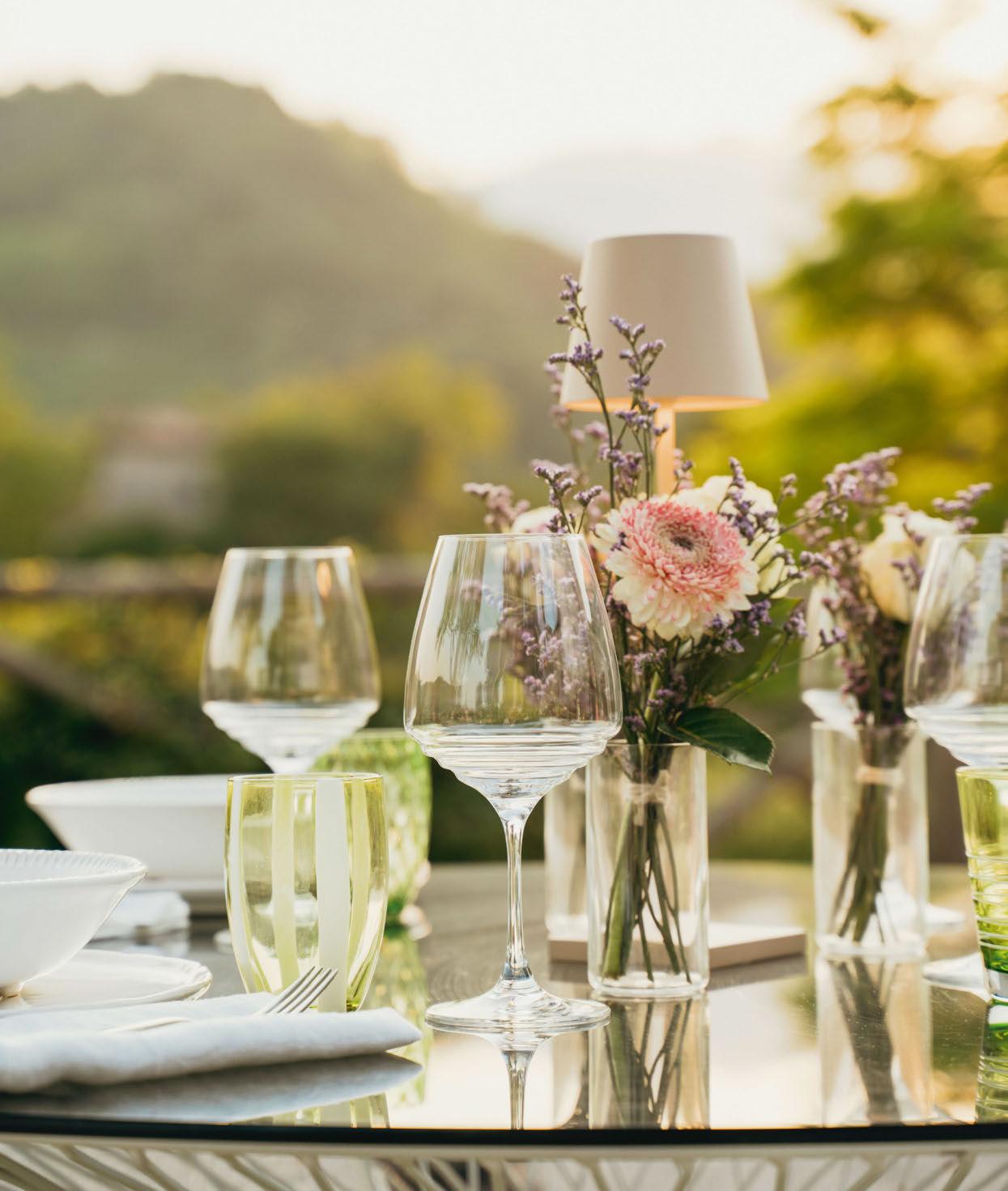
Supper's annual tableware guide equips decision-makers with key information from market-leading suppliers, assisting in the specification process for new hospitality projects worldwide.
Courtesy of Zafferano

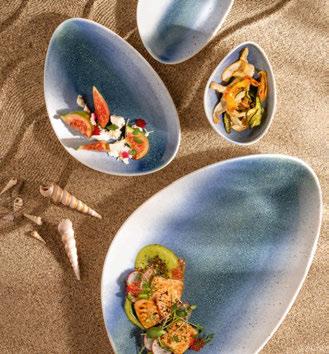

Amefa specialises in the marketing and distribution of cutlery and stainless-steel products for both the table and the kitchen. The company's mission is to act as a valued, reliable partner providing the benefits of a global organisation while offering the speed, commitment, flexibility and personal touch of a small business. The Amefa Group currently has seven subsidiaries globally, spread across The Netherlands, USA, Germany, France, UK, Poland and Hong Kong. Through these international touchpoints, it is able to export to different countries worldwide, meeting the needs of both the hospitality and retail sector. Amefa recognises the importance of social responsibility and is committed to improving working conditions within its global supply chain. As such, the Amefa head office has been a member of the Business Social Compliance Initiative – a Foreign Trade Association scheme – for more than 10 years.
Ariane Fine Porcelain
Ariane Fine Porcelain's successful combination of professional experience, creativity, unparalleled technical know-how and attention to finesse has made the company a leader in the international porcelain tableware industry. Through its state-of-theart production facility in India, its advanced technical capabilities and creative team of experts, the organisation has crafted a reputation as a supplier of durable, high-quality dinnerware pieces and collections, each designed with a range of premium hospitality, catering and food and beverage establishments in mind and with a focus on premium raw materials like kaolin, quartz and feldspar. Created in 2014 by a group of partners with countless years of experience in manufacturing and distributing porcelain tableware, Ariane Fine Porcelain deploys an easy reach distribution strategy that comprises strategic tie-ups with leading hotel suppliers and industry players from all over the world.
IN A BITE
Collections: Metropole, Drift, Jewel
Projects: Raffles, Jeddah; The Royal Senses Resort, Crete; The Peninsula, New York Trade Shows: Ambiente, Host Milano, NRA
Contact: Suzanne Muller Sales & Marketing sales@amefa.com www.amefa.com
IN A BITE
Collections: Eclipse, Lir, Orba, Privilege, Mohenjo Daro, Iris Grey
Clients: Raffles, JW Marriott, Le Meridien, Four Points by Sheraton, W Hotels, Marriott, Hilton, Hyatt, Accor, Wyndham, ITC Hotels
Trade Shows: Ambiente, Host Milano, NRA, AAHAR
Contact: Sunny Malesha Business Strategist sunny@umbertoceramics.com arianefineporcelain.com
BHS Tabletop is a heritage company and manufacturer and supplier of professional, functional and inspiring tableware, thanks to its brands Bauscher, Schönwald, Playground and Heart & Soul. Its stylish collections elevate culinary experiences across the hospitality sector, spanning restaurant, hotel, travel business or canteen environments. BHS' vast variety of collections and brands covers a broad spectrum of requirements. When working on new projects or concepts, the business collaborates closely with clients and is happy to include mood boards, renderings or additional input to tailor-make specific proposals. In addition to the ranges in its catalogues, BHS also provides customised decorations that perfectly match a range of individual interiors. Since February 2012, the company has been certified in compliance with the international standards for environmental management and energy management.
IN A BITE
Collections: Purity, Companion, Perfect Match, Embrace
Trade Shows: Ambiente, Host Milano, NRA
Contact: Alexander Fischer
Director National Sales
alexander.fischer@bhs-tabletop.de Taner Selcik
Director International Sales taner.selcik@bhs-tabletop.de www.bhs-tableware.com
102
BHS
Amefa
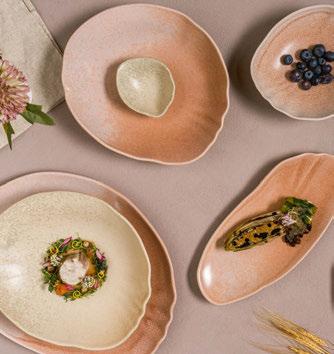

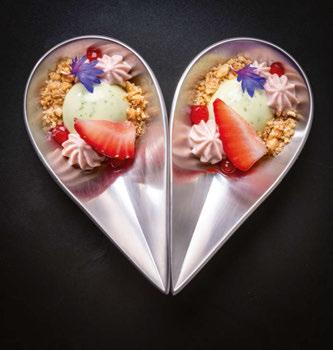
Bonna entered the gastronomy sector as the new-gen representative of Kar Porcelain, whose roots stretch back to 1983. Passionately dedicated to enhancing culinary experiences with a strong commitment to premium product performance, authentic design and sustainable practices, its goal is to provide the best possible accompaniment for a rich gastronomic journey that contributes to the overall wellbeing of the environment and society – which in turn promotes sustainable economic growth. The company provides a wide range of high-quality porcelain, vitrified (stoneware) and other tableware collections made possible and brought to life by the newest technology. It is committed to uplifting joyful hospitality moments together with trend-setters and opinion leaders, regularly collaborating with a wide range of communities to distinctively tailor gastronomic experiences from a broader perspective.
Burleigh
Burleigh celebrates the best of British ceramic design and craft manufacturing. The heritage company is committed to producing authentic, individual and timeless tableware using traditional skills and techniques and the highest-quality raw materials. Leaning on a 170-year legacy and a rich and intricate history, its dedicated team acts as a guardian of craftsmanship. Burleigh production requires skills and experience that can’t be found anywhere else in the world: its famous tissue transfer decoration, for example, uses engraved copper rollers to bring its iconic patterns to life and it is the last pottery in the world to use the traditional and timeless skill of underglaze tissue printing, which is an English process dating back over 200 years. Recognised globally for the quality of its fine craftsmanship and traditional manufacturing, Burleigh has been proudly making earthenware since 1851, based at Middleport Pottery in Stoke-on-Trent since 1889.
IN A BITE
Collections: Sahara & Blush, Patch, Halo Ocean, Pott Bowl
Projects: Pullman, Zagreb; Four Seasons Astir Palace, Athens; Sheraton Dubrovnik
Riviera Hotel
Trade Shows: Ambiente, Host Milano, Hotel Show Dubai
Contact: Yasemin Yılmaz
Exports Sales Manager yasemin.yilmaz@bonna.com.tr www.bonna.com.tr
IN A BITE
Collections: Green Regal Peacock Collection
Clients: Chiltern Firehouse, The Ned, Gymkhana, Ralph Lauren
Contact: Mark Toy hospitality@burgessandleigh.co.uk www.burleigh.co.uk
Corby Hall, a family-owned business based in Randolph, New Jersey, has supplied the international hospitality industry with high quality flatware, holloware and bright white porcelain dinnerware for the past 40 years. With designs ranging from traditional to contemporary and placed at extremely competitive price points, Corby Hall has the ability to supply all food and beverage outlets associated with a full-service foodservice operation. The company's propriety patterns run the gamut from modern to traditional, with available finishes including mirrored or satin polishes, in addition to silver plate, and its commitment to commercial food service is evidenced by the impressive quality of its high quality stainlesssteel and porcelain products. Its comprehensive global distribution network – coupled with extensive production facilities in Europe and Asia – facilitates a thoroughly seamless service in terms of both opening orders and re-supply.
IN A BITE
Collections: Onda Dinnerware, Raio Dinnerware, Bolero Flatware
Projects: Omni Dallas Hotel, Dallas; Atlantis The Palm; The Breakers, Palm Beach
Trade Shows: Arabian Travel Market, Chef to Chef, HD Expo
Contact: Mark Riley
National Sales Manager mark@corbyhall.com www.corbyhall.com
103
Bonna
HEAD OF THE TABLE
Corby Hall
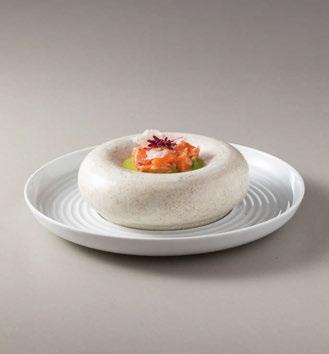
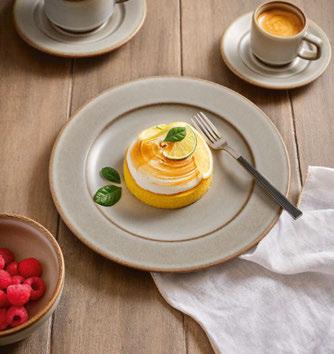

Heritage brand Costa Nova specialises in crafting host-premium, eco-friendly collections that blend sustainability with innovative design. The company's stoneware products are ethically manufactured in its modern and environmentally friendly factories located in Portugal, and it complements these stoneware pieces with carefully curated collections of flatware, glassware, table linens and other items made from natural or recycled materials such as cork, wood and leather. These are expertly manufactured in Portugal or elsewhere in Europe, ensuring the highest quality and sustainability standards. Costa Nova's choice of materials reinforces the brand's commitment to bringing unique and elegant alternatives to the table while respecting nature. By choosing Costa Nova, hotels, restaurants and hospitality environments worldwide are participating in its commitment to protect the environment.
Costa Verde
Founded in 1992 as one of the more contemporary companies in the sector, Costa Verde's strong ties with Portuguese porcelain distributors quickly turned the brand into a success story. Today, the company is not only rooted firmly in the Portuguese market, but – following more than 30 years of steady growth – also benefits from myriad partnerships that have emerged from marketplaces around the world. The company's constant research, creation and drive for the development of new products means that Costa Verde enjoys a presence across more than 50 locations globally, to the extent that 70% of its revenue now comes from the international market. When it comes to manufacturing though, the brand remains true to its roots; its production unit is located in the district of Aveiro in Portugal, with a covered area of 35,000m2 and an available area of more than 65,000m2
IN A BITE Collections: Âmbar, Resonance, Lagoa, Marrakesh Clients: Six Senses, The Yeatman Hotel, Marriott International, Radisson, Jumeirah Hotels, Mandarin Oriental Hotel Group Trade Shows: Ambiente, EquipHotel, FHA, Maison & Objet, New York Tabletop Show, NRA, Sirha
Contact: Matt Hullfish
VP Sales and General Manager Costa Nova USA matt@casafinaliving.com www.costanovaprofessional.com
IN A BITE Collections: Terra, Raw, Powerful Projects: Mandalay Bay, Las Vegas; Dusit Thani Resort, Guam Trade Shows: Ambiente Contact: Agostinho Silva agostinho@costa-verde.com www.pro.costa-verde.com
Elia International has been supplying quality products to the professional food service industry for several decades and continues to bring consistently versatile products to the market. With a sharp focus on ergonomic design and elegant craftsmanship, its tabletop products are renowned throughout the UK and international hospitality and retail industries. Elia is committed to using original ideas, designing in-house and working alongside expert designers, and the brand constantly pursues beauty in form and quality of finish with an unwavering dedication to functionality. Each product has its own unique story: from striking cutlery and bone china to fine crystal glassware, stylish barware and beverageware items, every Elia piece has been meticulously crafted to offer luxury without compromising on durability. From everyday dining to high-end gastronomy, stadiums to boutique hotels, there is a product and range from Elia to fit any environment.
IN A BITE
Collections: Flow Cutlery, Siena Cutlery, Miravell Chinaware, Motive Glassware
Projects: Conrad London St James
Trade Shows: Ambiente, HRC
Contact: Adam Walker Sales Manager UK adam@elia.co.uk www.elia.co.uk
104
Costa Nova
Elia International

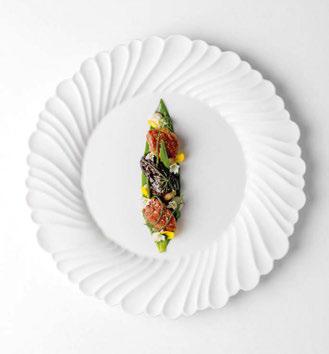

Fine Dining & Living
Fine Dining & Living – which was previously known as Aerts NV, a traditional wholesaler – comprises a diverse portfolio of seven distinctive brands, each placing a dedicated focus on either the hospitality or retail industry. Within the hospitality sector, four brands stand out: Fine2Dine, Chic, BonBistro and Wood & Food. These brands deliver high-quality tableware to restaurants, hotels and other catering establishments that aspire to create an exquisite dining experience for guests. Fine Dining & Living's primary goal is to provide customers with an unparalleled journey through the world of fine dining and living, and the company currently sells its products in approximately 50 countries globally, and aims to continue to expand further internationally in the future. By offering a distinguished range of brands, the company enables customers to choose from a variety of styles, products and services that perfectly align with their individual needs and preferences.
IN A BITE
Collections: (Fine2Dine) Structo Galaxy, Filo Opal, Ecovitra Projects: Rosewood, Doha; Park Hyatt, Dubai; The RitzCarlton, Mumbai; Raffles Jeddah
Trade Shows: Ambiente, EquipHotel, FHA, Host Milano, Internorga, Maison & Objet, Sirha
Contact: Lynne Verrydt Marketing & Events matthias.vandeneynde@finedl.eu www.finediningandliving.eu
Founded in 2012, Goodfellow & Goodfellow has become a go-to distributor of creative tableware designs and supply solutions. Originally serving the UK market exclusively, its consultative approach to concept-driven projects and cheffocused products has led to demand for its services across Europe and the Middle East. With an impressive portfolio of brands on offer – including Hering Berlin, Jacques Pergay, Narumi, Montgolfier, Figgjo, Costa Nova and Studio Mattes – Goodfellow & Goodfellow is capable of crafting unique tableware presentations to suit any global cuisine. Collaborating with clients' designers, brand consultants, F&B managers and operational teams, it can bring concept visions to life, delivering everything from individual pieces to complete hotel F&B concepts, whilst also working with craft producers to design its own bespoke tableware creations.
ID Fine
ID Fine is a porcelain manufacturer with a rich history dating back to 1972. A family-owned company with a deep appreciation for the art and craft of porcelain tableware, it is committed to bringing that passion to the horeca industry, with the help of its team of experienced professionals that is dedicated to creating high-quality, stylish tableware that elevates the dining experience. The company is proud to be part of a long tradition of porcelain manufacturers, understands the importance of respecting the old brands that have paved the way in the industry, and is committed to upholding the highest standards of quality and craftsmanship, while also bringing a fresh perspective and innovative approach to its products. ID Fine hopes to inspire customers with its mix of tradition and innovation. From classic, timeless pieces to modern, on-trend designs, the brand has something for every taste and occasion.
IN A BITE
Collections: Studio Mattes, Narumi, Costa Nova Projects: The Peninsula, London; Raffles London at The OWO; Dovetale at 1 Hotel Mayfair, London
Contact: Valda Goodfellow Managing Director valda.goodfellow@goodf.co.uk www.goodf.co.uk
IN A BITE
Collections: Reckless, Modest Collections, Roots, Surf Trade Shows: Ambiente, Host Milano, NRA, Abastur, To The Table
Contact: Reha Tavil, Vice President reha.tavil@idfine.com.tr idfine.com.tr
105
Goodfellow & Goodfellow
HEAD OF THE TABLE


John Jenkins
John Jenkins is one of the UK's leading designers and suppliers of crystal and glass for the high-end hospitality industry. Founded in 1901, its aim is to design and supply stylish glassware, which is practical in service and complements both the wine and table. The company keeps in stock a large range of both handmade and machine-made glassware, including wine glasses, cocktail glasses and tumblers, which are available for immediate delivery. Its in-house design department also creates exclusive patterns of handmade glassware to the specific requirement of many of its hospitality clients, which include luxury hotels, fine-dining restaurants and world-class bars. The brand also has showrooms in New York, with the US market served by its distribution centre in New Jersey. Each pattern within its glassware portfolio benefits from the latest advances in glassmaking technology, which have enhanced the clarity, durability and scratch-resistance of the glass.
Jono Pandolfi Designs
For 20 years, the prestige US brand Jono Pandolfi has been designing high quality ceramic dinnerware for some of the world's most illustrious restaurants and hotels. Each customisable piece is specifically designed for maximum durability, and meeting the requirements of professional chefs and high-volume kitchens remains the priority. At the company’s light-filled studio in Union City, New Jersey, a team of ceramicists produces each piece by hand, through an intricate process of more than 16 steps, including pugging, slab rolling, smoothing, jiggering, trimming, glazing, glaze wiping and firing. Over the past two years, Jono Pandolfi has doubled its production capacity, cutting lead times in half without compromising on either quality or craftsmanship. Visit the brand's website to explore quick-ship options via the Pro Shop or to request a hospitality product catalogue or quote.

Established in 2017, Mesa Ceramics is a vibrant Portuguese brand specialising in creating stylish, high-quality fine stoneware products. Driven by a dedication to excellence in production and service, the company combines deep expertise in ceramic craftsmanship with premium natural resources and state-of-the-art technologies. Focused on the horeca sector, Mesa Ceramics has meticulously crafted tableware that exudes style, passion and innovation, tailored to resonate with the visions of both partners and customers. This year, it unveiled its award-winning Único range, which uses ID7, a pioneering vitreous body optimised for isostatic pressing. At Mesa Ceramics, sustainability is a priority: through the application of single-firing and digital-printing technology, it reduces raw material consumption, minimises pollution and decreases energy costs. Committed to environmental and human resource responsibility, Mesa Ceramics aspires to be an environmentally conscious entity.
IN A BITE
Collections: Starr, Havana, Casablanca
Projects: The Ritz, London; The Connaught, London; The Savoy, London Trade Shows: Atlanta Gift Show, New York Tabletop Show
Contact: Lisa Gibson-Keynes Design Director lisa.gibson-keynes@johnjenkins.co.uk www.johnjenkins.co.uk
IN A BITE
Collections: Cafe, Coupe, Square Sided
Projects: Frenchette Bakery at The Whitney, New York; Ojai Valley Inn, California; 1 Hotels, Four Seasons Hotels & Resorts, Celebrity Cruises Trade Shows: NRA Contact: Michael Russo and Nathalie Burgos hospitality@jonopandolfi.com www.jonopandolfi.com/supper
IN A BITE
Collections: Único, Uno, Urban, Natura
Clientts: PortoBay Hotels & Resorts, Portugal; Hilton, Madrid; The WB Abu Dhabi, Curio Collection by Hilton, UAE Trade Shows: Ambiente, Host Milano, NRA
Contact: Francisco Braga, CEO offers@mesa-ceramics.pt www.mesaceramicshotel.com
106
Mesa Ceramics


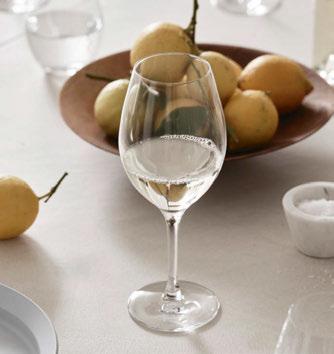
MyGlassStudio
MyGlassStudio specialises in designing bespoke solutions across dinnerware, table accessories, serveware and room amenity presentations for the food service industry. With three extensive libraries comprising a total of 1,800 shapes, 170 colours and 200 patterns, the company is able to meet the needs of its clients precisely, providing personal and exclusive concepts for a variety of commercial and hospitality requirements. The brand uses a wide range of materials across its collections, with metal, brass, leather, wood and stone or marble all featuring throughout. As a boutique factory, MyGlassStudio is able to continually innovate and respond to the needs of the luxury hospitality market. It has a presence in more than 140 countries, and its primary goal is to deliver memorable experiences for guests. Over the past 17 years it has implemented numerous hotel opening projects and it currently maintains procurement contracts with major hotel chains.
IN A BITE Collections: Bespoke dinnerware, tableware and serveware, including Afternoon Tea Stands Assortment and the Limestone Collection Projects: One&Only Aesthesis, Athens; One&Only, One Za'abeel; W, Sydney Trade Shows: Ambiente, Maison & Objet, NRA
Contact: Margarita Paschali Sales & Marketing margarita@myglassstudio.com www.myglassstudio.com
Istanbul-based global design brand Nude is the creator of contemporary glassware for modern living. Each collection is conceived with simplicity in mind, designed to marry form and function for modern day entertainment. In accordance with its ethos that ‘simple is beautiful’, the global brand creates and manufactures crystalline glassware, handcrafted decorative objects, statement tableware and lighting, with its extensive offering focusing on handmade, innovative design. Nude's portfolio of glassware is designed by renowned international talents, and the brand regularly develops dynamic collaborations with a wide roster of artists and creatives. The company became the Sisecam Group's first contemporary design brand in 2014, benefitting from more than 85 years of tradition, wisdom and expertise thanks to its parent group, which was established in 1935.
IN A BITE Collections: Stem Zero, Round Up, Savage Projects: London Hilton Park Lane; NoMad London; ME London Trade Shows: Ambiente, Atlanta Market, Design Shanghai, New York Tabletop Show Contact: Ben Tearall Commercial Director btearall@utopia-tableware.com www.nudeglass.com
Orrefors offers the epitome of elegance and craftsmanship in crystal glassware. With a rich heritage spanning more than 125 years, the company continues to symbolise Swedish design excellence, mixing timeless elegance with unparalleled quality. Blending traditional techniques with modern design sensibilities has allowed the brand to build a reputation for stunning, functional and visually captivating pieces, with each creation showcasing its dedication to craftsmanship. Through partnerships with renowned hotels and restaurants across the US, Orrefors brings its exquisite glassware to tables that seek to elevate the dining experience. Its commitment to excellence is further exemplified through its exclusive partnership with Singer Equipment, a leading restaurant supplier on the East Coast that shares the brand's dedication to quality and service, allowing clients to elevate dining experiences and indulge in the artistry that has captivated connoisseurs around the world.
IN A BITE
Collections: City, More, Beer, Street Projects: The Standard, New York; Millbrook Inn, New York; Hotel Rivington, New York Trade Shows: Atlanta Market, New York Tabletop Show, PPAI Expo, Promotions East, SAAGNY, Shoppe Object
Contact: Donna Nardella Corporate Sales Director donna@orrefors.us www.orrefors.us
107
Orrefors
HEAD OF THE TABLE
Nude Glass
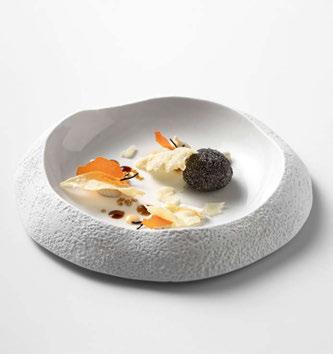
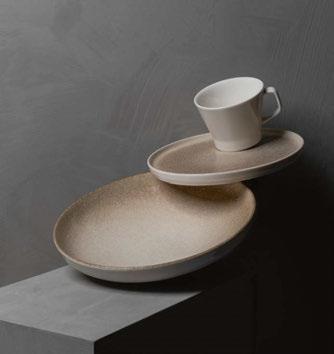

Pordamsa
Pordamsa is a trend-setting Spanish porcelain and glass manufacturer known for its high level of innovative design in an ever-changing global marketplace. Founded in 1975, the company creates exceptional articles and each piece is unique thanks to its traditional manufacturing process. At Pordamsa, the design team is fascinated by the possibility of being able to represent an idea through craftsmanship. The origin of each piece is born from nature, organic shapes and the imagination, to achieve extraordinary and timeless pieces adapted to the needs of each culinary proposal. Pordamsa's designs are currently being used to accompany the creations of some of the most eminent chefs in the hospitality industry, in prestigious finedining restaurants all over the world. The company specialises in offering solutions for the most demanding hotel design projects, both aesthetically and functionally.
Porland
Pioli, an avant-garde imprint of the renowned Porland porcelain company, heralds a new chapter in the realm of hospitality dining. Focused completely on the horeca sector, the brand embodies contemporary dynamism and innovative flair, offering a product range designed to elevate chefs' passion and creativity to new heights. The brand has embarked on a journey to revolutionise the culinary arts, aiming to become a trailblazer in the field. Set apart by the quality of its durability and edge chip resistance (plus a five-year edge chip warranty), Pioli is the preferred choice for professionals, boasting a resilient structure and mechanical strength. Each product serves as an ideal platform for chefs to present their dishes as artistic masterpieces, enhancing the ambiance and value of the setting. Creative, robust and durable, Pioli is the perfect artistic partner, ensuring an unforgettable experience for guests and taking hosting experiences to new levels.
IN A BITE
Collections: Marea, Roca, Taffoni, Salina Trade Shows: Ambiente, Host Milano, Sirha Contact: pordamsa@pordamsa.org www.pordamsa.com
IN A BITE
Pioli Collections: Prisma, Cortado, Zenit Trade Shows: Ambiente, EquipHotel, FHA, NRA Contact: sales@pioli.co www.pioli.co
Since 1955, Robert Welch Designs has been the standard-bearer for stainless-steel cutlery, barware and holloware within the international hospitality industry. The quintessentially British brand specialises in producing timeless products in high quality 18/10 stainless steel. The exquisitely designed cutlery is available in a variety of finishes and can be found on land, sea and air. As Robert Welch Designs prepares to celebrate its 70th anniversary in 2025, it has launched four new cutlery designs capable of elevating any table setting around the world. A simple pricing structure for each of the cutlery collections – amounting to more than 40 designs – makes it easy to select the right product and align with budgets. More than four million items are held in stock to ensure a seamless supply (and re-supply) with products packed and ready for despatch within 10 days. The company prides itself on offering a lifetime guarantee of 25 years on all its stainless-steel products.
IN A BITE
Collections: Armscote Bead, Radford, Kemble Texture
Clients: Five-star restaurants, hotels, cruise ships and international airlines Trade Shows: Ambiente, Host Milano, NRA Contact: Jurgen Bresseel
International Sales Manager jbresseel@robertwelch.com www.robertwelch.com
108
Robert Welch Designs
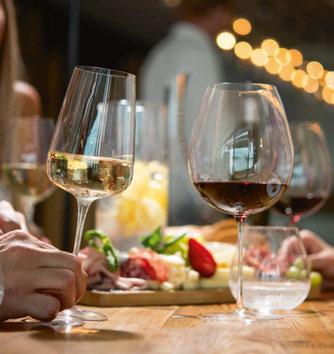
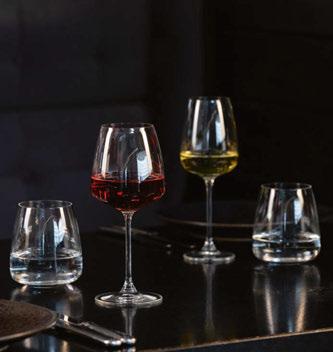
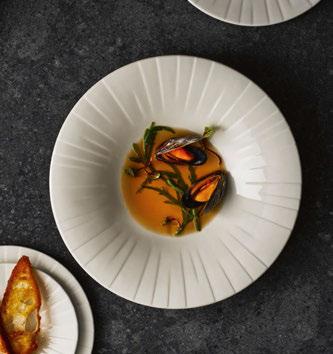
Rona 2Serve
Having separated product design and manufacturing for products used in hospitality environments from products for domestic use, Rona deals with the entire catering sector as it really is – with all its specific quirks, attention to detail and special demands. It believes in cultivating symbiotic, mutually beneficial long-term partnerships. This is how, more than 20 years ago, the company's concept of a professional crystalline range made specifically for the catering industry was born. The complete professional collection is continuously available from a large logistics centre in user-friendly quantities and sample shipments and the company guarantees subsequent availability of goods for up to two years after their retirement from the standard range. Uncompromising quality, professional logistics services and partner care are an imperative part of the brand's philosophy – hence the Rona 2Serve logo being laser etched into each of its horeca products.
Royal Leerdam
Royal Leerdam is part of Leerdam Crisal Glass, one of the largest glass tableware manufacturers in Europe. The brand has been designing and manufacturing glassware for the hospitality industry for 145 years, and is known for its powerful combination of elegant design and functional details. Its sense of quality adds value to the overall image of restaurants, hotels, banqueting events, catering establishments and bars and its collections offer glassware for different purposes and occasions. The brand is dedicated to creating enjoyable glassware for every event, while remaining conscious of sustainability: this philosophy lies at the heart of its processes. The versatility of the various lightweight ranges and the broad spectrum of product lines that will remain in stock for years have earned Royal Leerdam the reputation of a reliable partner in the hospitality industry.
Steelite International
Steelite International is the leading designer, marketer, manufacturer and supplier of award-winning tabletop, buffet and lighting solutions for the global hospitality industry. Thanks to its dual headquarters in New Castle, Pennsylvania, and StokeOn-Trent in the UK, the company has been servicing more than 140 countries for longer than 100 years. Steelite also boasts a 500,000ft2 manufacturing facility, in addition to running 12 showrooms worldwide. Its core brands include some of the biggest names in the sector, such as Steelite Distinction –whose Alina range blends the simplicity, linearity and restraint of Japanese design with an easy-going, approachable and casual style that embodies the Scandinavian way of life – and the heritage brand William Edwards. The company is committed to providing the best in functionality and design, while minimising the effect on the environment.
IN A BITE
Collections: Diverto, Linea
Umana, Mode, Edge
Projects: San Domenico Palace, Taormina, A Four Seasons Hotel; Sheraton Grand, Dubai; The Ritz-Carlton, Hawaii
Trade Shows: Ambiente, Host Milano, NRA, FHA Singapore
Contact: Tomáš Hlavatý Horeca Sales Manager hlavaty@rona.sk www.rona.glass
IN A BITE
Collections: Experts' Collection, Golden Collection, Desserts & Appetizers, Special Spirits Collection, Special Cocktails Collection
Trade Shows: Ambiente, Host Milano
Contact: Marketing info@royalleerdam.com www.foodservice.royalleerdam.com
IN A BITE
Brands: Alina, Off Grid Studio, Rene Ozorio, William Edwards
Projects: The Lana, Dubai; The Goodtime Hotel, Miami; The Langham, Chicago; The Langham, London; Rosewood
Trade Shows: Ambiente, Host Milano, NRA, Sirha
Contact: Tim Harper
SVP Sales and Marketing UKI & MEA: tharper@steelite.com www.steelite.com
109
HEAD OF THE TABLE

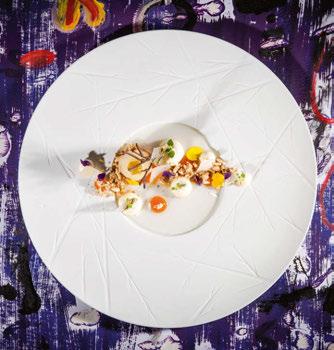

Utopia
Utopia Tableware is the UK’s largest supplier of tableware to the hospitality and B2B sectors, and exports its products through a network of international distributors. Regular product launches ensure that the company is always able to meet demand for the latest trends, as well as offering unrivalled personalisation services, including bespoke designs and decorations. Utopia’s extensive portfolio includes cordless LED lamps, glassware, barware, tableware, cutlery and kitchen essentials. Each product combines aesthetic appeal, functionality and durability and is crafted with meticulous attention to detail. Sustainability is one of Utopia’s core principles; the company is committed to environmentally responsible practices, from sourcing raw materials to implementing energy efficient production processes and stringent recycling programmes. With a focus on delivering exceptional customer service, its distribution systems and networks guarantee timely delivery and support.
Vista Alegre Hotelware
The Vista Alegre porcelain factory was first established in 1824, and throughout its history, the brand has always been associated with Portuguese heritage and cultural life. With an unrivalled international reputation, Vista Alegre aims to become the most prestigious brand in the world for tableware, gifts, decoration pieces, porcelain articles for hotels, crystal and glass, maintaining a strong link to design and culture. The company regularly invests in new shapes to meet the needs of the market and works in partnership with renowned chefs and designers to provide innovative products. In designing plates intended for fine dining, Vista Alegre collaborates with those who best know this exceptional universe: the most celebrated chefs, nationally and internationally. This original association has born exquisite pieces that combine the primacy of the Vista Alegre design with the creativity and practicality demanded by the world of haute cuisine.
Zafferano
The Zafferano brand was founded in 2001 with the aim of embellishing and customising living spaces while fully expressing the functionality and aesthetic appeal of Italian design; all in accordance with its philosophy to 'bring joy into everyday life'. As a lifestyle home brand that specialises in a range of products spanning glass and ceramic tableware, indoor and outdoor luminaires and portable lamps, the company transforms ordinary and everyday experiences by championing the principles of Italian style and remaining sensitive to the cultural and natural beauty of the country's heritage – all while respecting master craftsmen and new technologies. The Zafferano brand values are experience, concreteness and curiosity, putting solidity, clarity and a bold propensity for research at the heart of its narrative. Its combination of creativity and quality give its products an extraordinary edge.
IN A BITE
Collections: Nammos, Oregon, Cordless LED Lamps
Projects: Broadwick Soho, London; The Londoner, London; Accor; Stonegate Group Trade Shows: Ambiente, Host Milano, NRA
Contact: Josh Rammell
Marketing Manager
JRammell@utopia-tableware.com www.utopia-tableware.com
IN A BITE
Collections: Essencial, Chef´s Collection, Stoneware Clients: Hilton, Club Med, Intercontinental, Jumeirah, Four Seasons, Iberostar Trade Shows: EquipHotel Paris, Sirha Lyon, Ambiente Frankfurt, Host Milano, NRA Chicago, Hostelco Barcelona
Contact: Denise Madeira Marketing Manager Hotelware hotelware@vistaalegre.com hotelware.vistaalegre.com
IN A BITE
Collections: Poldina cordless lamp, Bilia tumblers, Esperienze wine glasses, Veneziano cocktail glasses Trade Shows: Ambiente, EquipHotel Paris, HIP, Hotel Show Dubai, HRC, Maison & Objet, Milano Home, Sirha
Contact: Paolo De Osti
Sales Director p_deosti@zafferanoitalia.com www.zafferanoitalia.com
HEAD OF THE TABLE 110
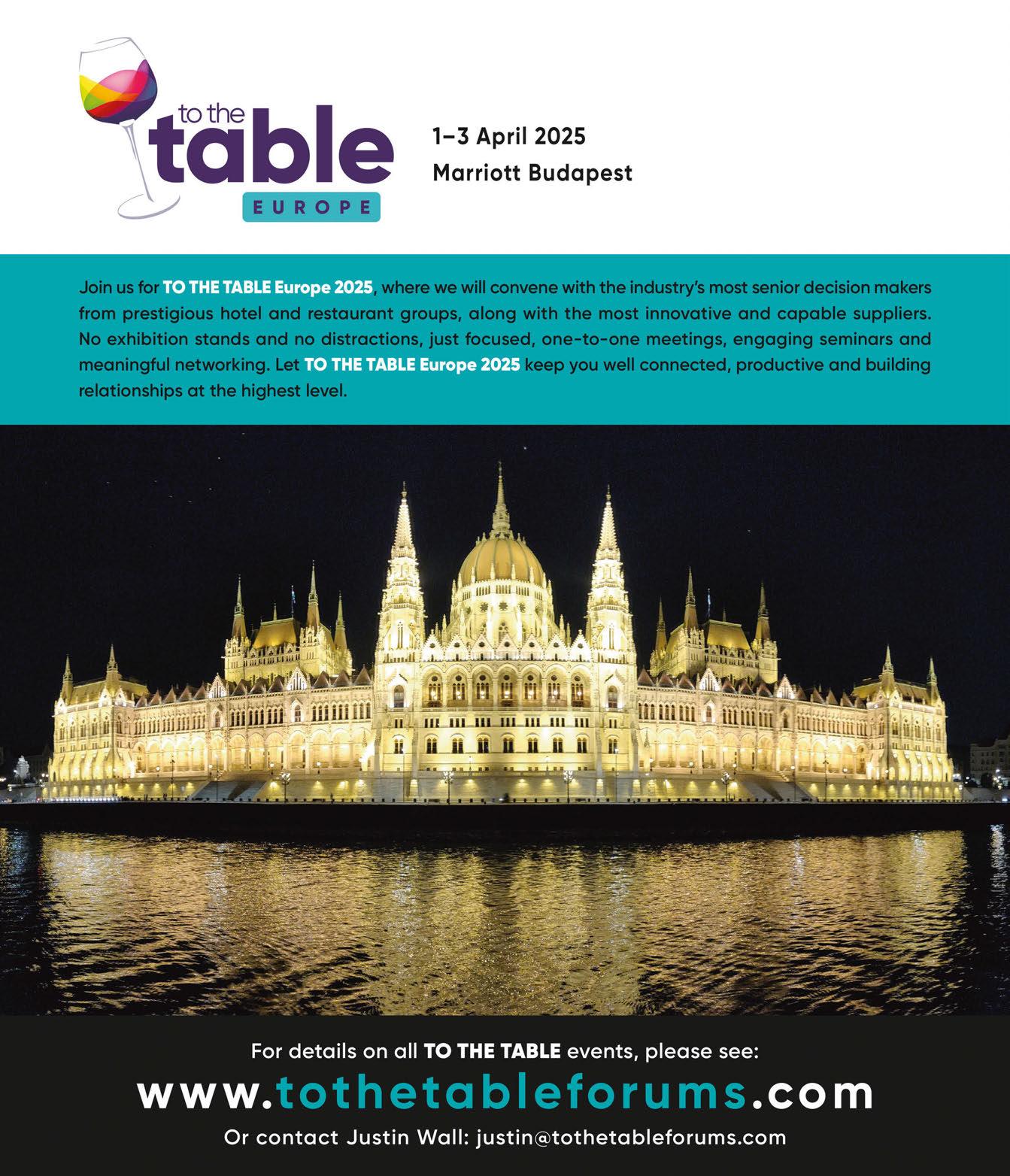
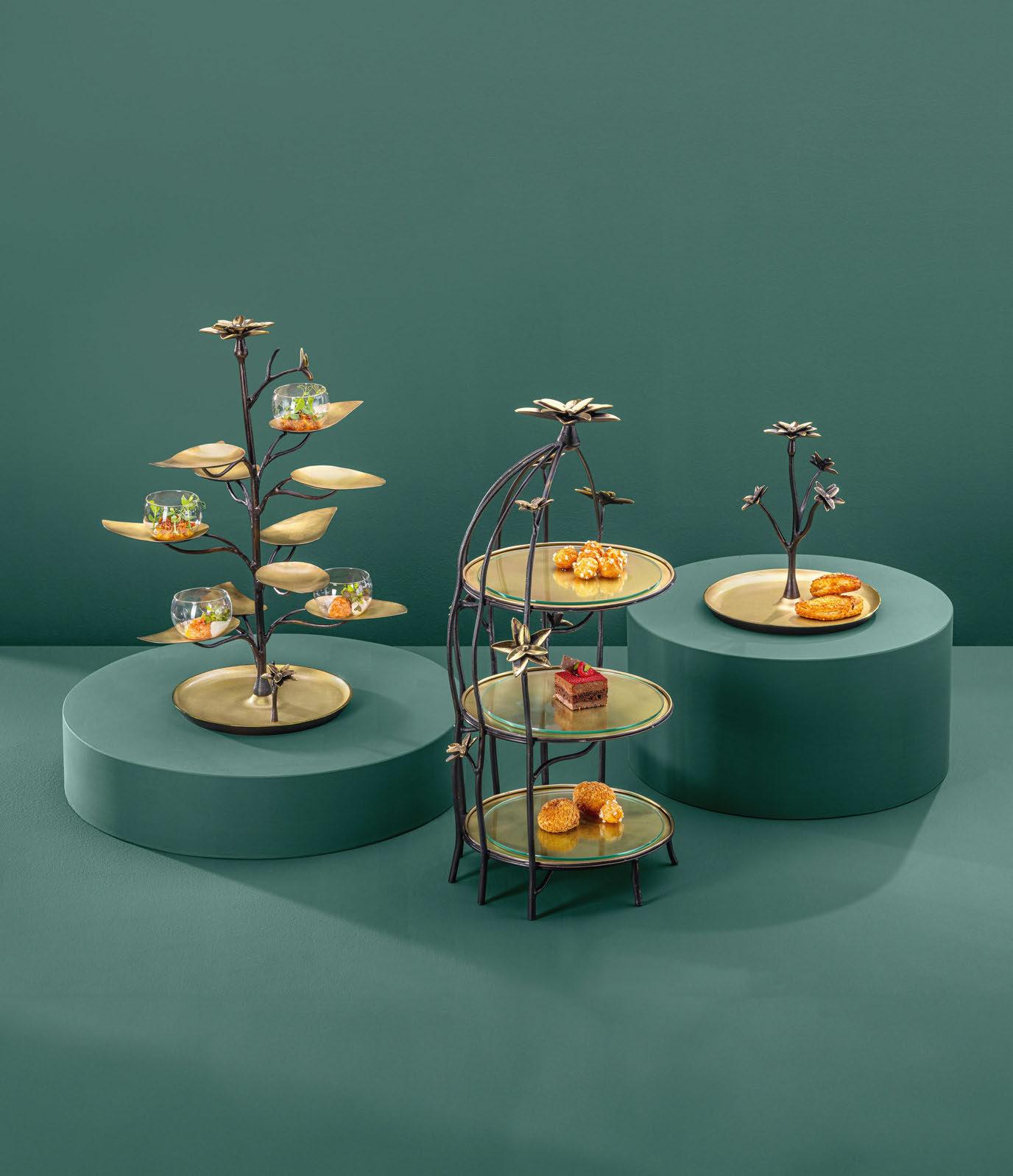

FLEUR DÉCO - exclusive novelty 2024 WWW.ZIEHER.COM
ADVERTISING INDEX ISSUE 37
113
Altamura Distilleries Vodka 116 Amefa 014 Ariane 045 BHS 029 Bonna 115 Burleigh 017 Champagne Lallier 010-011 Corby Hall 002 Costa Nova 043 Costa Verde 053 Craster 100 Elia International 077 Fine Dining & Living 073 Goodfellows 018 ID Fine 035 John Jenkins 071 Jono Pandofi Designs 021 Mesa 051 MyGlassStudio 039 Nude 061 Orrefors 091 Pernod 006-007 Pernod Sip 088 Pordamsa 074 Porland 012-013 Rewthink 083 Robert Welch 059 Rona 084 Santo Tequila 087 Steelite 008-009 Ten To One Rum 092 To The Table Europe 111 Utopia 041 Vista Alegre 067 XL Boom 057 Zafferano 005 Zieher 112
The Magic of (G)astronomy
A restaurant and observatory in Thailand reaches for the stars.
Drinking in the view is practically mandatory at Dara, the shimmering restaurant and observatory that recently launched at Thailand’s luxe Anantara Layan Phuket Resort. The elegant venue specialises in constellation-inspired craft cocktails designed to be enjoyed as part of a culinary experience that combines refined Thai classics with a side of stargazing.
Named in honour of the intrepid Andaman seafarers who relied on the night skies for navigation, Dara (which means ‘star’ in Thai) is housed in an expansive building featuring a rooftop observatory deck, custom-built ash dome and Phuket’s most powerful state-of-the-art telescope. Sky Storytellers are on hand to teach guests about the night skies through guided astronomy sessions.
For those that can tear their eyes downwards
to the table, the restaurant’s contemporary twist on Thai cuisine is also visually rewarding: the seasonal menu takes diners on a culinary journey through the Southeast Asian nation, offering reworked classics such as Moohong Phuket, a slow-cooked pork belly seasoned with soy, star anise and cinnamon, and Nam Tok Neua Ko Kun featuring Korat wagyu beef. Head Chef Supakarn Lienpanich’s own family recipes inspired several of the dishes.
An on-site fermentation kitchen, barrel-aged fish sauce cellar, and a verdant herb garden all ensure that the venue is as self-sufficient and as eco-friendly as possible, while the drinks showcase the diversity and quality of Thai ingredients, from milky coconut and grassy pandan to fragrant jasmine and earthy hibiscus. Heavenly indeed.

114
WASHING-UP
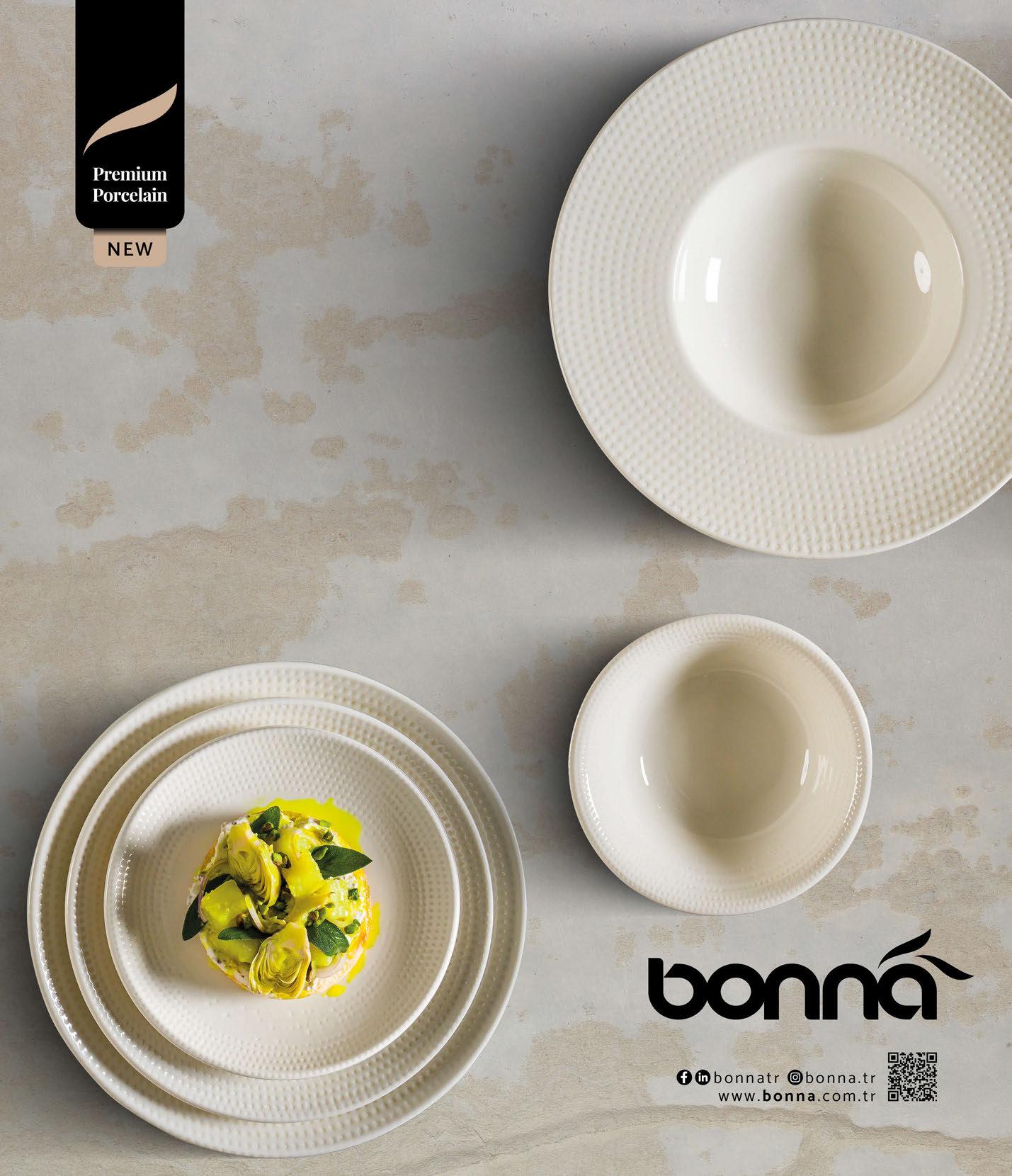

 HOTEL FOOD & DRINK
CAFÉ CARMELLINI – THE FIFTH AVENUE HOTEL • TOM AIKENS • JARA BY MARTÍN BERASATEGUI – THE LANA
HOTEL FOOD & DRINK
CAFÉ CARMELLINI – THE FIFTH AVENUE HOTEL • TOM AIKENS • JARA BY MARTÍN BERASATEGUI – THE LANA















































































































 © Mark Weeks
© Daniel Turbert
Photography/The Stanford Inn
© Mark Weeks
© Daniel Turbert
Photography/The Stanford Inn














































































